Brother 8CAA19 Spread Spectrum Transmitter User Manual MFC 440CN UG US
Brother Industries, Ltd. Spread Spectrum Transmitter MFC 440CN UG US
Brother >
Contents
- 1. User Manual 1
- 2. User Manual 2
- 3. User Manual 3
- 4. User Manual 4
- 5. User Manual 5
User Manual 4
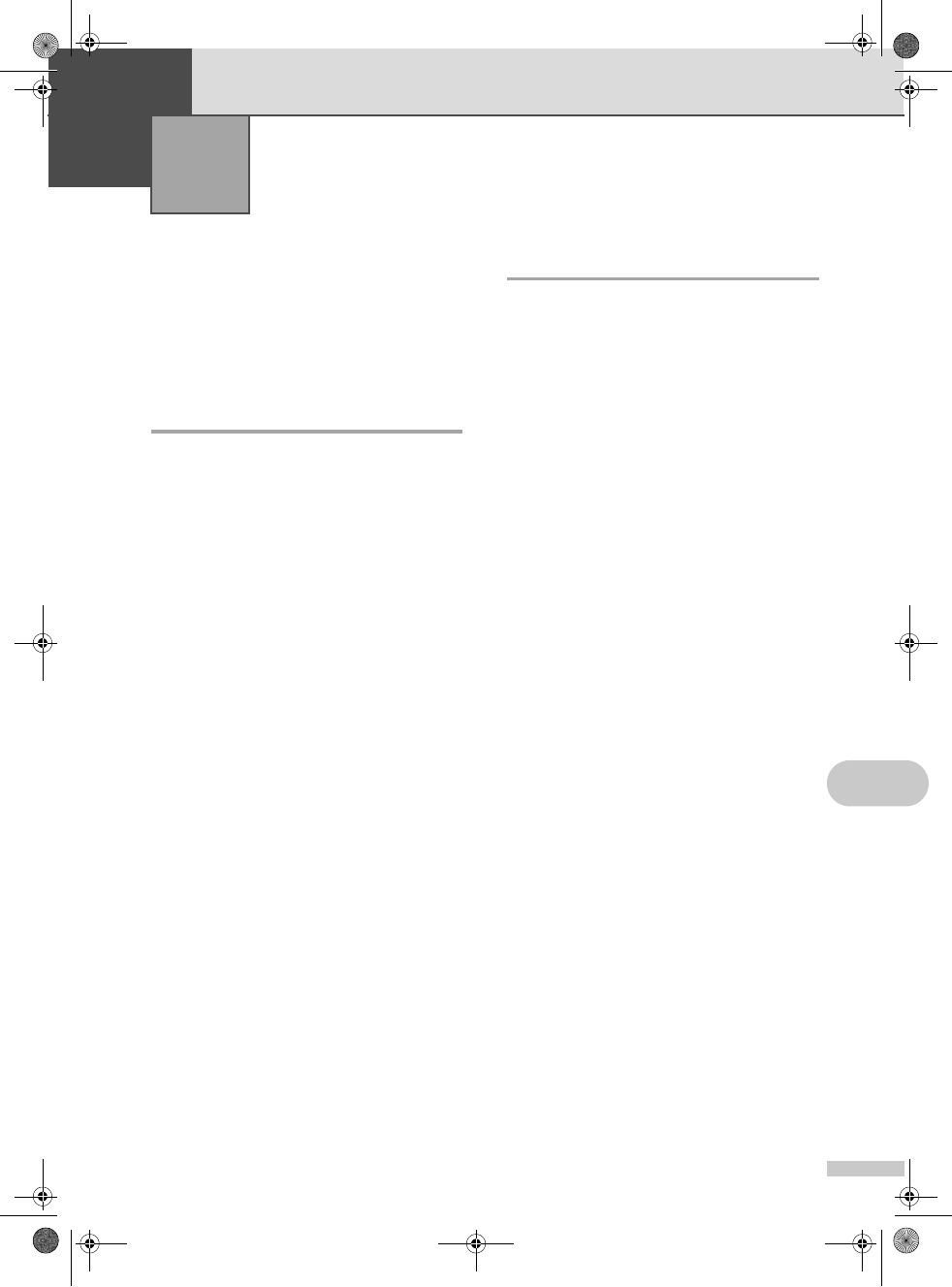
87
11
11
Fax reports 11
You need to set up the Transmission
Verification Report and Journal Period using
the Menu keys.
Transmission Verification
Report 11
You can use the Transmission Verification
Report as proof that you sent a fax. This
report lists the time and date of transmission
and whether the transmission was successful
(OK). If you choose On or On+Image, the
report will print for every fax you send.
If you send a lot of faxes to the same place,
you may need more than the job numbers to
know which faxes you must send again.
Choosing On+Image or Off+Image will print
a section of the fax's first page on the report
to help you remember.
When the Transmission Verification Report is
turned Off or Off+Image, the Report will
only print if there is a transmission error, with
NG in the RESULT column.
aPress Menu.
bPress a or b to choose Fax.
Press OK.
cPress a or b to choose
Report Setting.
Press OK.
dPress a or b to choose
Transmission.
Press OK.
ePress a or b to choose On,On+Image,
Off or Off+Image.
Press OK.
fPress Stop/Exit.
Fax Journal (activity report) 11
You can set the machine to print a journal at
specific intervals (every 50 faxes, 6, 12 or 24
hours, 2 or 7 days). If you set the interval to
Off, you can still print the report by following
the steps on How to print a report on page 88.
The factory setting is Every 50 Faxes.
aPress Menu.
bPress a or b to choose Fax.
Press OK.
cPress a or b to choose
Report Setting.
Press OK.
dPress a or b to choose
Journal Period.
Press OK.
ePress a or b to choose an interval.
Press OK.
(If you choose 7 days, the LCD will ask
you to choose the first day for the 7-day
countdown.)
6, 12, 24 hours, 2 or 7 days
The machine will print the report at
the chosen time and then erase all
jobs from its memory. If the
machine's memory becomes full with
200 jobs before the time you chose
has passed, the machine will print
the Journal early and then erase all
jobs from the memory. If you want an
extra report before it is due to print,
you can print it without erasing the
jobs from the memory.
Every 50 Faxes
The machine will print the Journal
when the machine has stored 50
jobs.
Printing Reports 11
MFC-440CN_UG_US.book Page 87 Thursday, August 10, 2006 6:59 PM
Color:Blac
k
Please see page 40 of 49(labeled 126) and 41 of 49(labeled 127) for FCC manual
statements
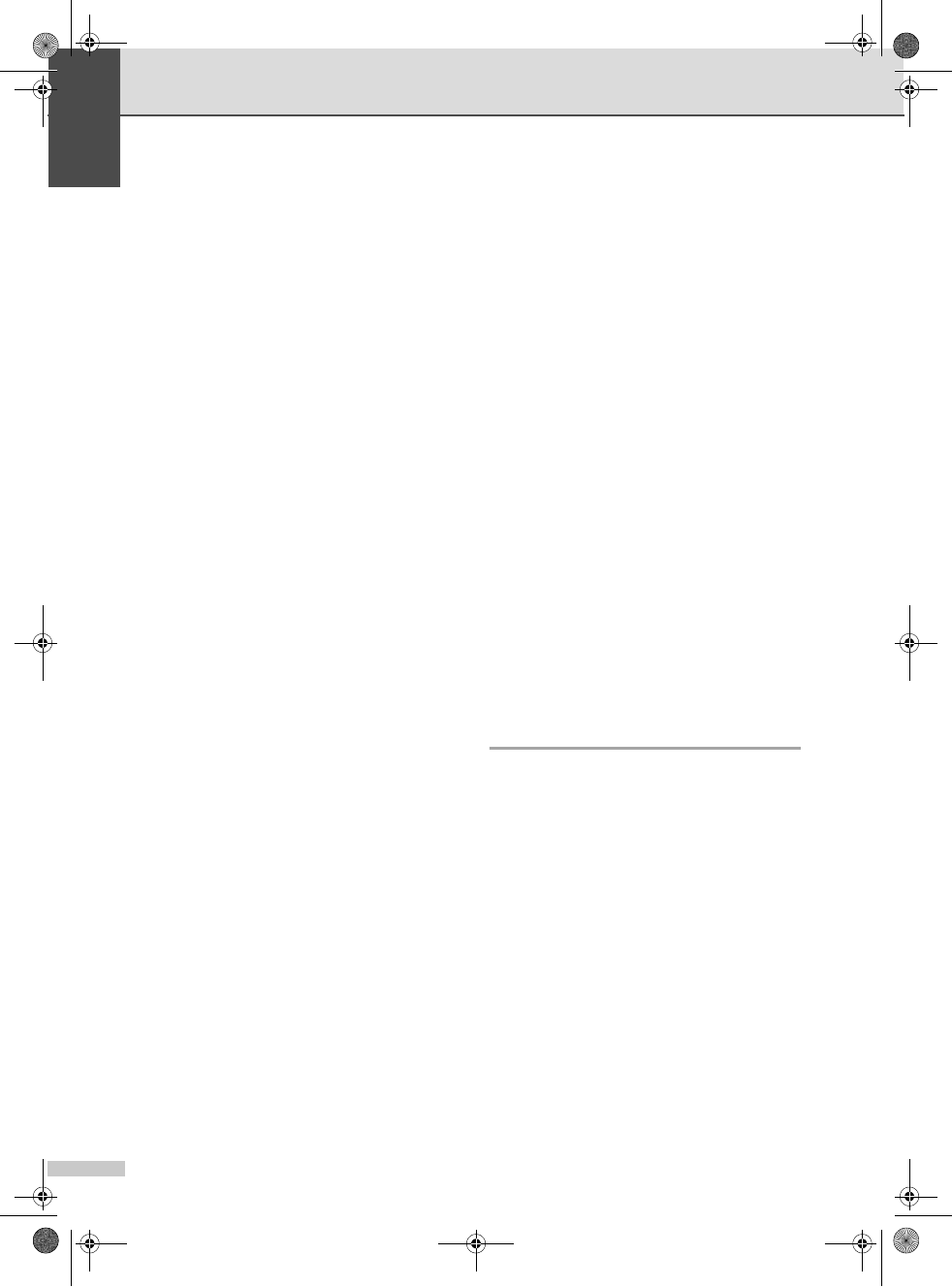
Chapter 11
88
fEnter the time to start printing in 24-hour
format.
Press OK.
(For example: enter 19:45 for 7:45 PM.)
gPress Stop/Exit.
Reports 11
The following reports are available:
Transmission
Prints a Transmission Verification Report
for your last transmission.
Help List
A help list about how to quickly program
your machine.
Quick-Dial
Lists names and numbers stored in the
Speed-Dial memory, in alphabetical or
numerical order.
Fax Journal
Lists information about the last incoming
and outgoing faxes. (TX: Transmit.)
(RX: Receive.)
User Settings
Lists your settings.
Network Config
Lists your Network settings.
How to print a report 11
aPress Menu.
bPress a or b to choose
Print Reports.
Press OK.
cPress a or b to choose the report you
want.
Press OK.
dPress Black Start.
MFC-440CN_UG_US.book Page 88 Thursday, August 10, 2006 6:59 PM
Color:Blac
k
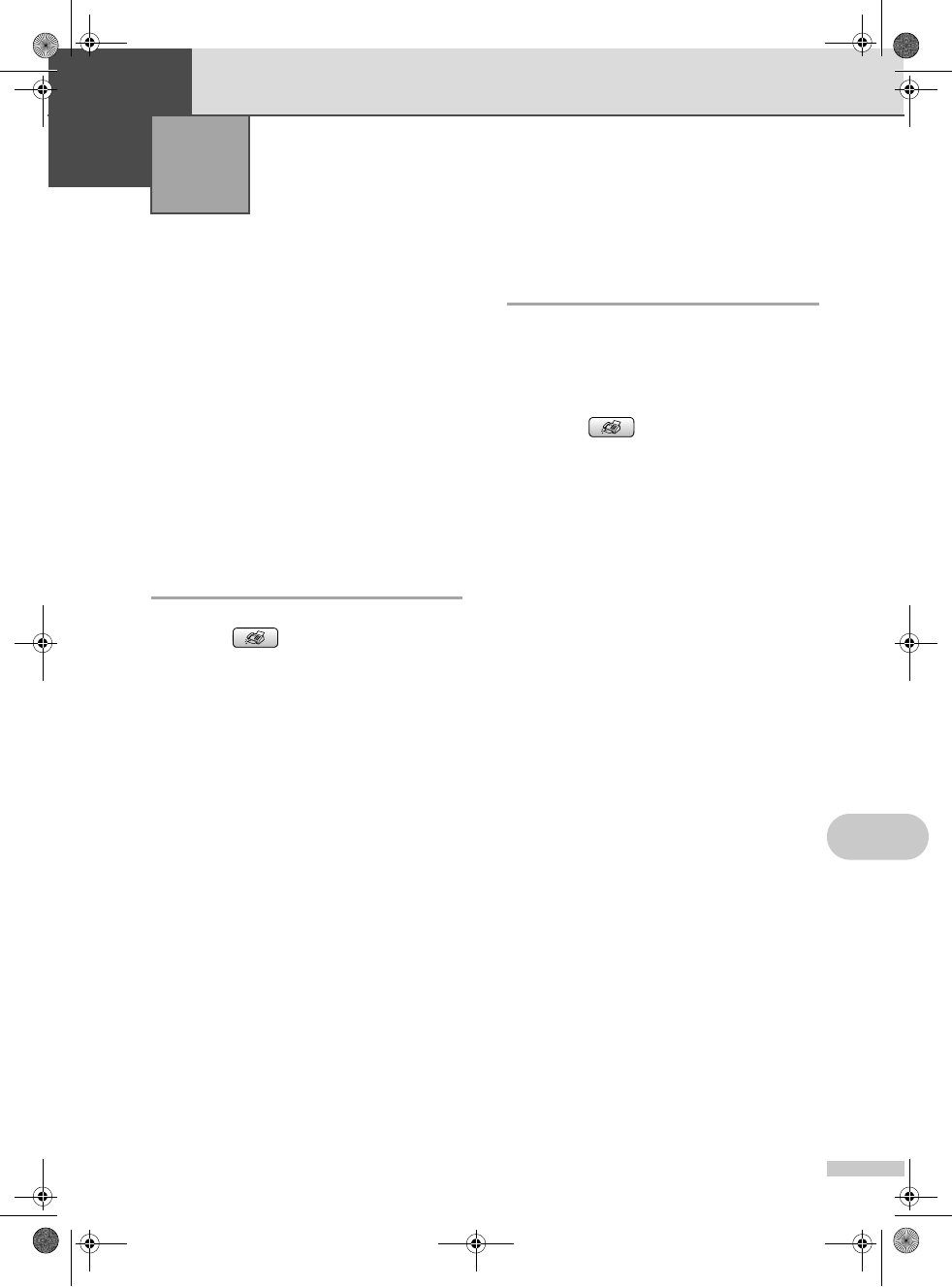
89
12
12
Polling overview 12
Polling lets you set up your machine so other
people can receive faxes from you, but they
pay for the call. It also lets you call somebody
else’s fax machine and receive a fax from it,
so you pay for the call. The polling feature
needs to be set up on both machines for this
to work. Not all fax machines support polling.
Polling receive 12
Polling receive lets you call another fax
machine to receive a fax.
Setup to receive polling 12
aPress (Fax).
bPress a or b to choose Polling RX.
Press OK.
cPress a or b to choose On (or Off).
Press OK.
dEnter the fax number you are polling.
ePress Black Start or Color Start.
The LCD shows Dialing.
Sequential polling
(Black & White only) 12
Sequential polling lets you request
documents from several fax machines in one
operation. Afterwards, a Sequential Polling
Report will be printed.
aPress (Fax).
bPress a or b to choose Polling RX.
Press OK.
cPress a or b to choose On (or Off).
Press OK.
dPress a or b to choose
Broadcasting.
Press OK.
ePress a or b to choose Add Number.
Press OK.
fEnter a number using Speed-Dial, a
Group, or the dial pad.
Press OK.
gRepeat steps e and f for all the fax
numbers you want to poll, and then
press a or b to choose Complete.
Press OK.
hPress Black Start.
The machine polls each number or
Group number in turn for a document.
Press Stop/Exit while the machine is dialing
to cancel the polling process.
To cancel all sequential polling receive jobs,
see Checking and canceling waiting
jobs on page 43.
Polling 12
MFC-440CN_UG_US.book Page 89 Thursday, August 10, 2006 6:59 PM
Color:Blac
k
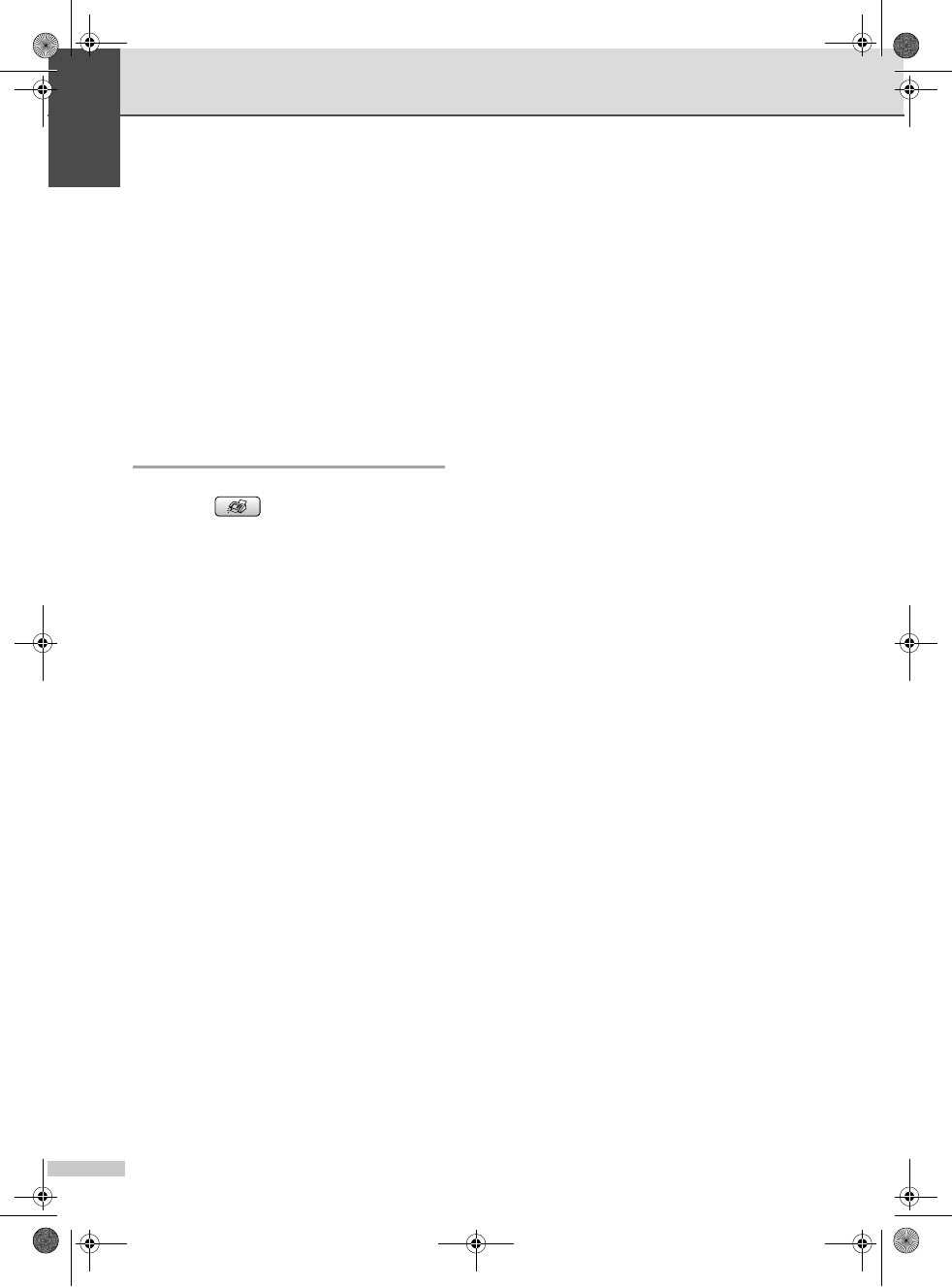
Chapter 12
90
Polled transmit
(Black & White only) 12
Polled transmit lets you set up your machine
to wait with a document so another fax
machine can call and retrieve it.
The document will be stored and can be
retrieved by any other fax machine until you
delete it from the memory. (See Checking
and canceling waiting jobs on page 43.)
Set up for polled transmit 12
aPress (Fax).
bLoad your document.
cPress a or b to choose Polled TX.
Press OK.
dPress a or b to choose On (or Off).
Press OK.
ePress a or b to choose any settings
you want to change.
Press OK.
After each setting is accepted, you can
continue to change more settings.
fPress Black Start.
MFC-440CN_UG_US.book Page 90 Thursday, August 10, 2006 6:59 PM
Color:Blac
k
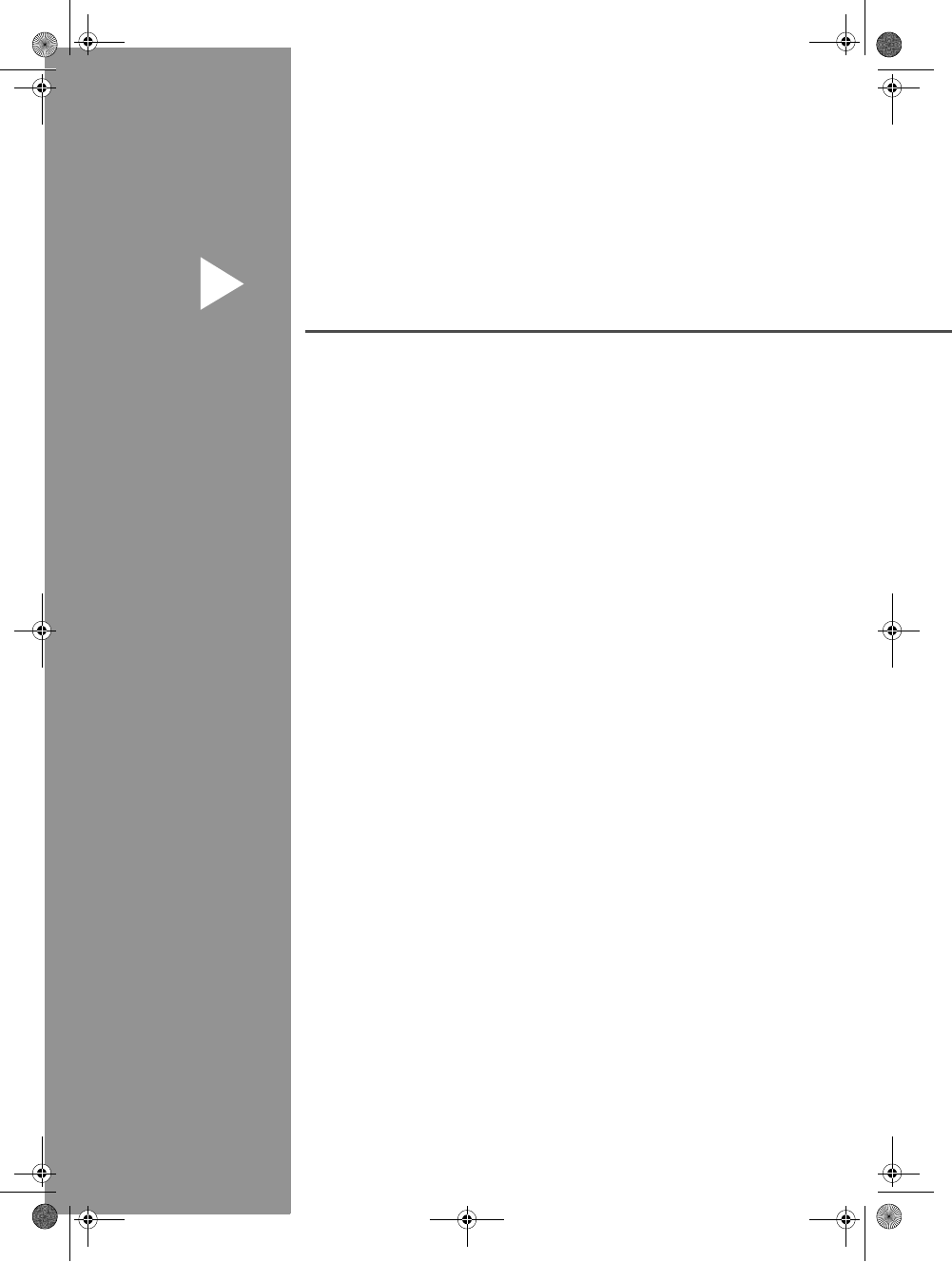
Section III
Copy III
Making copies 92
MFC-440CN_UG_US.book Page 91 Thursday, August 10, 2006 6:59 PM
Color:Blac
k
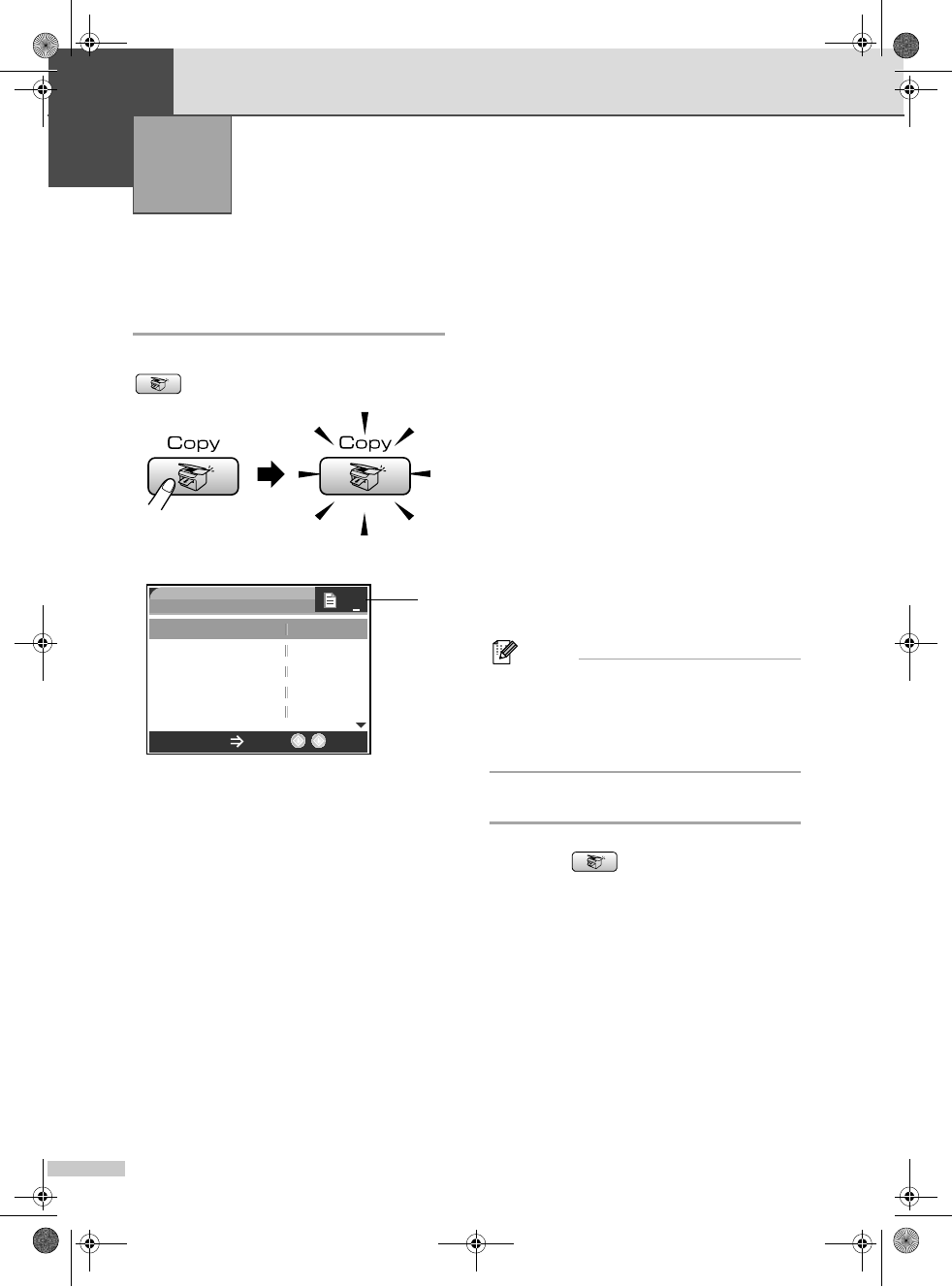
92
13
How to copy 13
Entering Copy mode 13
When you want to make a copy, press
(Copy) to illuminate it in green.
The LCD shows:
1 No of Copies
You can enter the number of copies you want
by using the dial pad.
Press a or b to scroll through the Copy key
options.
Quality (See page 93.)
Enlarge/Reduce (See page 94.)
Paper Type (See page 97.)
Paper Size (See page 97.)
Brightness (See page 96.)
Contrast (See page 96.)
Color Adjust (See page 96.)
Stack/Sort (See page 95.)
Page Layout (See page 94.)
Set New Default (See page 97.)
Factory Reset (See page 97.)
When the option you want is highlighted,
press OK.
Note
The default setting is Fax mode. You can
change the amount of time that the
machine stays in Copy mode after the last
copy operation. (See Mode
Timer on page 26.)
Making a single copy 13
aPress (Copy).
bLoad your document.
(See Loading documents on page 11.)
cPress Black Start or Color Start.
Making copies 13
COPY
Copy Start Press
Quality
Enlarge/Reduce
Paper Type
Paper Size
Brightness
Normal
100%
Plain Pap
Letter
0
01
1
MFC-440CN_UG_US.book Page 92 Thursday, August 10, 2006 6:59 PM
Color:Blac
k
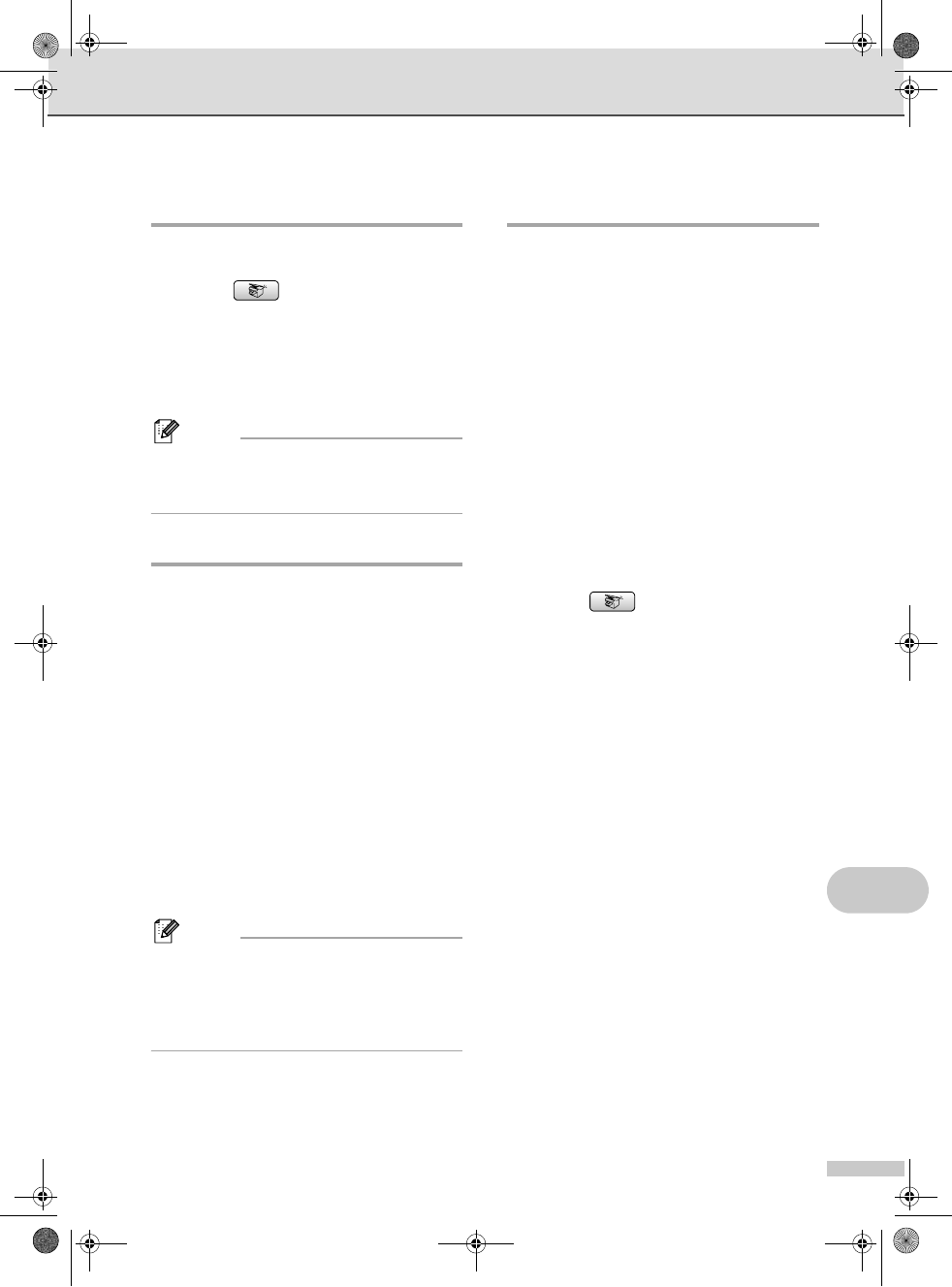
Making copies
93
13
Making multiple copies 13
You can make up to 99 copies.
aPress (Copy).
bLoad your document.
cEnter the number of copies you want.
dPress Black Start or Color Start.
Note
To sort the copies, press a or b to
choose Stack/Sort. (See Sorting
copies using the ADF on page 95.)
Stop copying 13
To stop copying, press Stop/Exit.
Copy settings 13
You can change the copy settings temporarily
for the next copy.
These settings are temporary, and the
machine returns to its default settings
60 seconds after copying, unless you have
set the Mode Timer to 30 seconds or less.
(See Mode Timer on page 26.)
If you have finished choosing settings, press
Black Start or Color Start.
If you want to choose more settings, press a
or b.
Note
You can save some of the settings that
you use most often by setting them as
default. These settings will stay until you
change them again. (See Setting your
changes as new default on page 97.)
Changing copy quality 13
You can choose from a range of quality. The
factory setting is Normal.
Fast
Fast copy speed and lowest amount of ink
used. Use to save time printing
documents to be proof-read, large
documents or many copies).
Normal
Normal is the recommended mode for
ordinary printouts. This produces good
copy quality with good copy speed.
Best
Use best mode to copy precise images
such as photographs. This provides the
highest resolution and slowest speed.
aPress (Copy).
bLoad your document.
cEnter the number of copies you want.
dPress a or b to choose Quality.
Press OK.
ePress a or b to choose Fast,Normal
or Best.
Press OK.
fIf you do not want to change additional
settings, press Black Start or
Color Start.
MFC-440CN_UG_US.book Page 93 Thursday, August 10, 2006 6:59 PM
Color:Blac
k
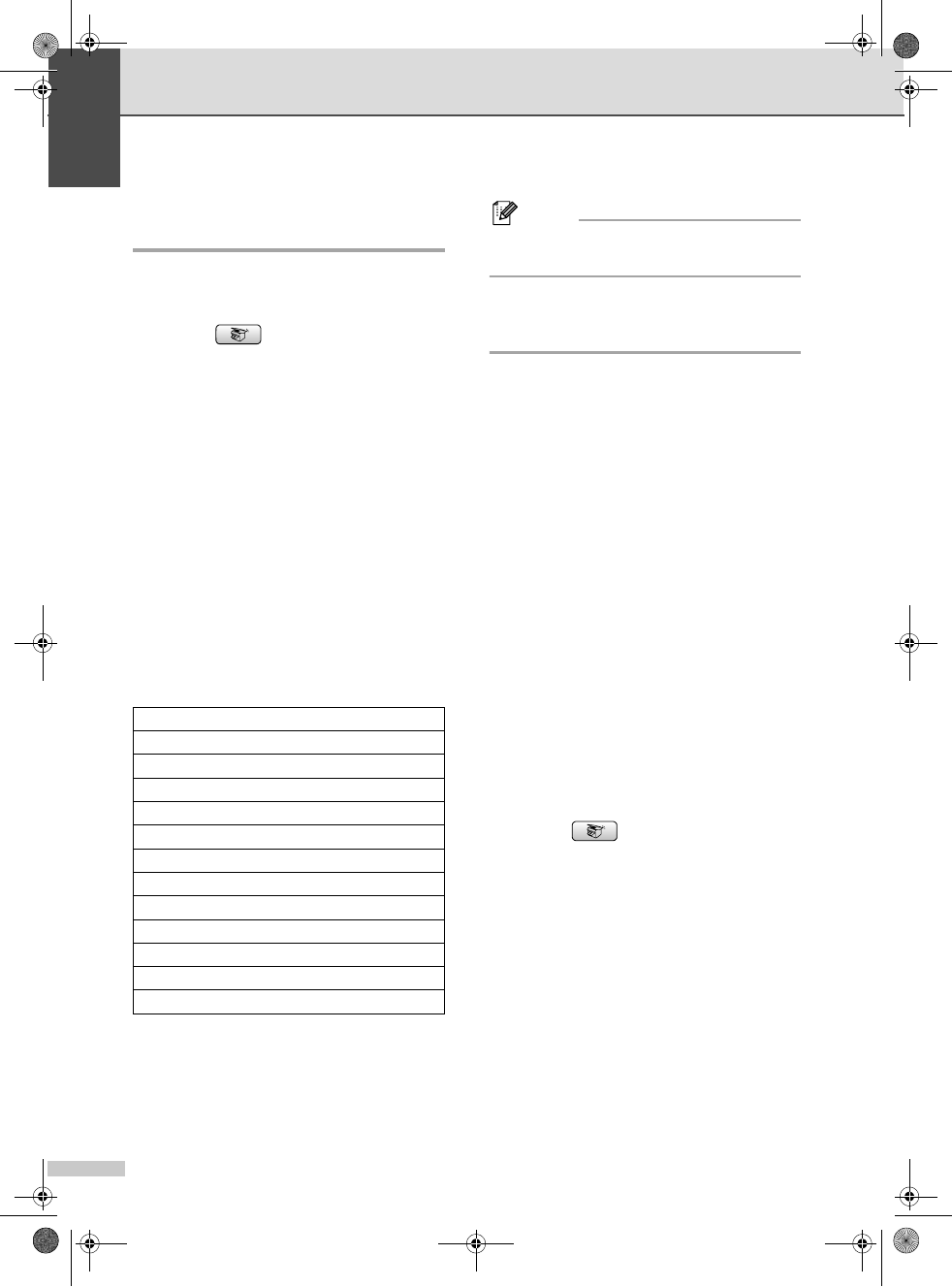
Chapter 13
94
Enlarging or reducing the
image copied 13
You can choose an enlargement or reduction
ratio.
aPress (Copy).
bLoad your document.
cEnter the number of copies you want.
dPress a or b to choose
Enlarge/Reduce.
Press OK.
eDo one of the following:
Press a or b to choose the
enlargement or reduction ratio you
want. Press OK.
Press a or b to choose
Custom(25-400%)and then enter
an enlargement or reduction ratio
from 25% to 400%. Press OK.
(For example, press 53 to enter
53%.)
fIf you do not want to change additional
settings, press Black Start or
Color Start.
Note
Page Layout Options are not available
with Enlarge/Reduce.
Making N in 1 copies or a
poster (page layout) 13
The N in 1 copy feature can help you save
paper by letting you copy two or four pages
onto one printed page.
You can also produce a poster. When you
use the poster feature your machine divides
your document into sections, then enlarges
the sections so you can assemble them into a
poster. If you want to print a poster, use the
scanner glass.
Important
Please make sure paper size is set to
Letter or A4.
You can not use the Enlarge/Reduce
setting with the N in 1 and Poster features.
If you are producing multiple color copies,
N in 1 copy is not available.
(P) means Portrait and (L) means
Landscape.
You can only make one poster copy at a
time.
aPress (Copy).
bLoad your document.
cEnter the number of copies you want.
dPress a or b to choose Page Layout.
Press OK.
ePress a or b to choose
Off (1 in 1),2in1(P),
2in1(L),4 in 1 (P),
4in1(L)or Poster(3 × 3).
Press OK.
50%
69% A4iA5
78% LGLiLTR
83% LGLiA4
93% A4iLTR
97% LTRiA4
100%*
104% EXEiLTR
142% A5iA4
186% 4"×6"iLTR
198% 4"×6"iA4
200%
Custom(25-400%)
MFC-440CN_UG_US.book Page 94 Thursday, August 10, 2006 6:59 PM
Color:Blac
k
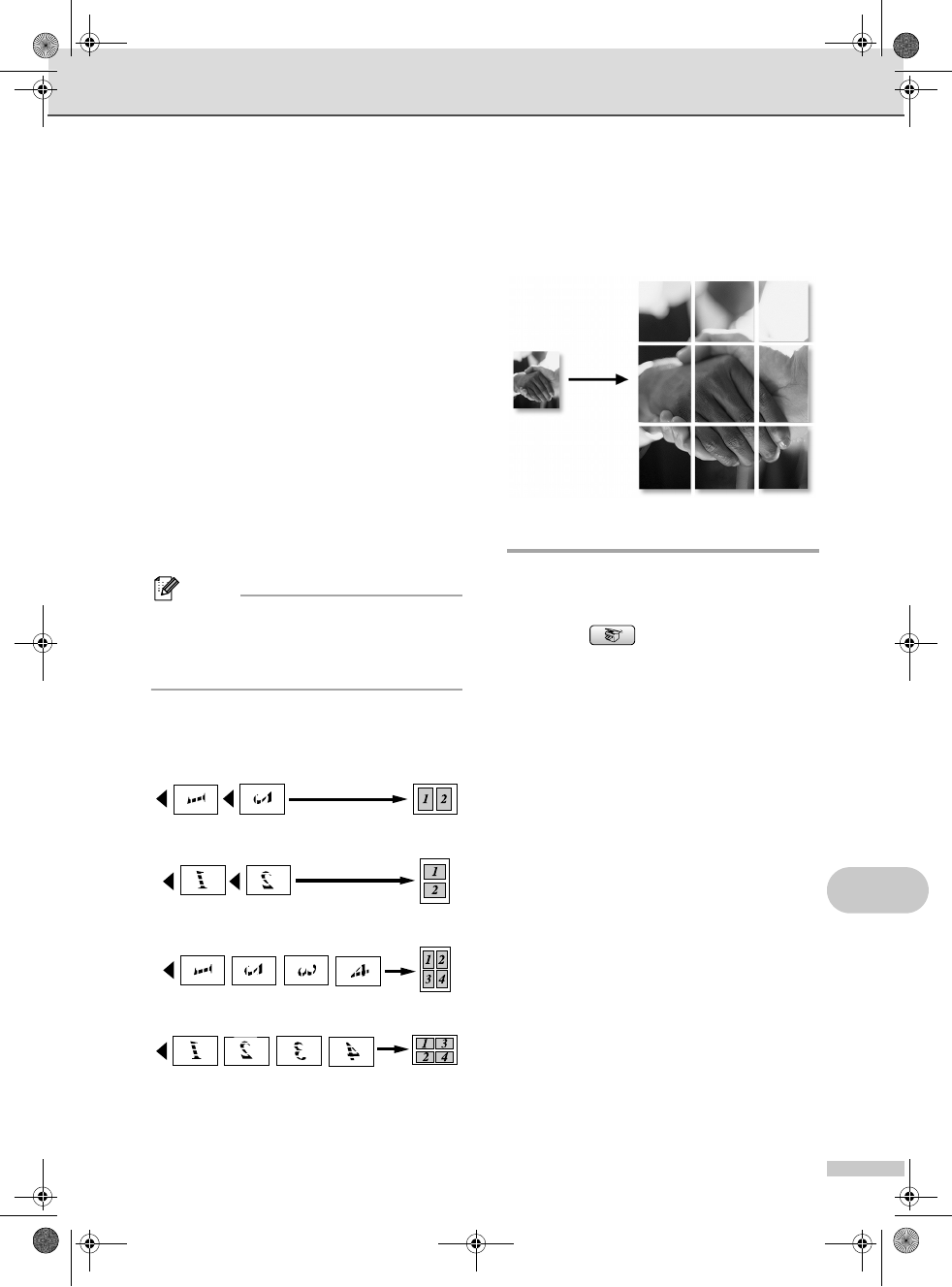
Making copies
95
13
fIf you do not want to change additional
settings, press Black Start or
Color Start to scan the page.
If you are making a poster or placed the
document in the ADF, the machine
scans the pages and starts printing.
If you are using the scanner glass, go
to step g.
gAfter the machine scans the page, press
1 to scan the next page.
hPlace the next page on the scanner
glass.
Press OK.
Repeat steps g and h for each page of
the layout.
iAfter all the pages have been scanned,
press 2 to finish.
Note
If photo paper has been chosen in the
Paper Type setting for N in 1 copies, the
machine will print the images as if Plain
paper had been chosen.
Place your document face down in the
direction shown below.
2 in 1 (P)
2 in 1 (L)
4 in 1 (P)
4 in 1 (L)
Poster (3 x 3)
You can make a poster size copy of a
photograph.
Sorting copies using the ADF13
You can sort multiple copies. Pages will be
stacked in the order 123, 123, 123, and so on.
aPress (Copy).
bLoad your document.
cEnter the number of copies you want.
dPress a or b to choose Stack/Sort.
Press OK.
ePress a or b to choose Sort.
Press OK.
fIf you do not want to change additional
settings, press Black Start or
Color Start.
MFC-440CN_UG_US.book Page 95 Thursday, August 10, 2006 6:59 PM
Color:Blac
k
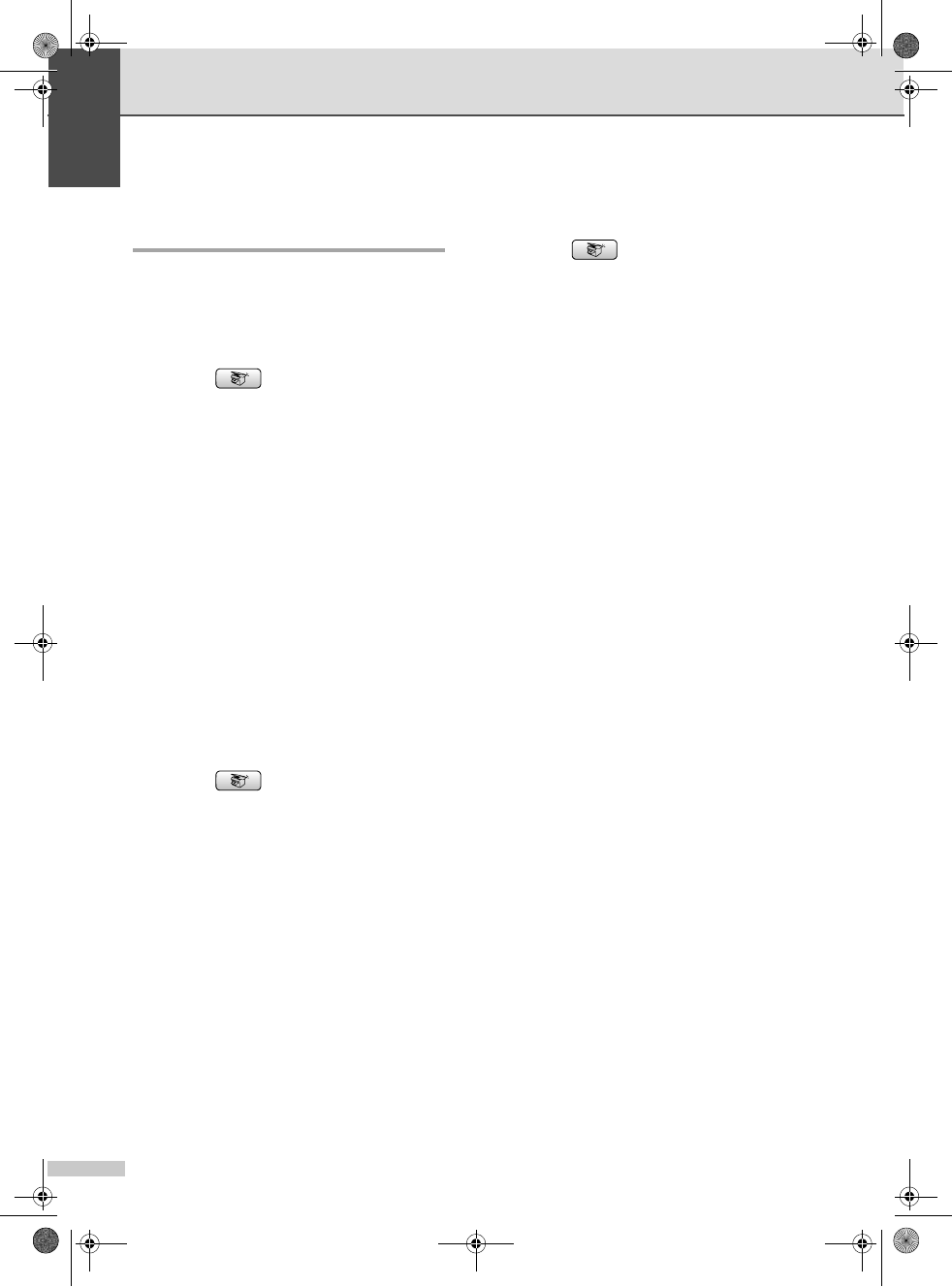
Chapter 13
96
Adjusting Brightness,
Contrast and Color 13
Brightness 13
You can adjust the copy brightness to make
copies darker or lighter.
aPress (Copy).
bLoad your document.
cEnter the number of copies you want.
dPress a or b to choose Brightness.
Press OK.
ePress d to make a darker copy or press
c to make a lighter copy.
Press OK.
fIf you do not want to change additional
settings, press Black Start or
Color Start.
Contrast 13
You can adjust the copy contrast to help an
image look sharper and more vivid.
aPress (Copy).
bLoad your document.
cEnter the number of copies you want.
dPress a or b to choose Contrast.
Press OK.
ePress c to increase the contrast or
press d to decrease the contrast.
Press OK.
fIf you do not want to change additional
settings, press Black Start or
Color Start.
Color Saturation 13
aPress (Copy).
bLoad your document.
cEnter the number of copies you want.
dPress a or b to choose
Color Adjust.
Press OK.
ePress a or b to choose Red,Green or
Blue.
Press OK.
fPress c to increase the color saturation,
or press d to decrease the color
saturation.
Press OK.
gDo one of the following:
If you want to change another color
saturation, go to step e.
If you want to change additional
settings, press a or b to choose
Exit.
Press OK.
If you do not want to change
additional settings, press
Black Start or Color Start.
MFC-440CN_UG_US.book Page 96 Thursday, August 10, 2006 6:59 PM
Color:Blac
k
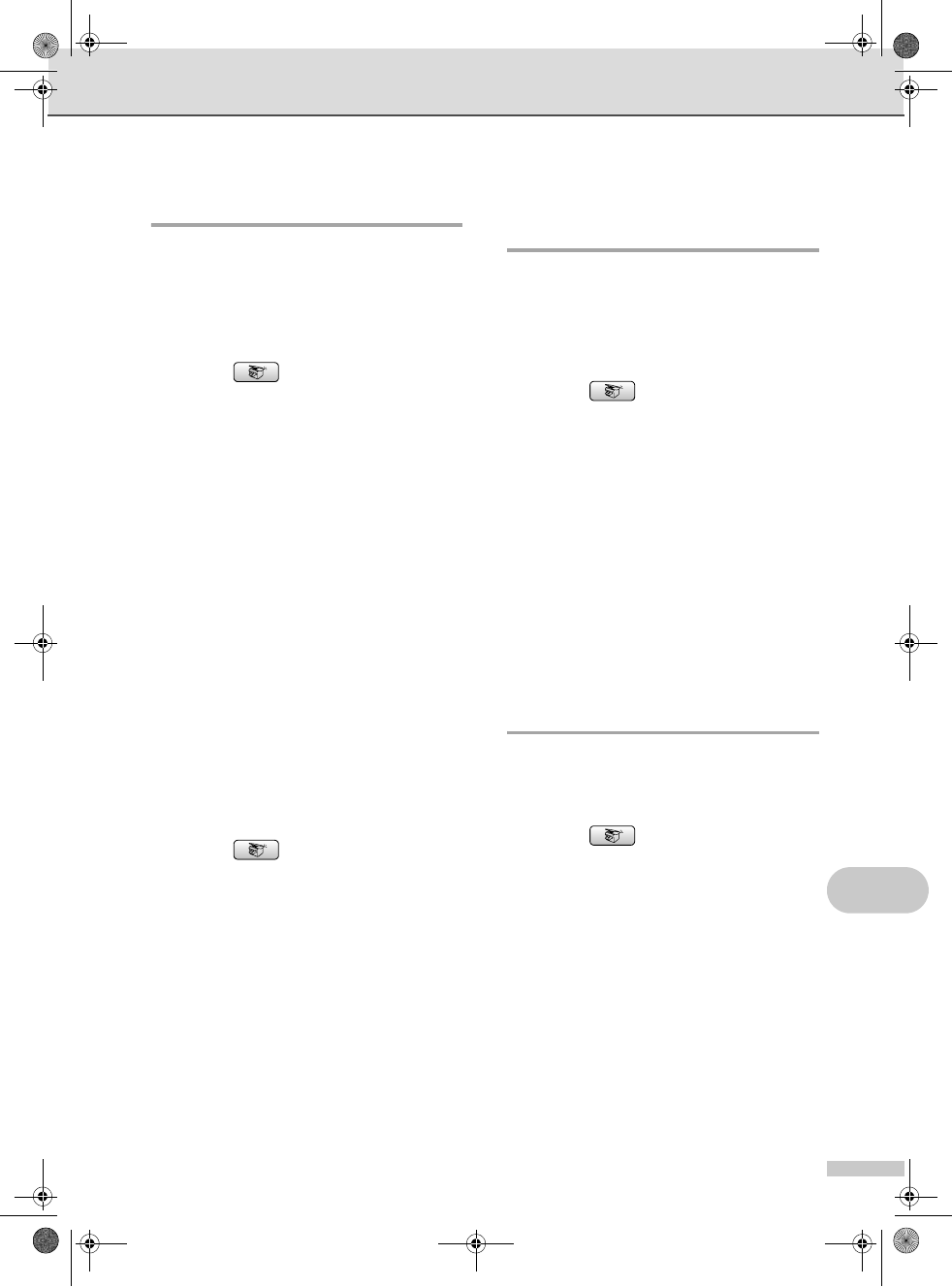
Making copies
97
13
Paper Options 13
Paper Type 13
If you are copying on special paper, set the
machine for the type of paper you are using to
get the best print quality.
aPress (Copy).
bLoad your document.
cEnter the number of copies you want.
dPress a or b to choose Paper Type.
Press OK.
ePress a or b to choose Plain Paper,
Inkjet Paper,Brother Photo,
Other Photo or Transparency.
Press OK.
fIf you do not want to change additional
settings, press Black Start or
Color Start.
Paper Size 13
If copying on paper other than Letter size, you
will need to change the paper size setting.
You can copy only on Letter, Legal, A4, A5 or
Photo [4 in. (W) × 6 in. (H) or 10 cm (W) ×
15 cm (H)] paper.
aPress (Copy).
bLoad your document.
cEnter the number of copies you want.
dPress a or b to choose Paper Size.
Press OK.
ePress a or b to choose Letter,
Legal,A4,A5 or 4"x 6".
Press OK.
fIf you do not want to change additional
settings, press Black Start or
Color Start.
Setting your changes as new
default 13
You can save the copy settings for Quality,
Paper Type,Brightness,Contrast and
Color Adjust that you use most often by
setting them the default settings. These
settings will stay until you change them again.
aPress (Copy).
bPress a or b to choose your new
setting.
Press OK.
Repeat this step for each setting you
want to change.
cAfter changing the last setting, press a
or b to choose Set New Default.
Press OK.
dPress 1 to choose Yes.
ePress Stop/Exit.
Restoring all the settings to
factory settings 13
You can restore all the settings you have
changed to the factory settings. These
settings will stay until you change them again.
aPress (Copy).
bPress a or b to choose
Factory Reset.
Press OK.
cPress 1 to choose Yes.
dPress Stop/Exit.
MFC-440CN_UG_US.book Page 97 Thursday, August 10, 2006 6:59 PM
Color:Blac
k
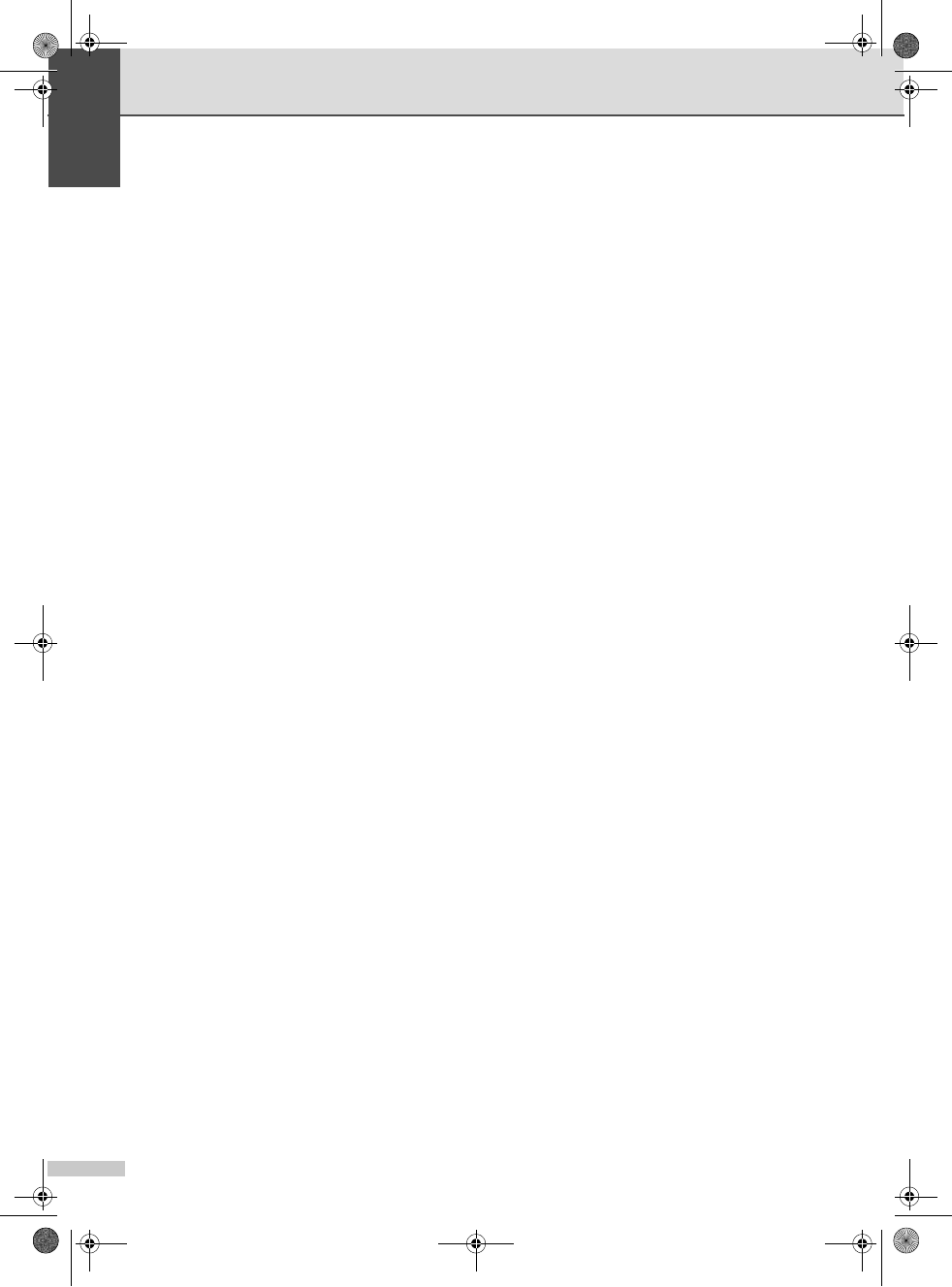
Chapter 13
98
‘Out of Memory’
message 13
If the Out of Memory message appears
while scanning documents, press Stop/Exit
to cancel or Black Start or Color Start to
copy the scanned pages.
You will need to clear some jobs from the
memory before you can continue.
To free up extra memory, do the following:
Turn off Advanced Fax Operation. (See
Turning off Advanced Fax
Operations on page 81.)
Print the faxes that are in the memory.
(See Printing a fax from the
memory on page 51.)
When you get an Out of Memory
message, you may be able to make copies if
you first print incoming faxes in the memory to
restore the memory to 100%.
MFC-440CN_UG_US.book Page 98 Thursday, August 10, 2006 6:59 PM
Color:Blac
k
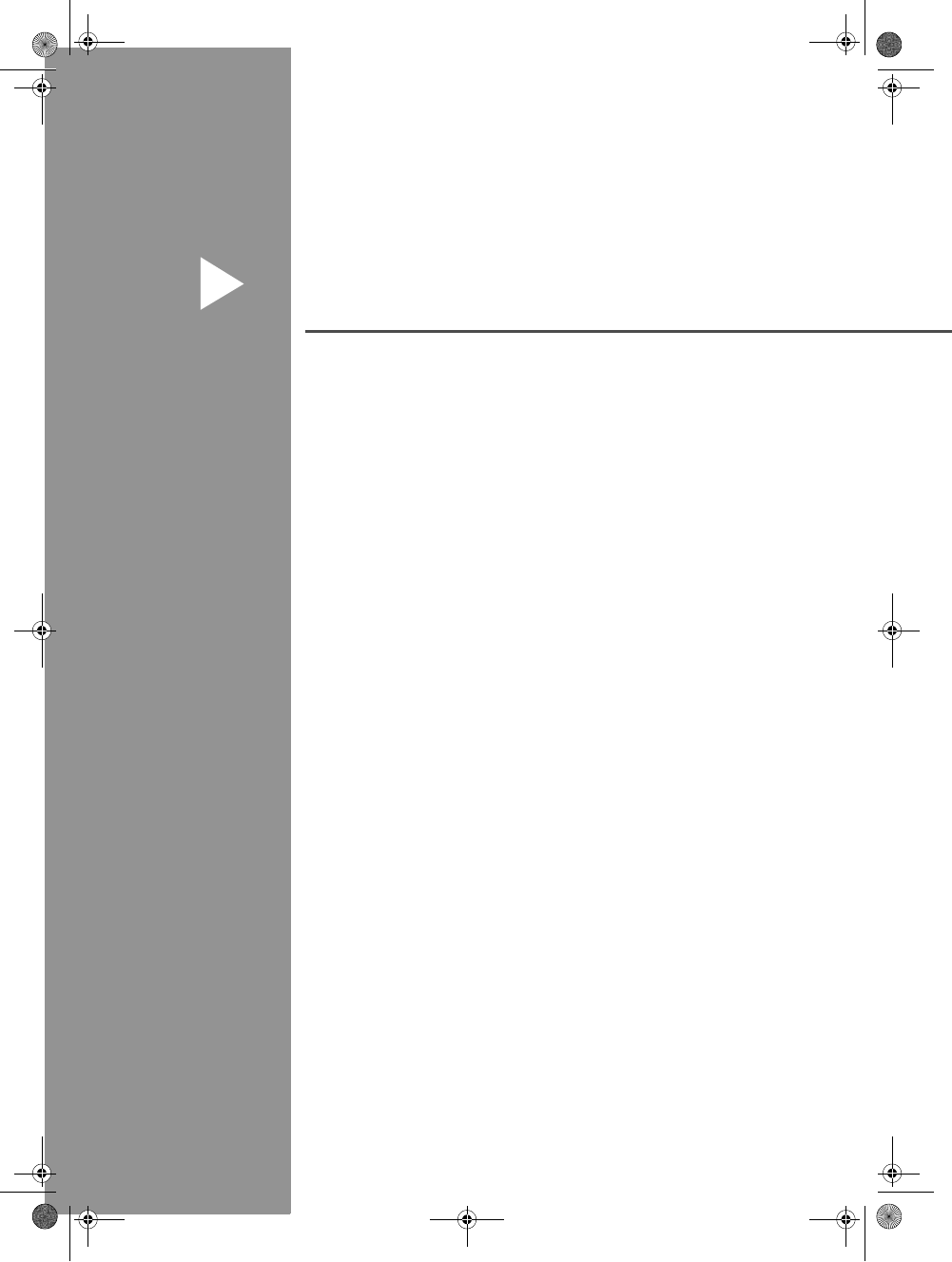
Section IV
Walk-up Photo Printing IV
PhotoCapture Center®100
PictBridge 111
MFC-440CN_UG_US.book Page 99 Thursday, August 10, 2006 6:59 PM
Color:Blac
k
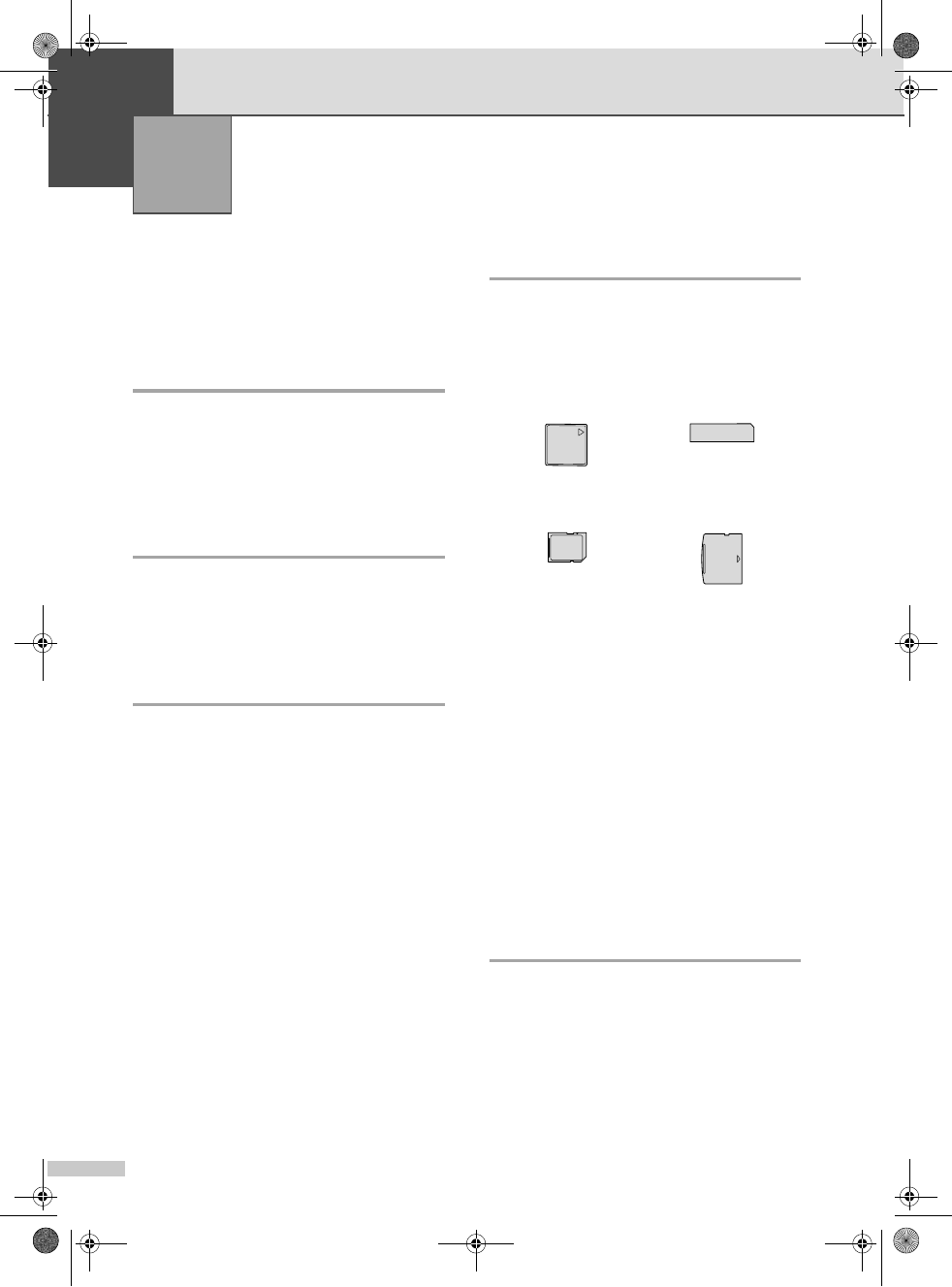
100
14
PhotoCapture Center®
Operations 14
Printing from a media card
without a PC 14
Even if your machine is not connected to your
computer, you can print photos directly from
digital camera media. (See Print
Images on page 102.)
Scanning to a media card
without a PC 14
You can scan documents and save them
directly to a media card. (See Scan to
Card on page 109.)
Using PhotoCapture Center®
from your computer
You can access the media card that is in the
media drive (slot) of the machine from your
PC.
(See PhotoCapture Center® for Windows® or
Remote Setup & PhotoCapture Center® for
Macintosh® in the Software User’s Guide on
the CD-ROM.)
Using media cards 14
Your Brother machine includes media drives
(slots) for use with popular digital camera
media: CompactFlash®, Memory Stick®,
Memory Stick Pro™, SecureDigital™,
MultiMediaCard™ and xD-Picture Card™.
miniSD™ can be used with a miniSD™
adapter.
Memory Stick Duo™ can be used with a
Memory Stick Duo™ adapter.
Memory Stick Pro Duo™ can be used with
a Memory Stick Pro Duo™ adapter.
Adapters are not included with the
machine. Contact a third party supplier for
adapters.
The PhotoCapture Center® feature lets you
print digital photos from your digital camera at
high resolution to get photo quality printing.
Media card folder structure 14
To avoid errors, remember the following
points:
The DPOF file on the media card must be
in a valid format. (See DPOF
printing on page 104.)
PhotoCapture Center®
14
CompactFlash®Memory Stick®
Memory Stick Pro™
SecureDigital™
MultiMediaCard™
xD-Picture Card™
MFC-440CN_UG_US.book Page 100 Thursday, August 10, 2006 6:59 PM
Color:Blac
k
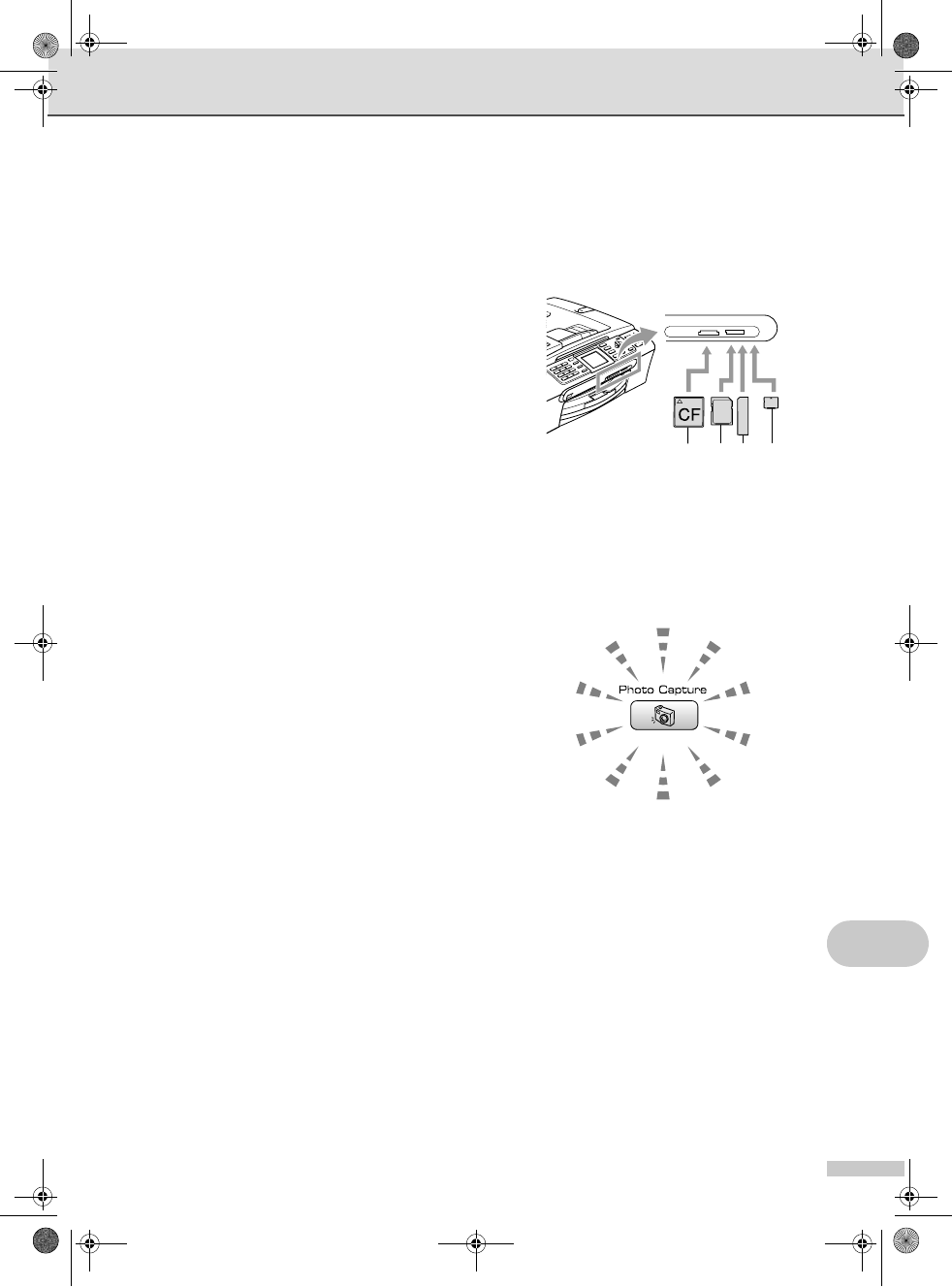
PhotoCapture Center®
101
14
The image file extension must be .JPG
(Other image file extensions like
.JPEG,.TIF, .GIF and so on will not be
recognized).
Walk-up PhotoCapture Center® printing
must be performed separately from
PhotoCapture Center® operations using
the PC. (Simultaneous operation is not
available.)
IBM Microdrive™ is not compatible with
the machine.
The machine can read up to 999 files
(including the folder inside memory) on a
media card.
CompactFlash® Type II is not supported.
This product supports xD-Picture Card™
Type M / Type H (Large Capacity).
Please be aware of the following:
When printing the INDEX or IMAGE, the
PhotoCapture Center® will print all the
valid images, even if one or more images
have been corrupted. A portion of the
corrupted image may be printed.
Your machine is designed to read media
cards that have been formatted by a digital
camera.
When a digital camera formats a media
card it creates a special folder into which it
copies image data. If you need to modify
the image data stored on a media card
with your PC, we recommend that you do
not modify the folder structure created by
the digital camera. When saving new or
modified image files to the media card we
also recommend you use the same folder
your digital camera uses. If the data is not
saved to the same folder, the machine
may not be able to read the file or print the
image.
Getting started 14
Firmly put the card into the proper slot.
1 CompactFlash®
2 SecureDigital™, MultiMediaCard™
3 Memory Stick®, Memory Stick Pro™
4 xD-Picture Card™
PhotoCapture key lights:
PhotoCapture light is on, the media card
is properly inserted.
PhotoCapture light is off, the media card
is not properly inserted.
PhotoCapture light is blinking, the media
card is being read or written to.
1 2 3 4
MFC-440CN_UG_US.book Page 101 Thursday, August 10, 2006 6:59 PM
Color:Blac
k
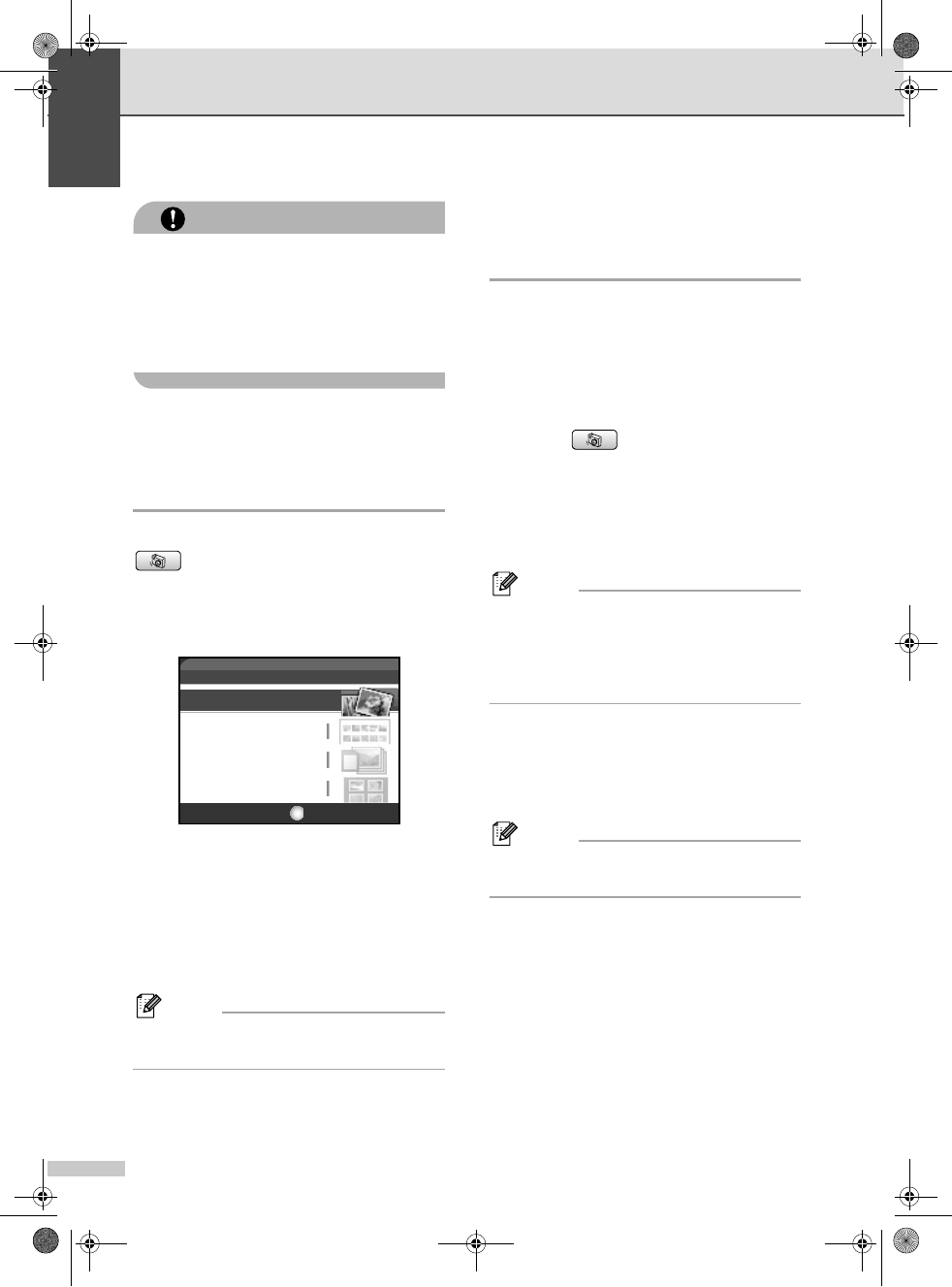
Chapter 14
102
CAUTION
DO NOT unplug the power cord or remove
the media card from the media drive (slot)
while the machine is reading or writing to
the card (the PhotoCapture key is
blinking). You will lose your data or
damage the card.
The machine can only read one media card at
a time so do not put more than one card in a
slot.
Entering PhotoCapture mode 14
After you insert the media card, press the
(PhotoCapture) key to illuminate it in
green and display the PhotoCapture options
on the LCD.
The LCD shows:
Press a or b to scroll through the
PhotoCapture key options.
View Photo(s) (See page 102.)
Print Index (See page 103.)
Print All Photos (See page 103.)
Print Photos (See page 104.)
Note
If your digital camera supports DPOF
printing, see DPOF printing on page 104.
When the option you want is highlighted,
press OK.
Print Images 14
View Photo(s) 14
You can preview your photos on the LCD
before you print them. If your photos are large
files there may be a delay before each photo
is displayed on the LCD.
aMake sure you have put the media card
in the proper slot.
Press (PhotoCapture).
bPress a or b to choose
View Photo(s).
Press OK.
cPress d or c to choose your photo.
Note
Instead of scrolling through your photos,
you can use the dial pad to enter the 3-
digit number of the image from the index
page. (See Print Index
(Thumbnails) on page 103.)
dPress a to bto increase or decrease
the number of copies.
eRepeat step c and step d until you
have chosen all the photos.
Note
Press Clear/Back to go back to the
previous level.
fAfter you have chosen all the photos, do
one of the following:
Press OK and change the print
setting. (See page 105.)
If you do not want to change any
settings, press Color Start to print.
Print Index
Print All Photos
Print Photos
View Photo(s)
PHOTO
OKSelect & Press
MFC-440CN_UG_US.book Page 102 Thursday, August 10, 2006 6:59 PM
Color:Blac
k
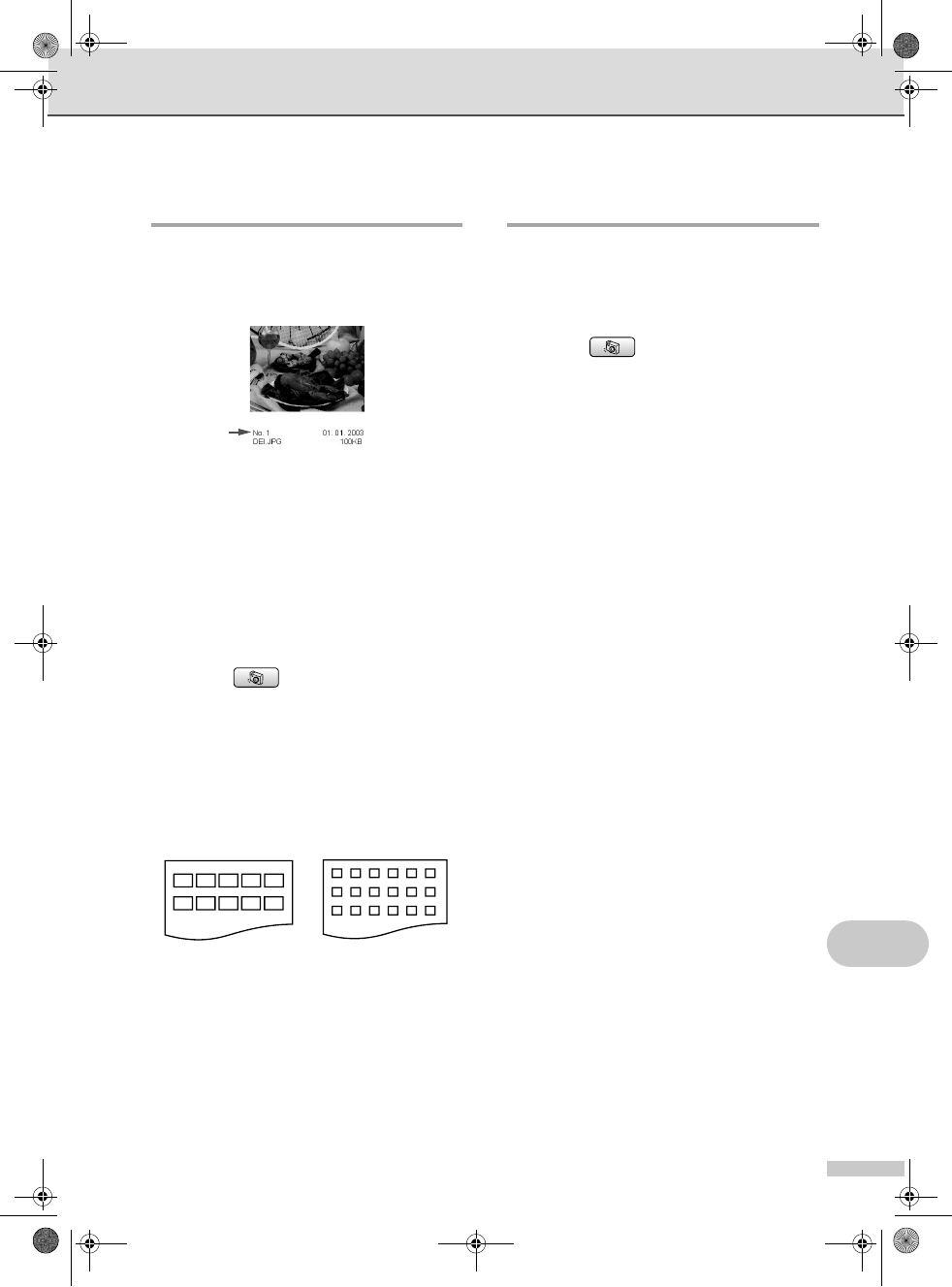
PhotoCapture Center®
103
14
Print Index (Thumbnails) 14
The PhotoCapture Center® assigns numbers
for images (such as No.1, No.2, No.3, and so
on).
The PhotoCapture Center® does not
recognize any other numbers or file names
that your digital camera or PC has used to
identify the pictures. You can print a
thumbnail page (Index page with 6 or 5
images per line). This will show all the
pictures on the media card.
aMake sure you have put the media card
in the proper slot.
Press (PhotoCapture).
bPress a or b to choose Print Index.
Press OK.
cPress a or b to choose
6 Images/Line Fast or
5 Images/Line Photo.
Press OK.
Print time for 5 Images/Line will be
slower than 6 Images/Line, but the
quality is better.
dPress Color Start to print.
Print All Photos 14
You can print all the photos on your media
card.
aMake sure you have put the media card
in the proper slot.
Press (PhotoCapture).
bPress a or b to choose
Print All Photos.
Press OK.
cEnter the number of copies you want
using the dial pad.
dDo one of the following:
Change the print setting. (See
page 105.)
If you do not want to change any
settings, press Color Start to print.
5 Images/Line
Photo
6 Images/Line
Fast
MFC-440CN_UG_US.book Page 103 Thursday, August 10, 2006 6:59 PM
Color:Blac
k
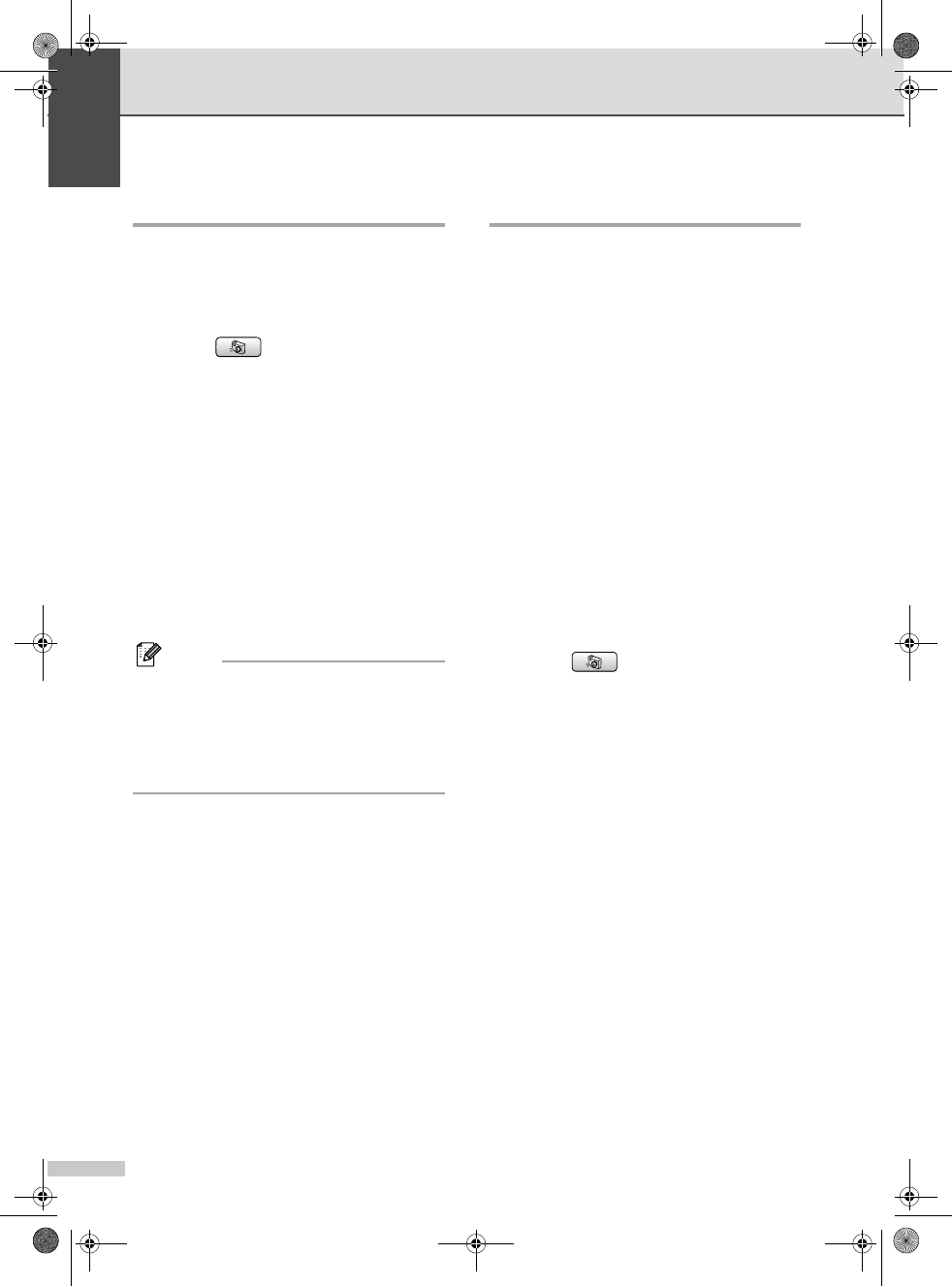
Chapter 14
104
Print Photos 14
Before you can print an individual image, you
have to know the image number.
aMake sure you have put the media card
in the proper slot.
Press (PhotoCapture).
bPrint the Index. (See Print Index
(Thumbnails) on page 103.)
cPress a or b to choose
Print Photos.
Press OK.
dEnter the image number that you want to
print from the Index page (Thumbnails).
Press OK.
eRepeat step d until you have entered
all the image numbers that you want to
print.
Note
You can enter all the numbers at one time
by using the l key for a comma or the #
key for a hyphen. For example, Enter 1,
l,3,l,6 to print images No.1, No.3 and
No.6. Enter 1,#,5 to print images No.1 to
No.5.
fAfter you have chosen all the image
numbers, press OK again.
gEnter the number of copies you want
using the dial pad.
hDo one of the following:
Change the print setting. (See
page 105.)
If you do not want to change any
settings, press Color Start to print.
DPOF printing 14
DPOF stands for Digital Print Order Format.
Major digital camera manufacturers (Canon
Inc., Eastman Kodak Company, Fuji Photo
Film Co. Ltd., Matsushita Electric Industrial
Co. Ltd. and Sony Corporation) created this
standard to make it easier to print images
from a digital camera.
If your digital camera supports DPOF
printing, you will be able to choose on the
digital camera display the images and
number of copies you want to print.
When the memory card (CompactFlash®,
Memory Stick®, Memory Stick Pro™,
SecureDigital™ MultiMediaCard™ or xD-
Picture Card™) with DPOF information is put
into your machine, you can print the chosen
image easily.
aMake sure you have put the media card
into the proper slot.
Press (PhotoCapture). The
machine will ask you if you want to use
DPOF setting.
bPress 1 to choose Yes.
cDo one of the following:
Change the print settings. (See
page 105.)
If you do not want to change any
settings, press Color Start to print.
MFC-440CN_UG_US.book Page 104 Thursday, August 10, 2006 6:59 PM
Color:Blac
k
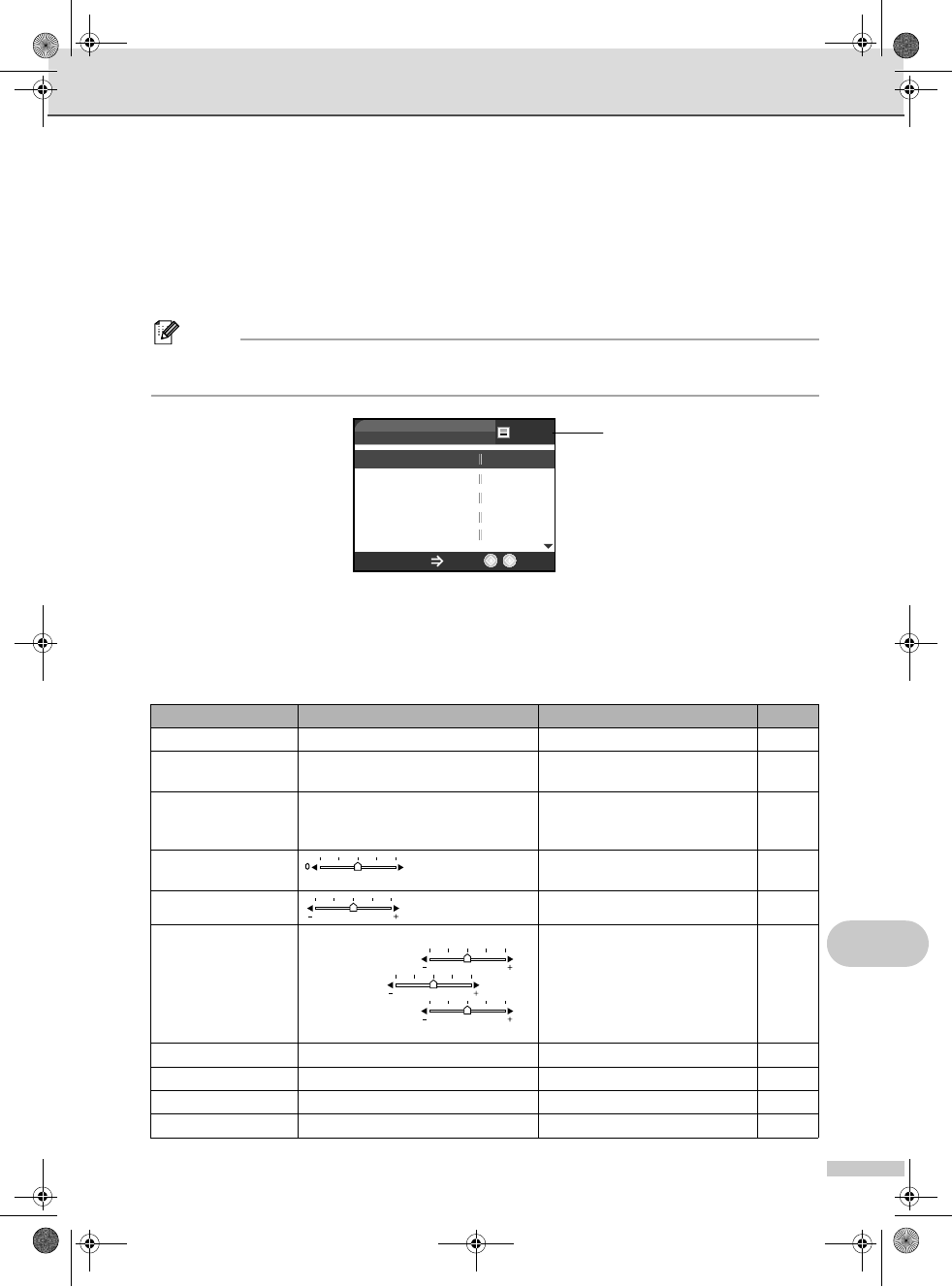
PhotoCapture Center®
105
14
PhotoCapture Center® print settings 14
You can change the print settings temporarily for the next printing.
These settings are temporary, and the machine returns to its default settings 180 seconds after
printing, unless you have set the Mode Timer to 2 minutes or less. (See Mode Timer on page 26.)
Note
You can save the print settings you use most often by setting them as default. (See Setting
your changes as new default on page 108.)
1 No of prints
(For View Photo(s))
You can see the total number of photos that will be printed.
(For Print All Photos, Print Photos)
You can see the number of copies of each photo that will be printed.
Menu Selections Option1 Option2 Page
Print Quality Normal/Photo — 106
Paper Type Plain Paper/Inkjet Paper/
Brother Photo/Other Photo
— 106
Paper Size Letter/A4/4"x 6"/5"x 7" (When A4 or Letter is chosen)
4"x 3"/5"x 3.5"/6"x 4"/
7"x 5"/8"x 6"/Max. Size
106
Brightness — 106
Contrast — 106
True2Life On/Off
White Balance /
Sharpness /
Color Density
Exit
— 107
Cropping On/Off — 108
Borderless On/Off — 108
Set New Default Yes/No — 108
Factory Reset Yes/No — 108
PHOTO
Paper Type
Paper Size
Brightness
Contrast
Other Ph
Print Quality Photo
4"x 6"
0
0
Print Start Press
0001
1
Dark Ligh
t
MFC-440CN_UG_US.book Page 105 Thursday, August 10, 2006 6:59 PM
Color:Blac
k
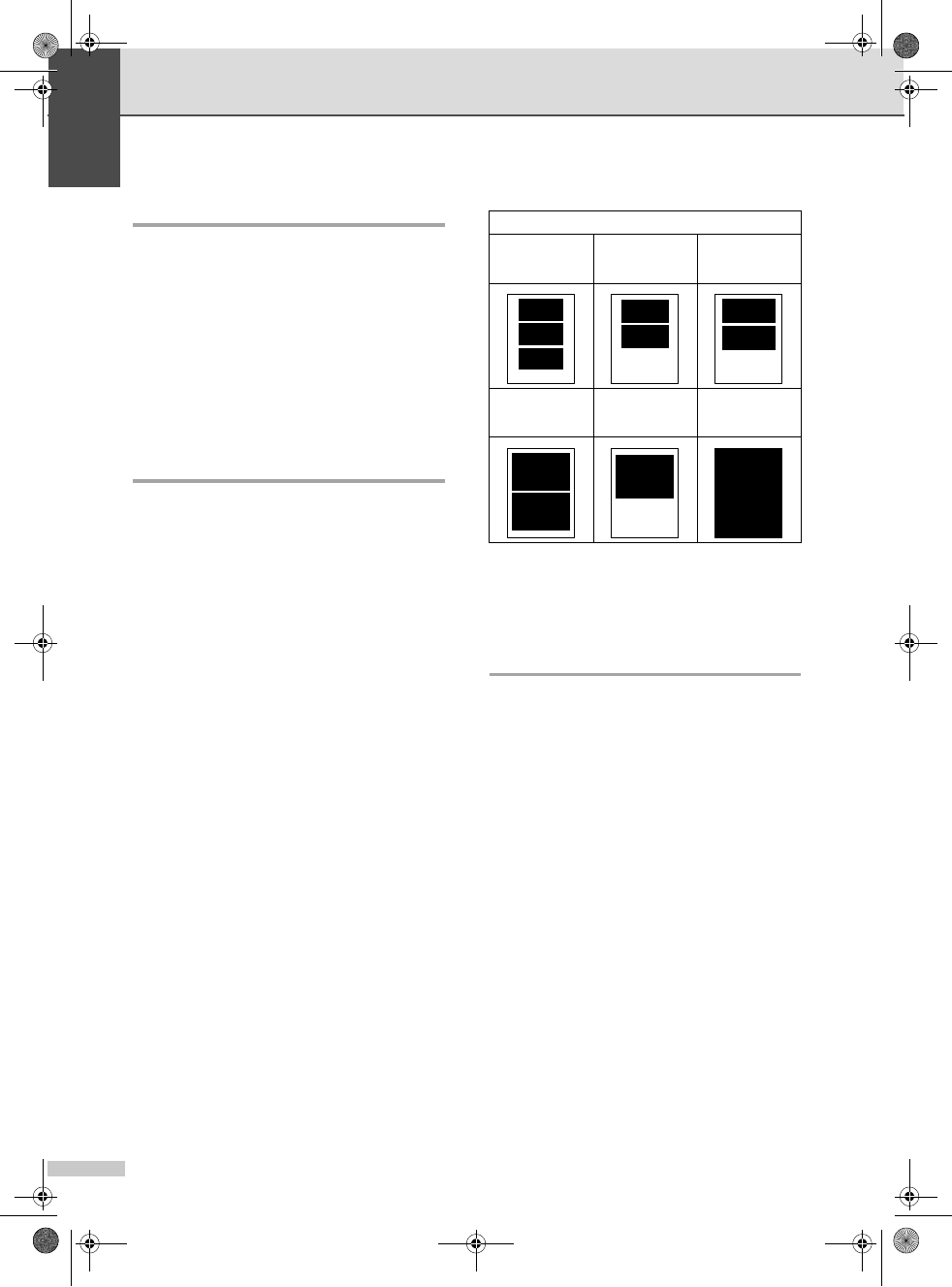
Chapter 14
106
Print Quality 14
aPress a or b to choose
Print Quality.
Press OK.
bPress a or b to choose Normal or
Photo.
Press OK.
cIf you do not want to change additional
settings, press Color Start to print.
Paper options 14
Paper Type 14
aPress a or b to choose Paper Type.
Press OK.
bPress a or b to choose the type of
paper you are using, Plain Paper,
Inkjet Paper,Brother Photo or
Other Photo.
Press OK.
cIf you do not want to change additional
settings, press Color Start to print.
Paper and print size 14
aPress a or b to choose Paper Size.
Press OK.
bPress a or b to choose the type of
paper you are using, Letter,4"×6",
5"×7" or A4.
Press OK.
cIf you chose Letter or A4, press a or b
to choose the print size.
Press OK.
dIf you do not want to change additional
settings, press Color Start to print.
Adjusting Brightness,
Contrast and Color 14
Brightness 14
aPress a or b to choose Brightness.
Press OK.
bPress d to make a darker copy or press
c to make a lighter copy.
Press OK.
cIf you do not want to change additional
settings, press Color Start to print.
Contrast 14
You can choose the contrast setting. More
contrast will make an image look sharper and
more vivid.
aPress a or b to choose Contrast.
Press OK.
bPress c to increase the contrast or
press d to decrease the contrast.
Press OK.
Example: Printed Position for Letter paper
1
4"× 3"
2
5"× 3.5"
3
6"× 4"
4
7"× 5"
5
8"× 6"
6
Max. Size
MFC-440CN_UG_US.book Page 106 Thursday, August 10, 2006 6:59 PM
Color:Blac
k
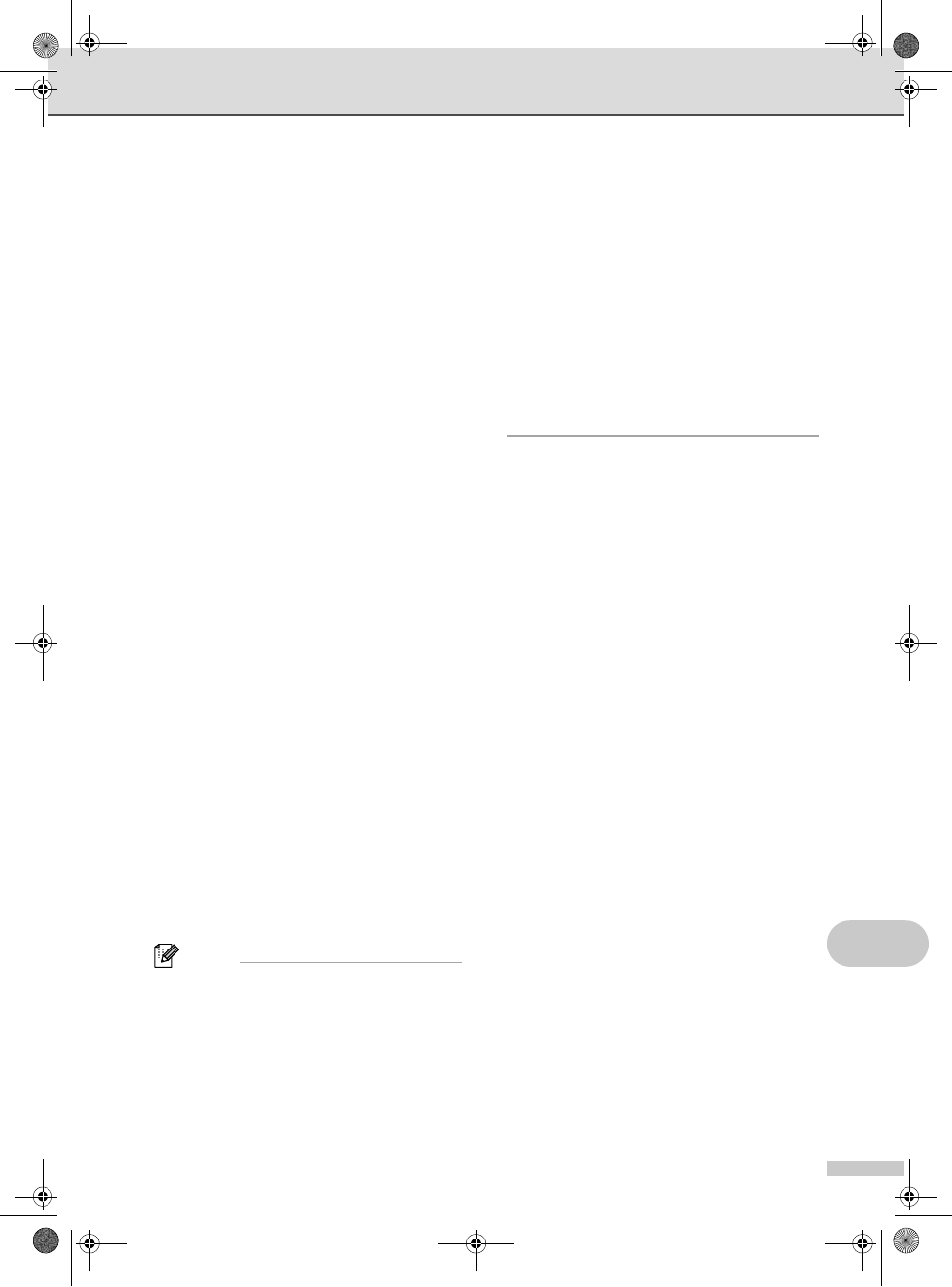
PhotoCapture Center®
107
14
cIf you do not want to change additional
settings, press Color Start to print.
Color Enhancement (True2Life®)14
The color enhancement (True2Life®) feature
will produce more vivid images. Your
photographs will take slightly longer to print.
aPress a or b to choose True2Life.
Press OK.
bDo one of the following:
If you want to customize the White
Balance, Sharpness or Color
Density, press d or c to choose On
and then go to step c.
If you do not want to customize,
press d or c to choose Off.
Press OK and then go to step f.
cPress a or bto choose
White Balance,Sharpness or
Color Density.
Press OK.
dPress d or c to adjust the degree of the
setting.
Press OK.
eDo one of the following:
If you want to customize other color
enhancement, press a or bto
choose other option.
If you want to change other settings,
press a or bto choose Exit, and
then press OK.
fIf you do not want to change additional
settings, press Color Start to print.
Note
•White Balance
This setting adjusts the hue of the white
areas of an image. Lighting, camera
settings and other factors will effect the
appearance of white. By using this
adjustment, you can correct this effect and
bring the white areas back to pure white.
•Sharpness
This setting enhances the detail of an
image. It is similar to adjusting the fine
focus on a camera. If the image is not in
focus and you cannot see the fine details
of the picture, then adjust the sharpness.
•Color Density
This setting adjusts the total amount of
color in the image. You can increase or
decrease the amount of color in an image
to improve a washed out picture.
MFC-440CN_UG_US.book Page 107 Thursday, August 10, 2006 6:59 PM
Color:Blac
k
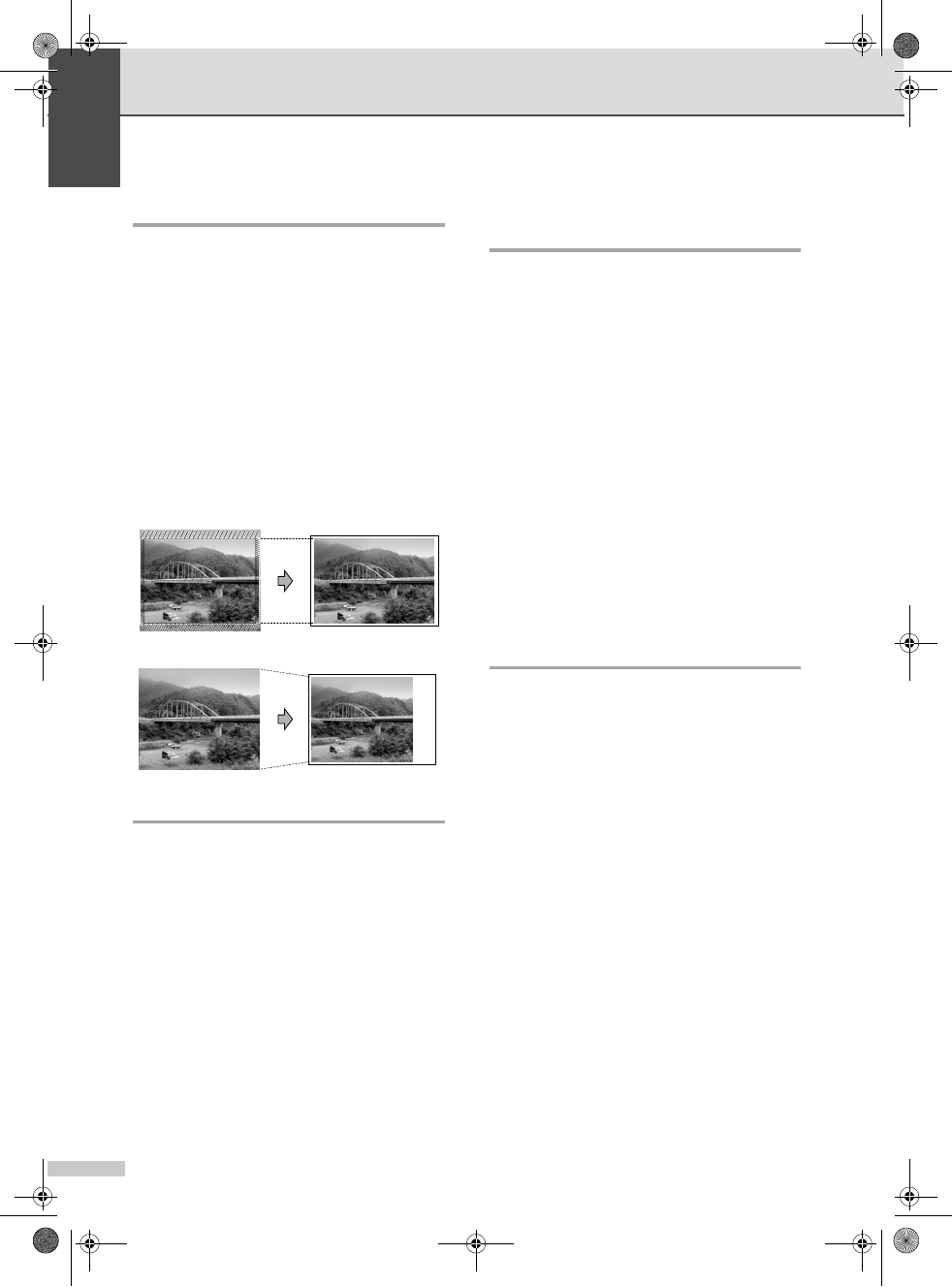
Chapter 14
108
Cropping 14
If your photo is too long or wide to fit the
available space on your chosen layout, part
of the image will automatically be cropped.
The factory setting is On. If you want to print
the whole image, turn this setting to Off.
aPress a or b to choose Cropping.
Press OK.
bPress a or b to choose Off (or On).
Press OK.
cIf you do not want to change additional
settings, press Color Start to print.
Cropping:On 14
Cropping:Off 14
Borderless printing 14
This feature expands the printable area to the
edges of the paper. Printing time will be
slightly slower.
aPress a or b to choose Borderless.
Press OK.
bPress a or b to choose Off (or On).
Press OK.
cIf you do not want to change additional
settings, press Color Start to print.
Setting your changes as new
default 14
You can save the print settings you use most
often by setting them the default settings.
These settings will stay until you change
them again.
aPress a or b to choose your new
setting.
Press OK.
Repeat this step for each setting you
want to change.
bAfter changing the last setting, press a
or b to choose Set New Default.
Press OK.
cPress 1 to choose Yes.
dPress Stop/Exit.
Restoring all the settings to
factory settings 14
You can restore all the settings you have
changed to the factory settings. These
settings will stay until you change them again.
aPress a or b to choose
Factory Reset.
Press OK.
bPress 1 to choose Yes.
cPress Stop/Exit.
MFC-440CN_UG_US.book Page 108 Thursday, August 10, 2006 6:59 PM
Color:Blac
k
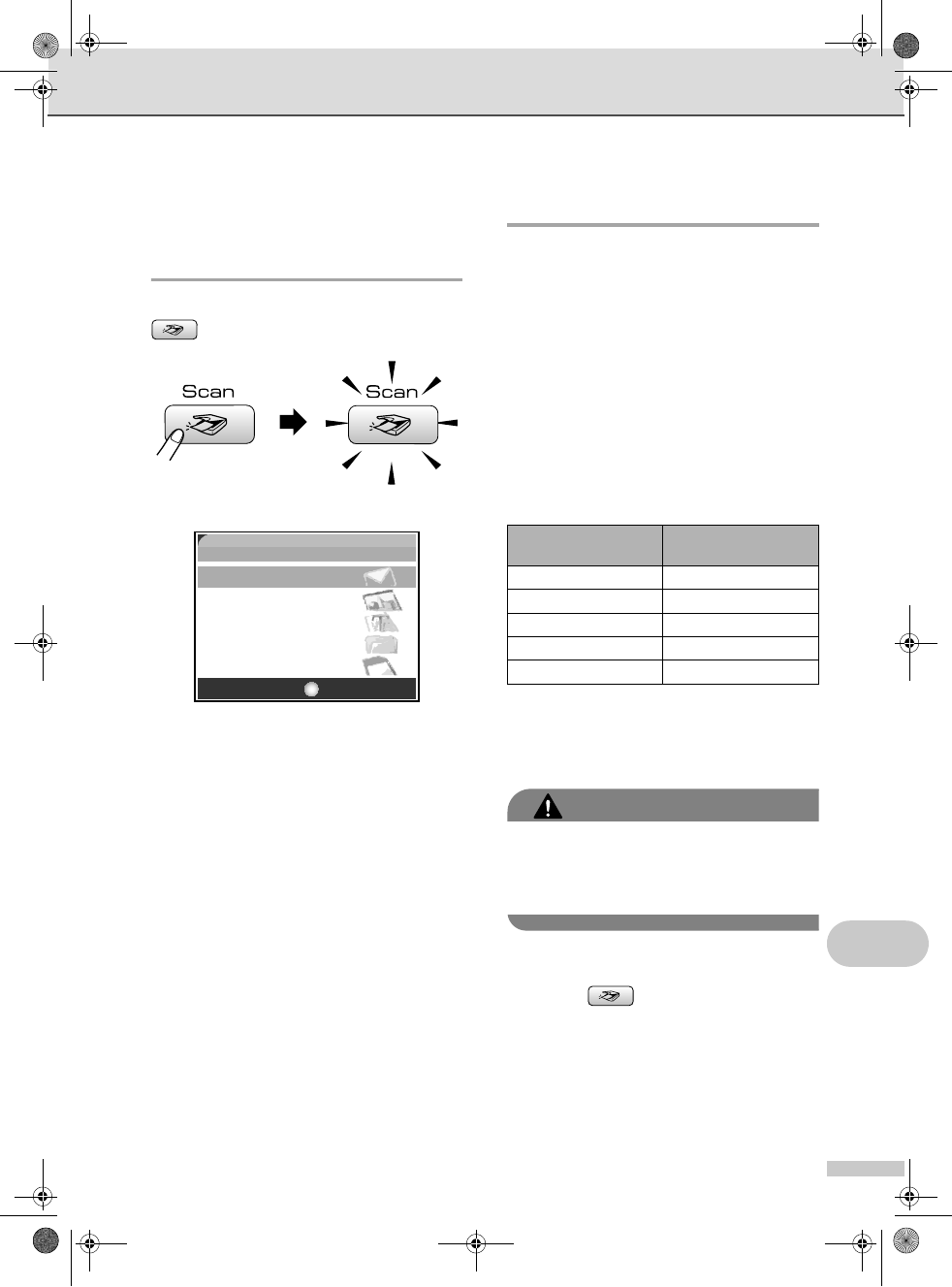
PhotoCapture Center®
109
14
Scan to Card 14
Entering Scan mode 14
When you want to scan to card, press
(Scan) to illuminate it in green.
The LCD shows:
Press a or b to choose Scan to Card.
Press OK.
If you are not connected to your computer
only the Scan to Card selection will appear on
the LCD.
(See Scanning for Windows® or Macintosh®
in the Software User’s Guide on the CD-ROM
for details about the other menu options.)
How to scan to card 14
You can scan black & white and color
documents into a media card. Black & white
documents will be stored in PDF (*.PDF) or
TIFF file formats (*.TIF). Color documents
may be stored in PDF (*.PDF) or JPEG
(*.JPG) file formats. For color documents the
factory setting is 150 dpi Color and the
default file format is PDF. File names default
to the current date that you set using the
control panel keys. (For details, see Quick
Setup Guide.) For example, the fifth image
scanned on July 1, 2006 would be named
07010605.PDF. You can change the color,
quality and file name.
aInsert a CompactFlash®, Memory
Stick®, Memory Stick Pro™,
SecureDigital™, MultiMediaCard™ or
xD-Picture Card™ into your machine.
WARNING
Do not take out the media card while
PhotoCapture is blinking to avoid
damaging the card or data stored on the
card.
bLoad your document.
cPress (Scan).
dPress a or b to choose
Scan to Card.
Press OK.
SCAN
Scan to E-mail
Scan to Image
Scan to OCR
Scan to File
Scan to Card
OKSelect & Press
Quality Selectable File
Format
150 dpi Color JPEG / PDF
300 dpi Color JPEG / PDF
600 dpi Color JPEG / PDF
200x100 dpi B/W TIFF / PDF
200 dpi B/W TIFF / PDF
MFC-440CN_UG_US.book Page 109 Thursday, August 10, 2006 6:59 PM
Color:Blac
k
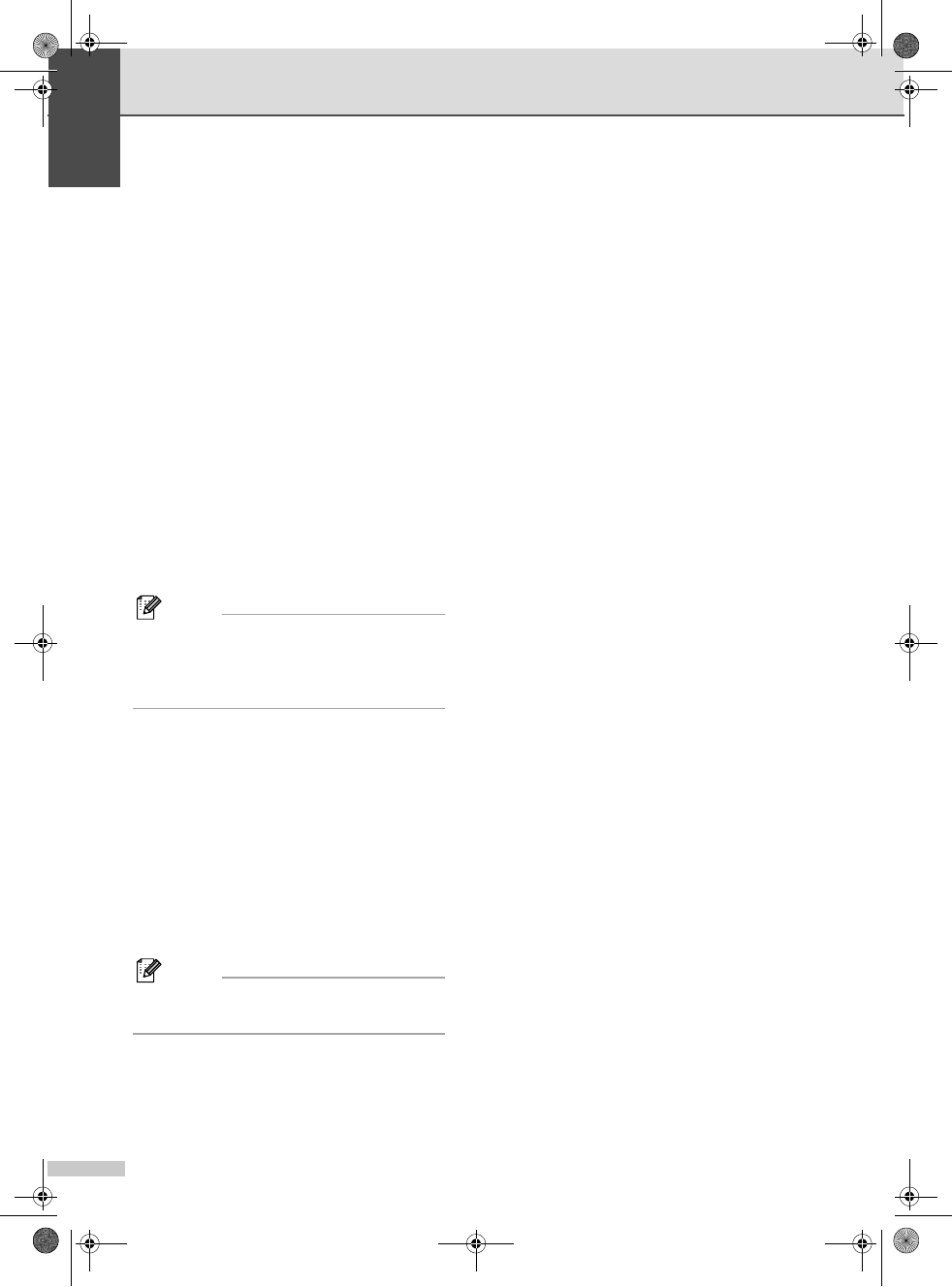
Chapter 14
110
eDo one of the following.
To change the quality, go to step f.
Press Black Start or Color Start to
start scanning without changing
additional settings.
fPress a or b to choose
150 dpi Color,300 dpi Color,
600 dpi Color,200x100 dpi B/W
or 200 dpi B/W.
Press OK.
gDo one of the following.
To change the file type, go to step h.
Press Black Start or Color Start to
start scanning without changing
additional settings.
hPress a or b to choose JPEG,PDF or
TIFF.
Press OK.
Note
• If you chose color in the resolution setting,
you cannot choose TIFF.
• If you chose black & white in the resolution
setting, you cannot choose JPEG.
iDo one of the following.
To change the file name, go to
step j.
Press Black Start or Color Start to
start scanning without changing
additional settings.
jThe file name is set automatically
however, you can set a name of your
choice using the dial pad. You can only
change the first 6 digits.
Press OK.
Note
Press Clear/Back to delete the current
name.
kPress Black Start or Color Start.
Understanding the
Error Messages 14
Once you are familiar with the types of errors
that can occur while you are using the
PhotoCapture Center®, you can easily
identify and troubleshoot any problems.
When an error message is displayed on the
LCD and you press a key, the machine will
beep to get your attention.
Media Error
This message will appear if you put in a
media card that is either bad or not
formatted, or when there is a problem with
the media drive. To clear this error, take
out the media card.
No File
This message will appear if you try to
access a media card in the drive (slot) that
does not contain a .JPG file.
Out of Memory
This message will appear if you are
working with images that are too large for
the machine's memory.
MFC-440CN_UG_US.book Page 110 Thursday, August 10, 2006 6:59 PM
Color:Blac
k
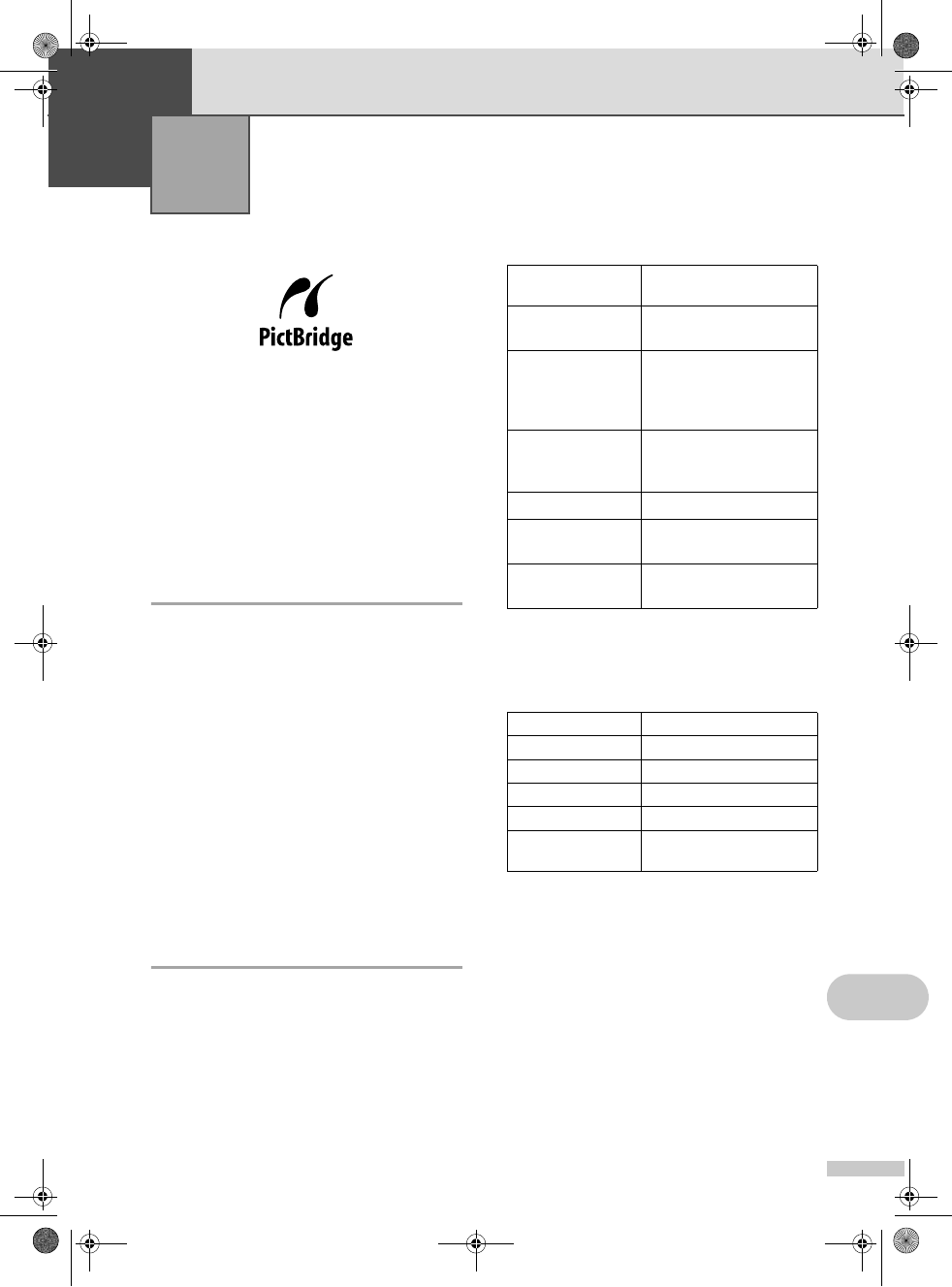
111
15
15
Your Brother machine supports the
PictBridge standard, allowing you to connect
to and print photos directly from any
PictBridge compatible digital camera.
Before Using
PictBridge 15
PictBridge requirements 15
To avoid errors, remember the following
points:
The machine and the digital camera must
be connected using a suitable USB cable.
The image file extension must be .JPG
(Other image file extensions like .JPEG,
.TIF, .GIF and so on will not be
recognized).
PhotoCapture Center® operations are not
available when using the PictBridge
feature.
Using PictBridge 15
Setting your digital camera 15
Make sure your camera is in PictBridge mode. The
following PictBridge settings may be available
from the LCD of your PictBridge compatible
camera.
Depending on your camera some of these settings
may not be available.
1See DPOF printing on page 112 for more details.
2If your camera is set to use the Printer Settings
(Default setting), the machine will print your photo
using the settings below.
The names and availability of each setting
depend on the specification of your
camera.
Please refer to the documentation supplied
with your camera for more detailed
information on changing PictBridge settings.
PictBridge 15
Camera Menu
Selections
Options
Paper Size Letter, A4, 4"×6", Printer
Settings (Default setting) 2
Paper Type Plain Paper, Glossy
Paper, Inkjet Paper,
Printer Settings (Default
setting) 2
Layout Borderless: On,
Borderless: Off, Printer
Settings (Default setting) 2
DPOF setting 1 —
Print Quality Normal, Fine, Printer
Settings (Default setting) 2
Color
Enhancement
On, Off, Printer Settings
(Default setting) 2
Settings Options
Paper Size 4"×6"
Paper Type Glossy Paper
Layout Borderless: On
Print Quality Fine
Color
Enhancement
Off
MFC-440CN_UG_US.book Page 111 Thursday, August 10, 2006 6:59 PM
Color:Blac
k
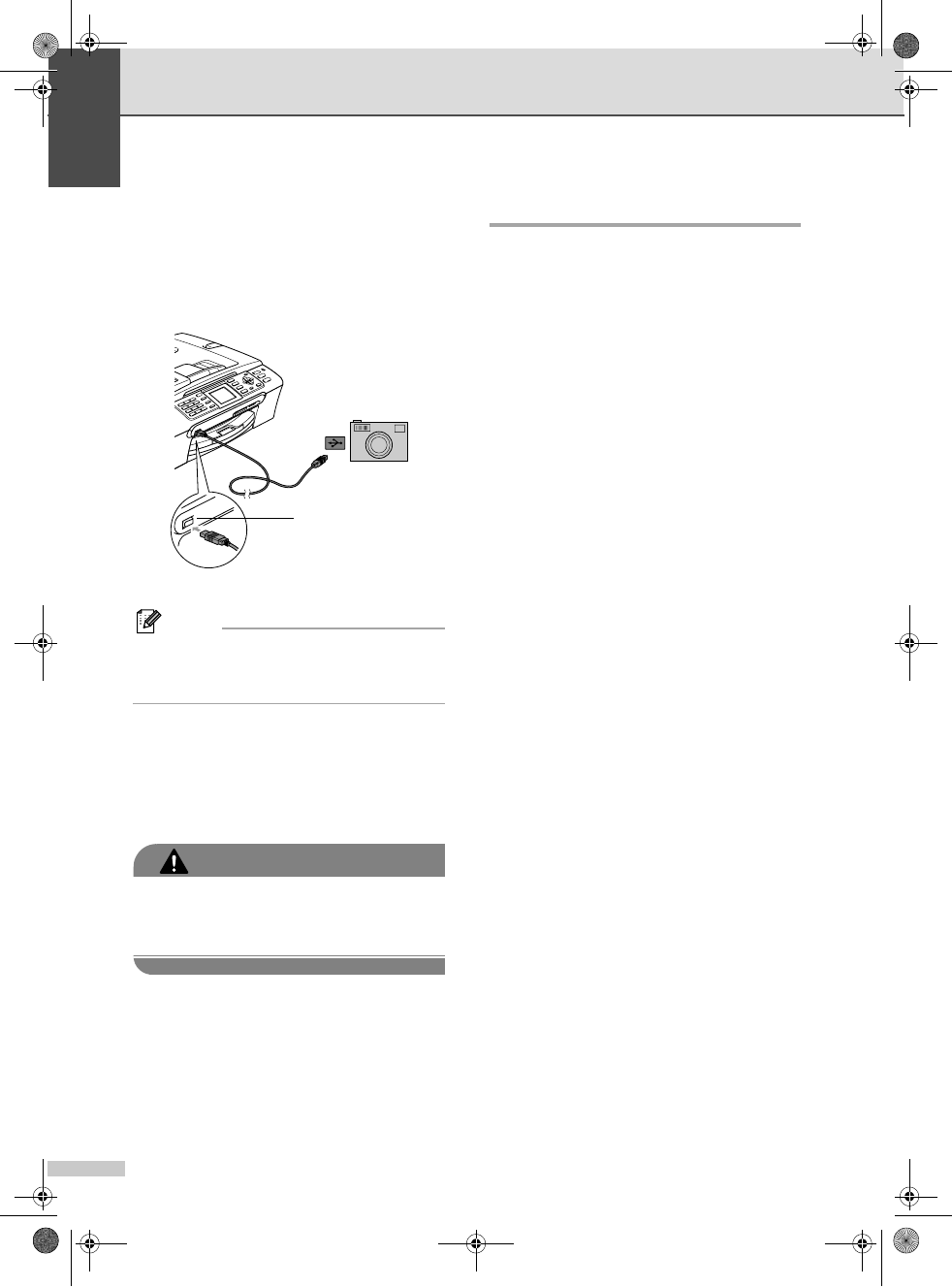
Chapter 15
112
Printing Images 15
aMake sure that your camera is turned
off. Connect your camera to the
PictBridge port on the machine using
the USB cable.
1 PictBridge port
Note
Remove any media cards from the
machine before connecting the digital
camera.
bTurn on the camera.
When the machine has recognized the
camera, the LCD shows
Camera Connected.
When the machine starts printing a
photo, the LCD will show Printing.
WARNING
To prevent damage to your machine, do not
connect any device other than a PictBridge
compatible camera to the PictBridge port.
DPOF printing 15
DPOF stands for Digital Print Order Format.
Major digital camera manufacturers (Canon
Inc., Eastman Kodak Company, Fuji Photo
Film Co. Ltd., Matsushita Electric Industrial
Co. Ltd. and Sony Corporation) created this
standard to make it easier to print images
from a digital camera.
If your digital camera supports DPOF
printing, you will be able to choose on the
digital camera display the images and
number of copies you want to print.
1
MFC-440CN_UG_US.book Page 112 Thursday, August 10, 2006 6:59 PM
Color:Blac
k
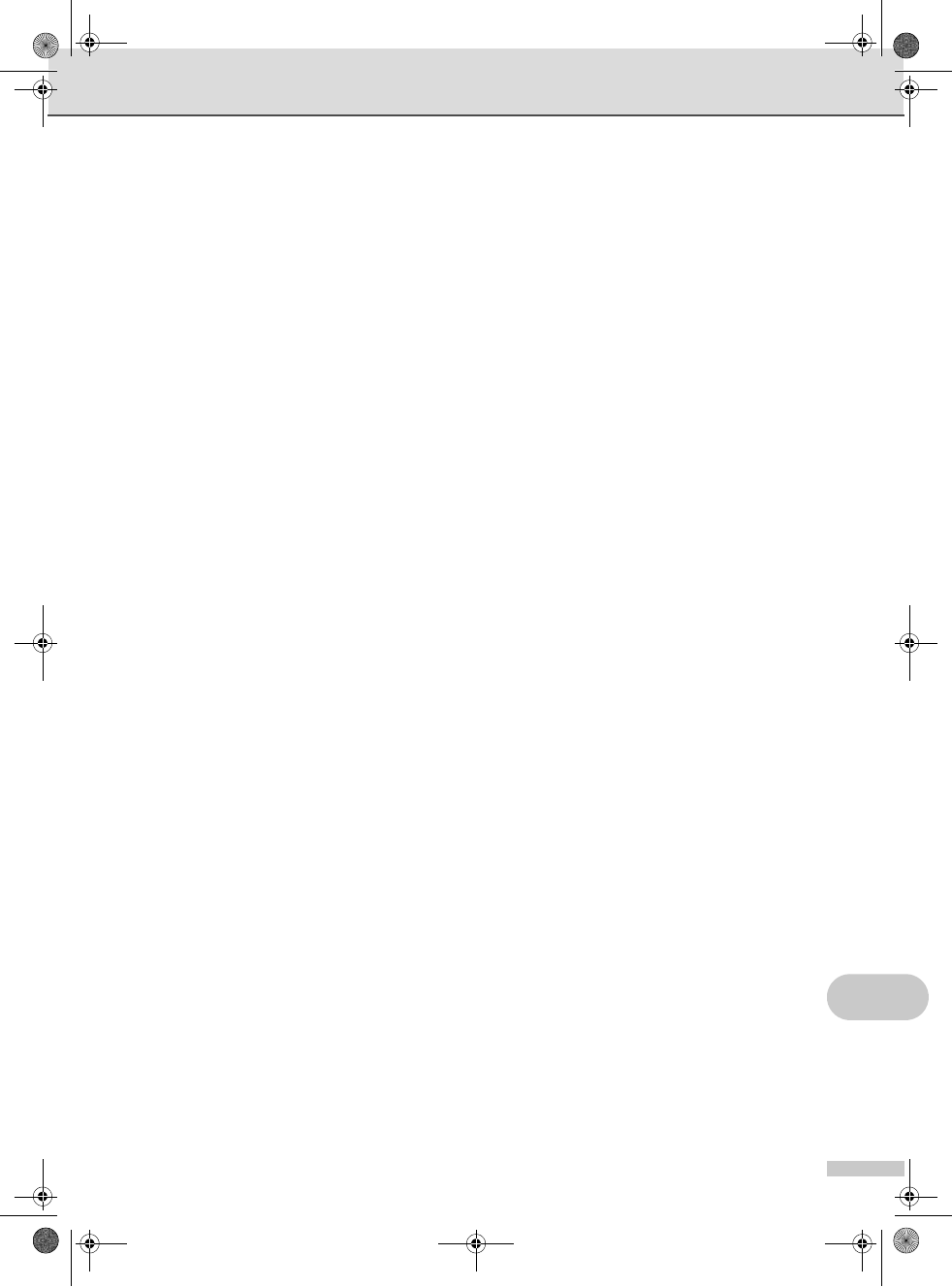
PictBridge
113
15
Understanding the
Error Messages 15
Once you are familiar with the types of errors
that can occur while you are using the
PictBridge, you can easily identify and
troubleshoot any problems.
Out of Memory
This message will appear if you are
working with images that are too large for
the machine's memory.
Wrong USB device
This message will appear if you connect a
non-PictBridge compatible or broken
device to the PictBridge port. To clear the
error, unplug the device from the
PictBridge port, then press On/Off to turn
the machine off and then on again.
See Error messages on page 136 for the
detailed solution.
MFC-440CN_UG_US.book Page 113 Thursday, August 10, 2006 6:59 PM
Color:Blac
k
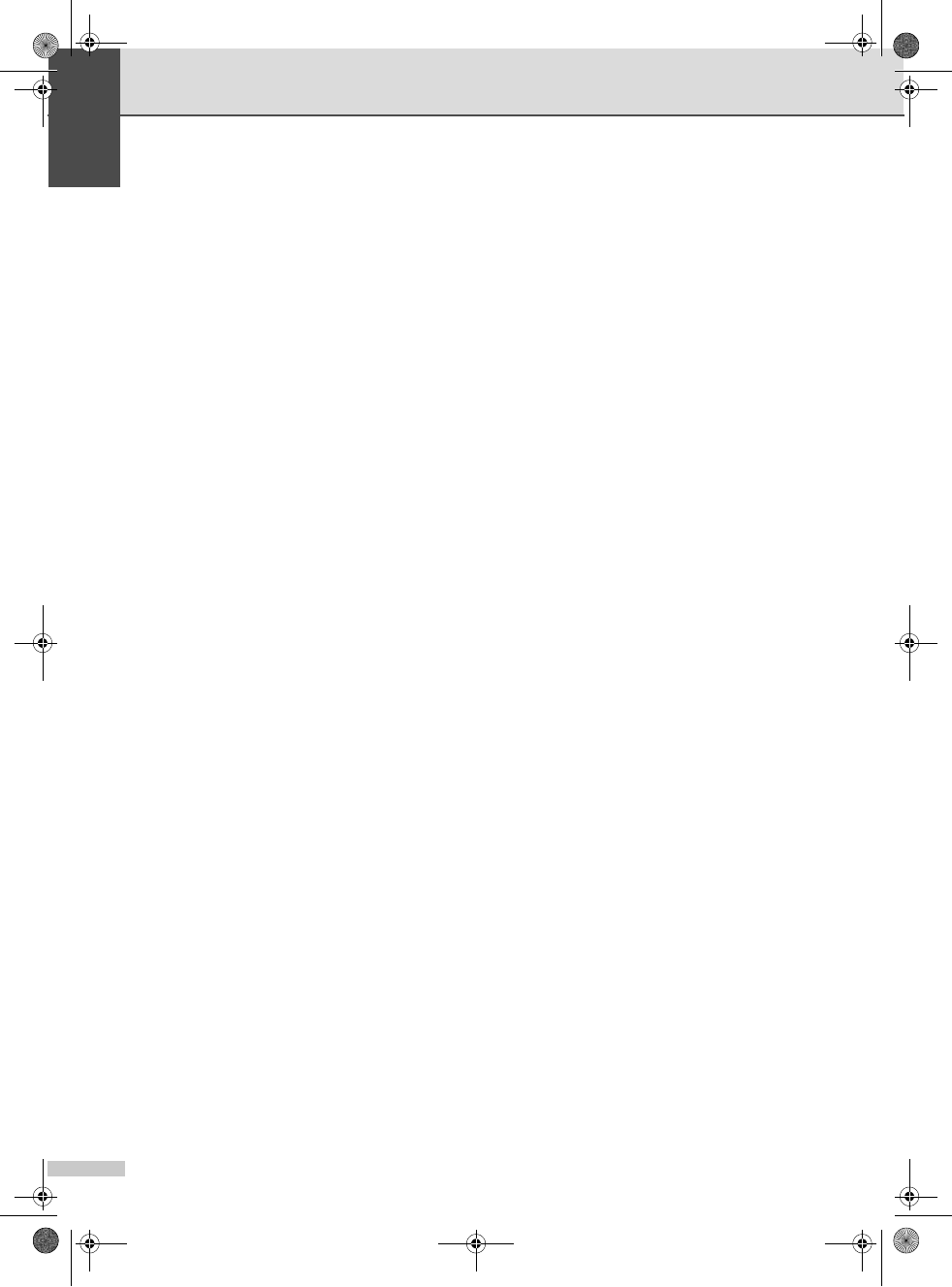
Chapter 15
114
MFC-440CN_UG_US.book Page 114 Thursday, August 10, 2006 6:59 PM
Color:Blac
k
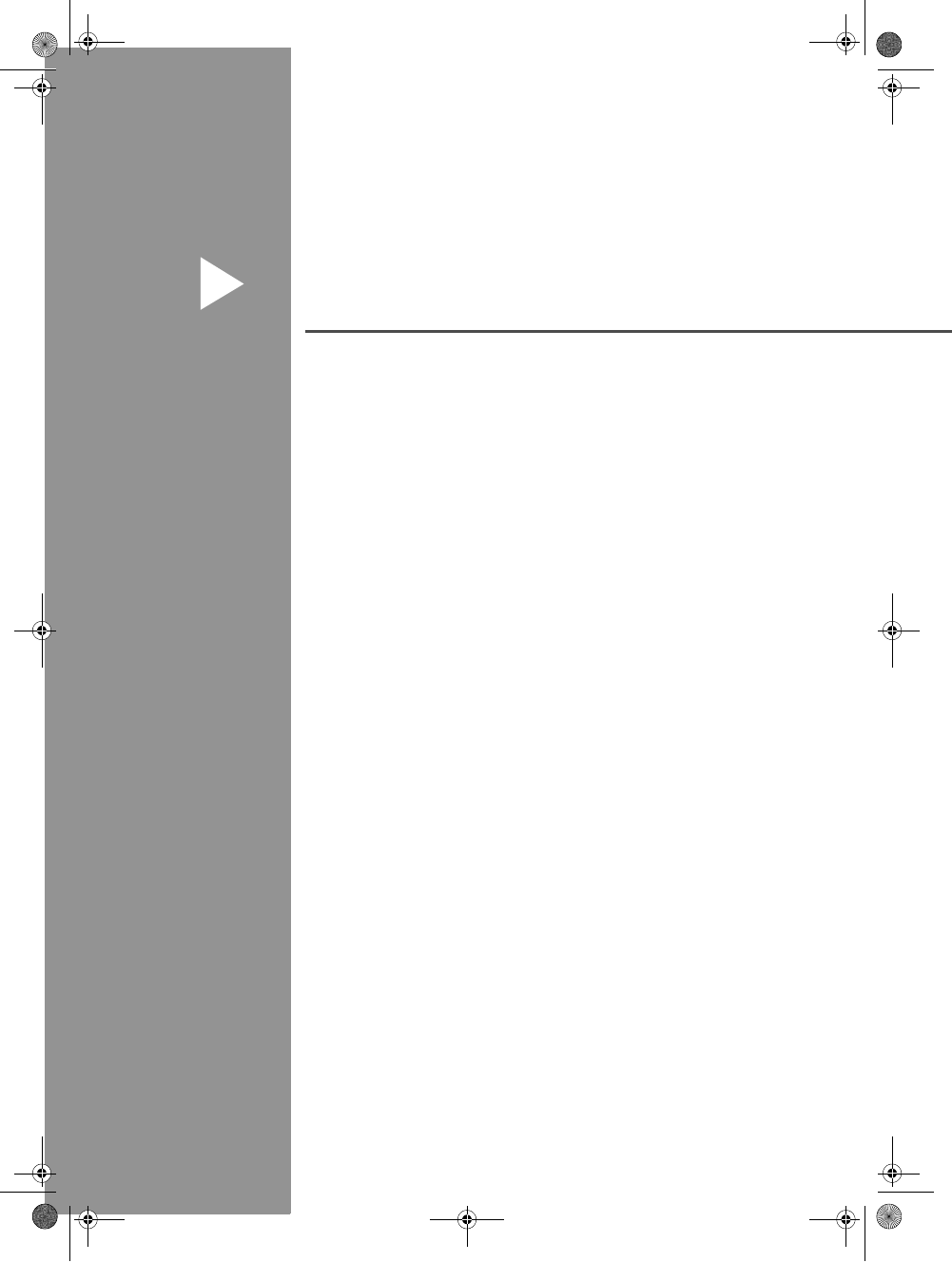
Section V
Software V
Software and Network features 116
MFC-440CN_UG_US.book Page 115 Thursday, August 10, 2006 6:59 PM
Color:Blac
k
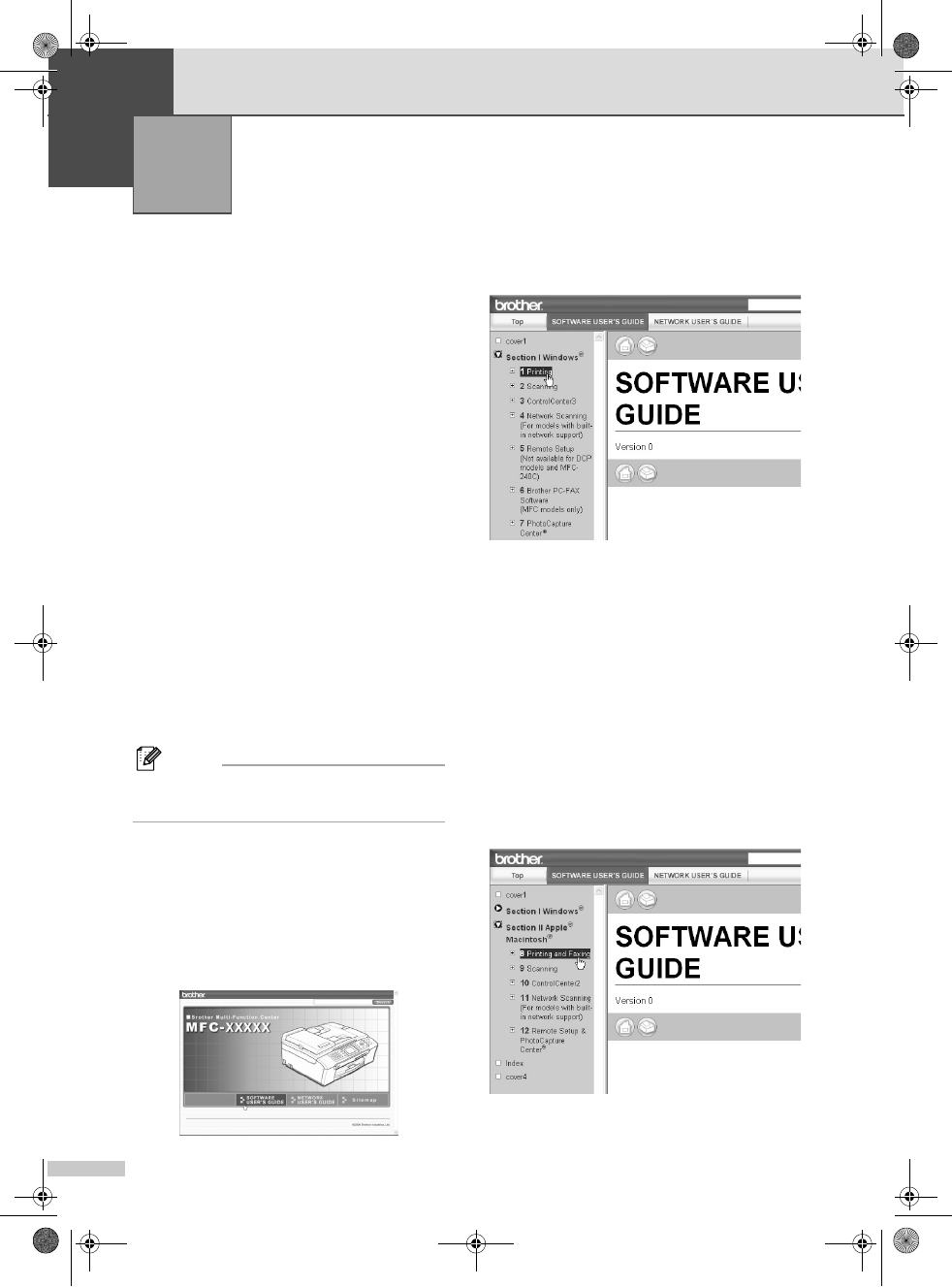
116
16
The CD-ROM includes the Software User’s
Guide and Network User’s Guide for features
available when connected to a computer (for
example, printing and scanning).
These
guides have easy to use links that, when clicked,
will take you directly to a particular section.
You can find information on these features:
Printing
Scanning
ControlCenter3 (for Windows®)
ControlCenter2 (for Macintosh®)
Remote Setup
Faxing from your computer
PhotoCapture Center®
Network Printing
Network Scanning
Wireless Network User’s (MFC-665CW
and MFC-845CW only)
How to read HTML User’s Guide
This is a quick reference for using the HTML
User’s Guide.
(For Windows®)
Note
If you have not installed the software, see
Viewing Documentation on page 2.
aFrom the Start menu, point to Brother,
MFC-XXXX (where XXXX is your model
number) from the programs group, then
click User’s Guide.
bClick SOFTWARE USER’S GUIDE (or
NETWORK USER’S GUIDE) from the
top menu.
cClick the heading you would like to view
from the list at the left of the window.
(For Macintosh®)
aMake sure your Macintosh® is turned
on. Insert the Brother CD-ROM into your
CD-ROM drive.
bDouble-click the Documentation icon.
cDouble-click your language folder, and
then double-click the top page file.
dClick SOFTWARE USER’S GUIDE (or
NETWORK USER’S GUIDE) in the top
menu, and then click the heading you
would like to read from the list at the left
of the window.
Software and Network features 16
MFC-440CN_UG_US.book Page 116 Thursday, August 10, 2006 6:59 PM
Color:Blac
k
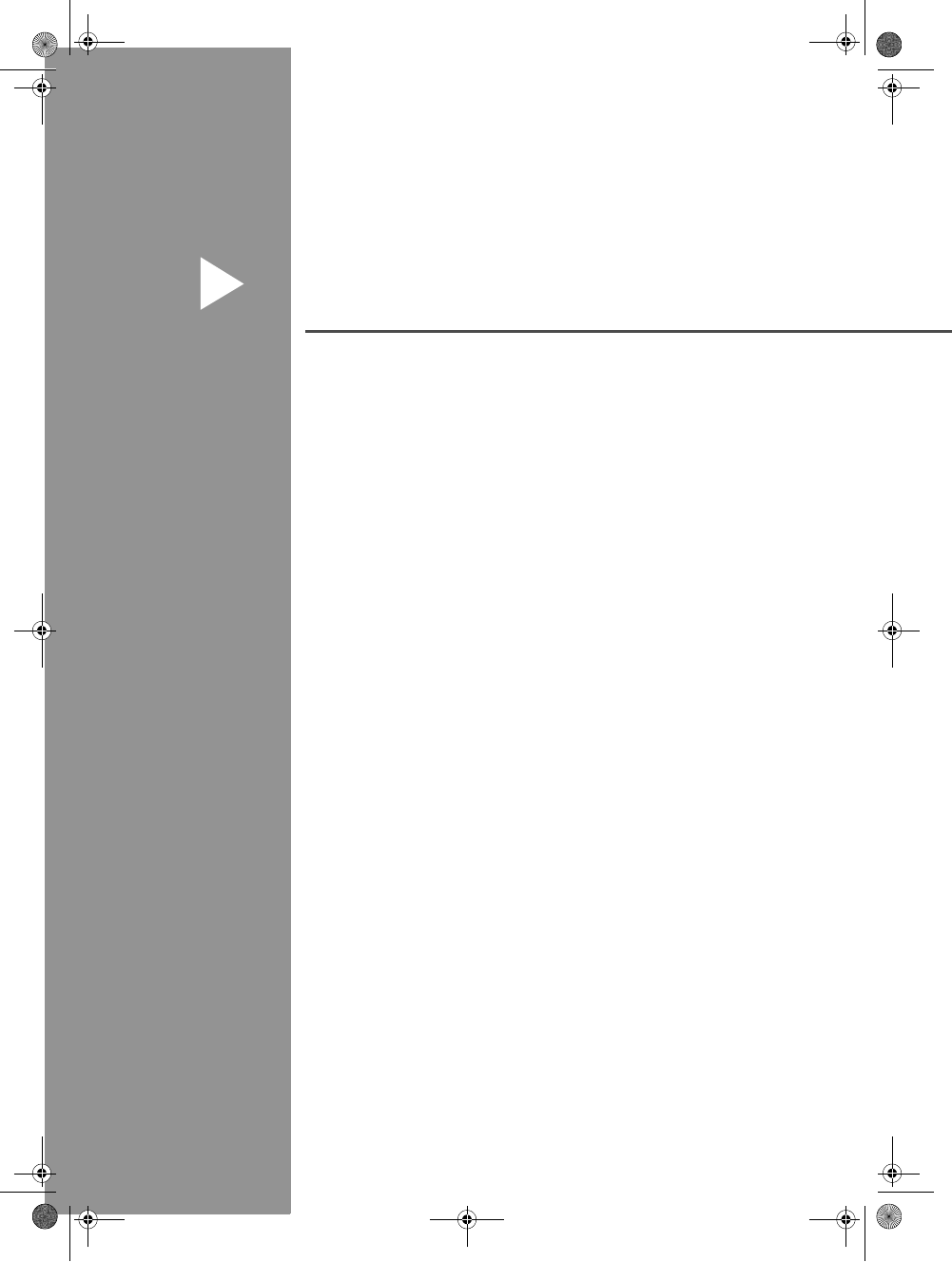
Section VI
Appendixes VI
Safety and Legal 118
Troubleshooting and Routine Maintenance 130
Menu and Features 158
Specifications 175
Glossary 191
MFC-440CN_UG_US.book Page 117 Thursday, August 10, 2006 6:59 PM
Color:Blac
k

118
A
Choosing a location A
Put your machine on a flat, stable surface that is free of vibration and shocks, such as a desk. Put
the machine near a telephone wall jack and a standard AC power outlet. Choose a location where
the temperature remains between 50°F and 95°F (10° and 35°C).
CAUTION
• Avoid placing your machine in a high-traffic area.
• Avoid placing your machine on a carpet.
• DO NOT put the machine near heaters, air conditioners, refrigerators, medical equipment,
chemicals or water.
• DO NOT expose the machine to direct sunlight, excessive heat, moisture, or dust.
• DO NOT connect your machine to electrical outlets controlled by wall switches or automatic
timers.
• Disruption of power can wipe out information in the machine's memory.
• Do NOT connect your machine to electrical outlets on the same circuit as large appliances
or other equipment that might disrupt the power supply.
• Avoid interference sources, such as speakers or the base units of non-Brother cordless
phones.
• DO NOT place the MFC-845CW and the cordless handset near electro-medical equipment.
Safety and Legal A
MFC-440CN_UG_US.book Page 118 Thursday, August 10, 2006 6:59 PM
Color:Blac
k
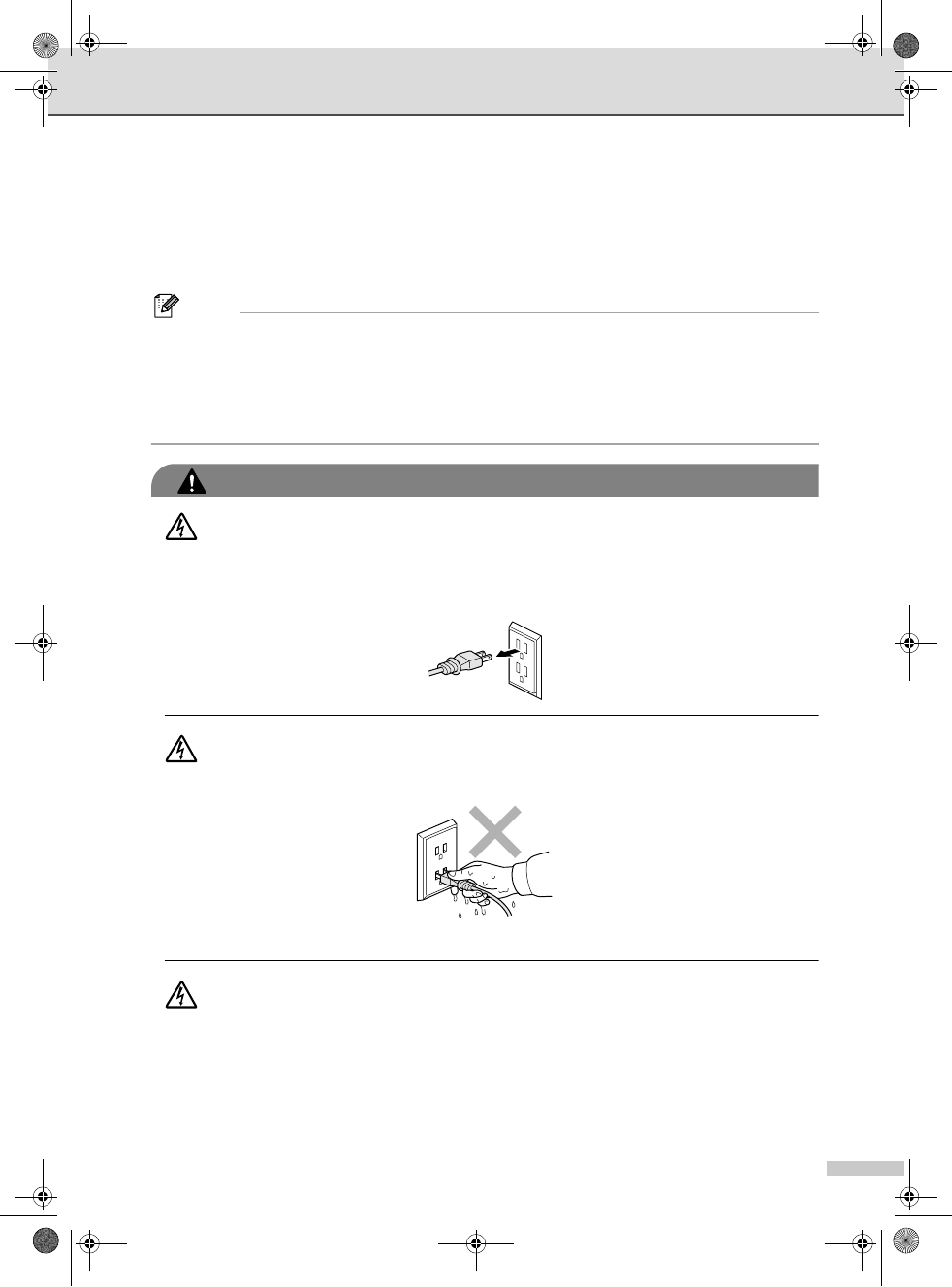
Safety and Legal
119
To use the machine safely A
Please keep these instructions for later reference and read them before attempting any
maintenance.
Note
(MFC-665CW and MFC-845CW only)
If there are faxes in the machine's memory, you need to print them or save them before you
unplug the machine from the AC power outlet for more than 24 hours. (To print the faxes in
memory, see Printing a fax from the memory on page 51. To save the faxes in memory, see
Transferring faxes to another fax machine on page 139 or Transferring faxes to your
PC on page 139.)
WARNING
There are high voltage electrodes inside the machine. Before you clean the inside of the
machine, make sure you have unplugged the telephone line cord first and then the power cord
from the AC power outlet. Doing this will prevent an electrical shock.
DO NOT handle the plug with wet hands. Doing this might cause an electrical shock.
Always make sure the plug is fully inserted.
DO NOT pull on the middle of the AC power cord. Doing this might cause an electrical shock.
MFC-440CN_UG_US.book Page 119 Thursday, August 10, 2006 6:59 PM
Color:Blac
k
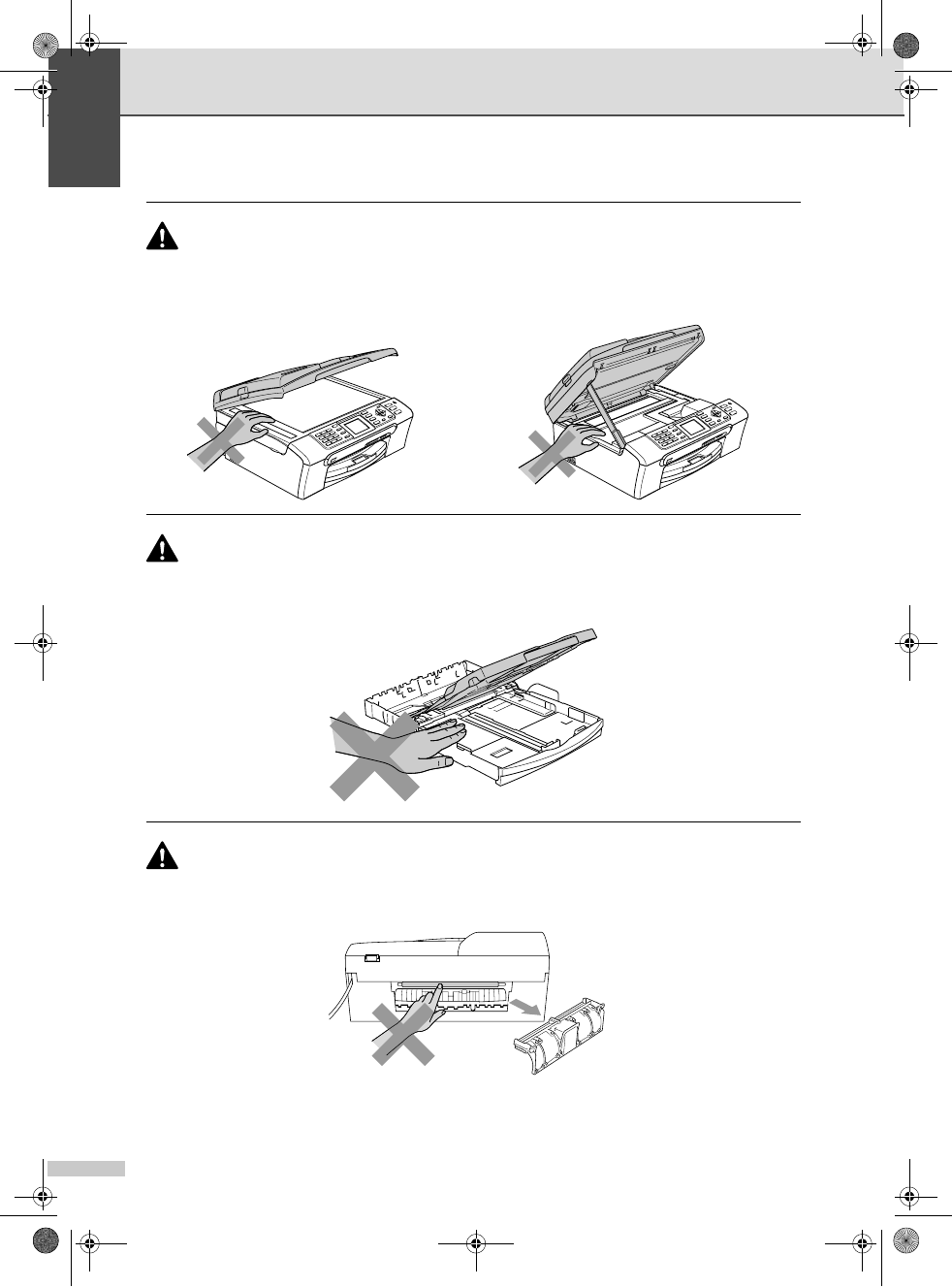
120
DO NOT put your hands on the edge of the machine under the document cover or the scanner
cover. Doing this may cause injury.
DO NOT put your hands on the edge of the paper tray under the output paper tray cover. Doing
this may cause injury.
DO NOT touch the paper feed roller. Doing this may cause injury.
MFC-440CN_UG_US.book Page 120 Thursday, August 10, 2006 6:59 PM
Color:Blac
k
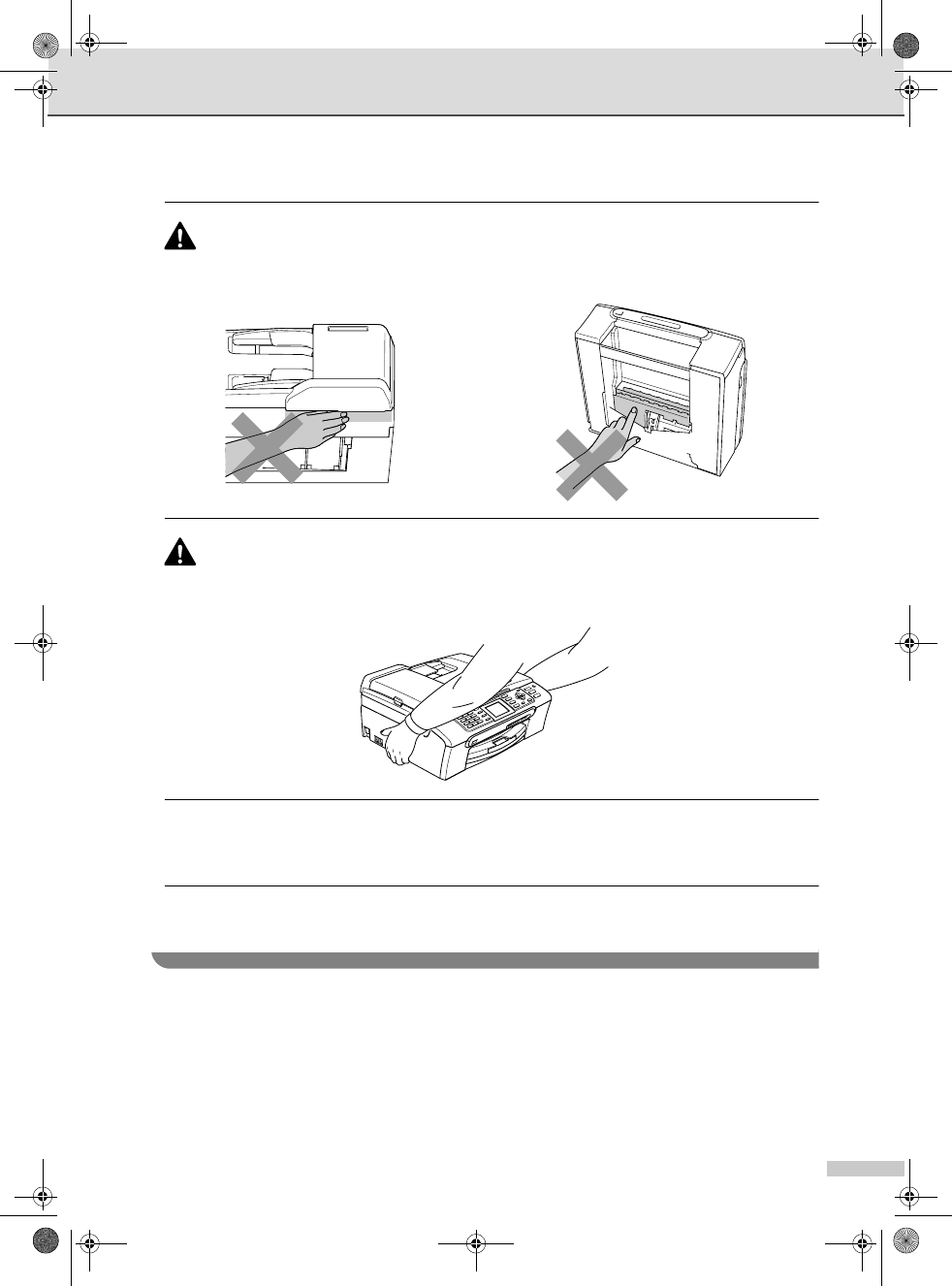
Safety and Legal
121
DO NOT touch the area shaded in the illustration. Doing this may cause injury.
When moving the machine you must lift it from the base, by placing a hand at each side of the
unit as shown in the illustration. Do not carry the machine by holding the scanner cover.
If the machine becomes hot, releases smoke, or generates any strong smells, immediately
unplug the machine from the AC power outlet. Call Brother Customer Service (See Brother
numbers on page i.).
If metal objects, water or other liquids get inside the machine, immediately unplug the machine
from the AC power outlet. Call Brother Customer Service (See Brother numbers on page i.).
MFC-440CN_UG_US.book Page 121 Thursday, August 10, 2006 6:59 PM
Color:Blac
k
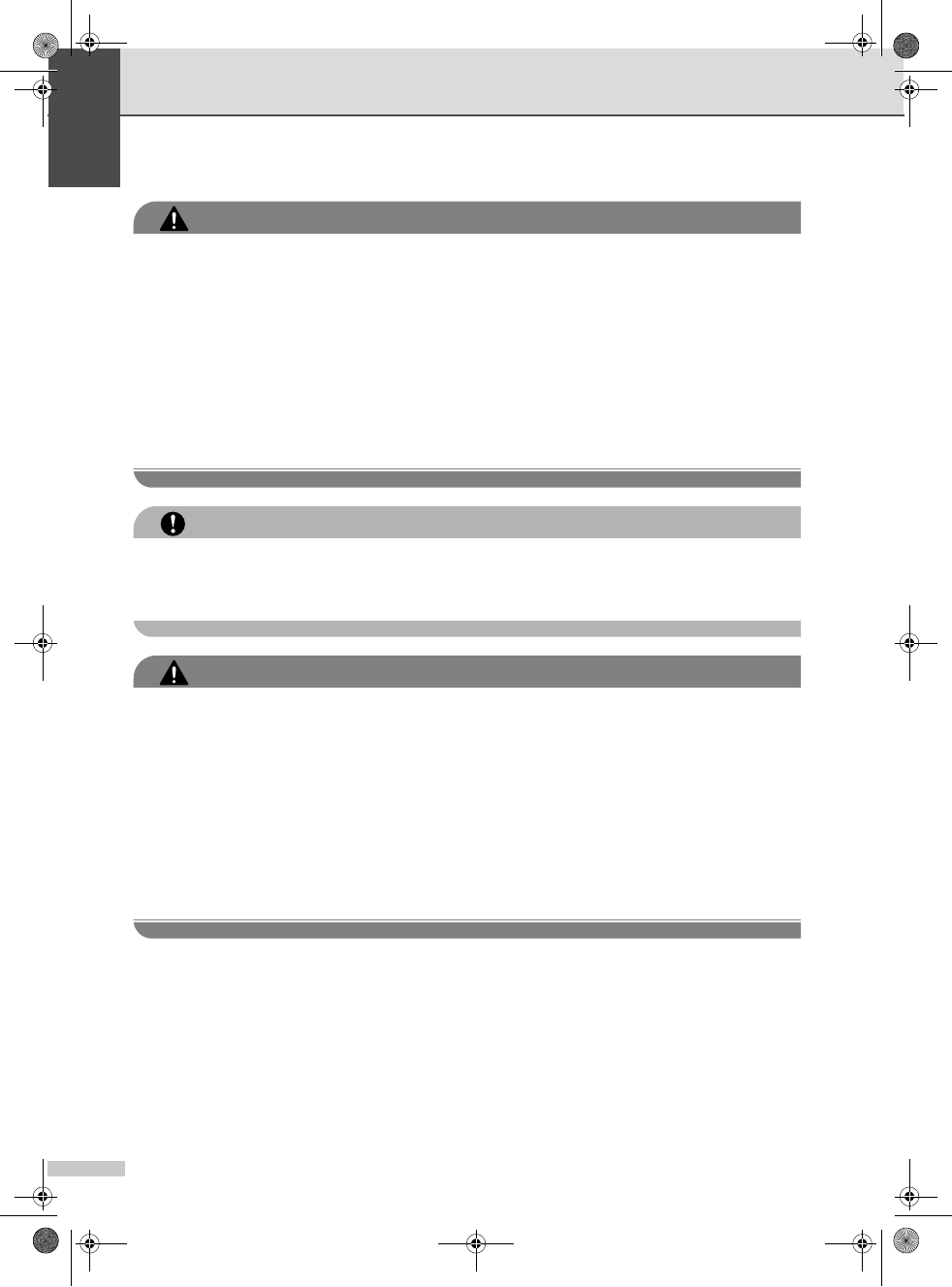
122
WARNING
• Use caution when installing or modifying telephone lines. Never touch telephone wires or
terminals that are not insulated unless the telephone line has been unplugged at the wall
jack. Never install telephone wiring during a lightning storm. Never install a telephone wall
jack in a wet location.
• This product must be installed near an AC power outlet that is easily accessible. In case of
an emergency, you must unplug the power cord from the AC power outlet to shut off the
power completely.
• Always make sure the plug is fully inserted.
• To reduce the risk of shock or fire, use only a No. 26 AWG or larger telecommunication line
cord.
CAUTION
Lightning and power surges can damage this product! We recommend that you use a quality
surge protection device on the AC power line and on the telephone line, or unplug the cords
during a lightning storm.
WARNING
IMPORTANT SAFETY INSTRUCTIONS
When using your telephone equipment, basic safety precautions should always be followed to
reduce the risk of fire, electric shock and injury to people, including the following:
1 DO NOT use this product near water, for example, near a bath tub, wash bowl, kitchen sink
or washing machine, in a wet basement or near a swimming pool.
2 Avoid using this product during an electrical storm. There may be a remote risk of electric
shock from lightning.
3 DO NOT use this product to report a gas leak in the vicinity of the leak.
4 Use only the power cord provided with the machine.
MFC-440CN_UG_US.book Page 122 Thursday, August 10, 2006 6:59 PM
Color:Blac
k
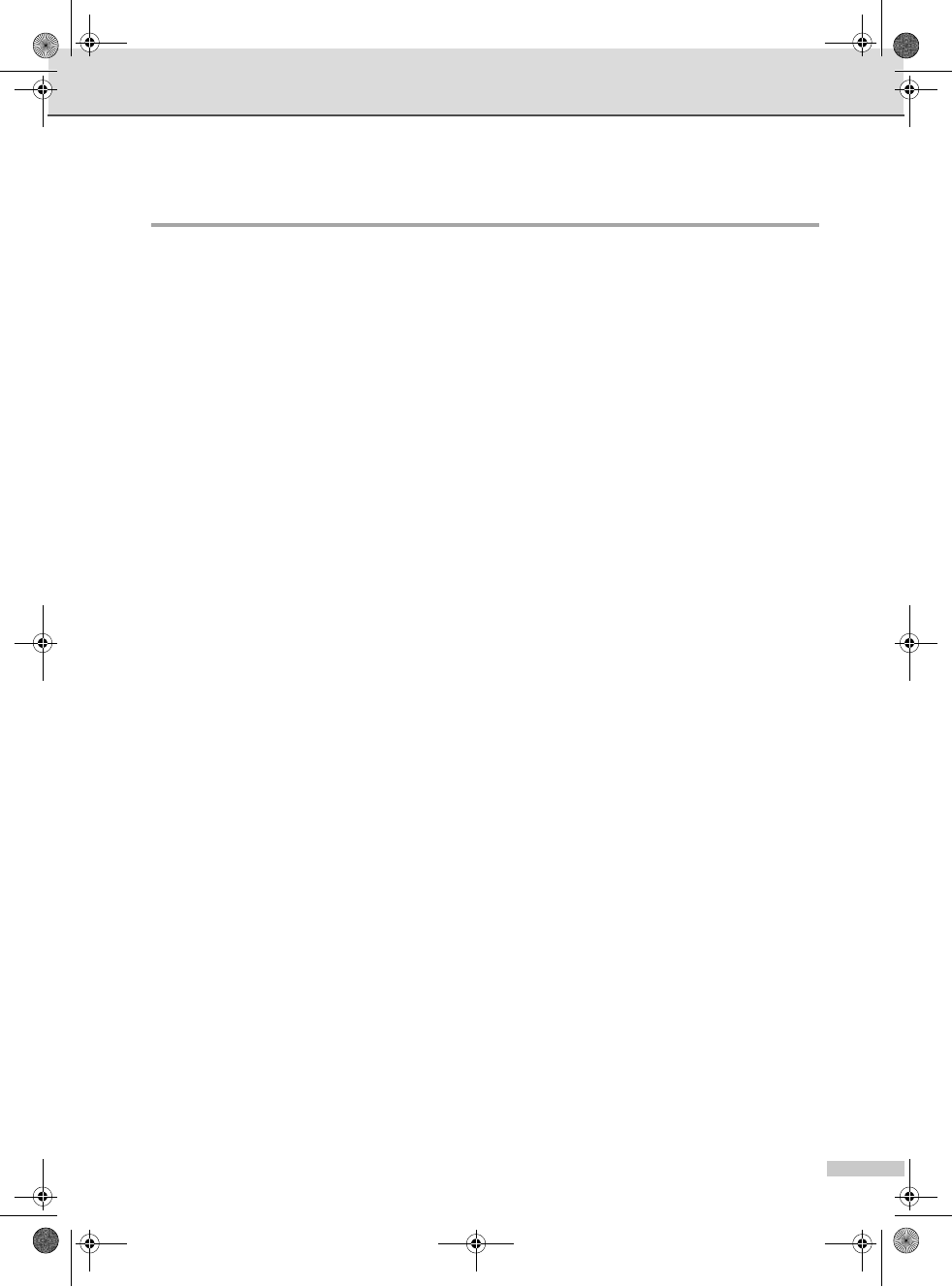
Safety and Legal
123
Important safety instructions A
1 Read all of these instructions.
2 Save them for later reference.
3 Follow all warnings and instructions marked on the product.
4 Unplug this product from the wall outlet before cleaning the inside of the machine. Do not use
liquid or aerosol cleaners. Use a damp cloth for cleaning.
5 Do not use this product near water.
6 Do not place this product on an unstable cart, stand, or table. The product may fall, causing
serious damage to the product.
7 Slots and openings in the cabinet and the back or bottom are provided for ventilation. To
ensure reliable operation of the product and to protect it from overheating, these openings
must not be blocked or covered. The openings should never be blocked by placing the product
on a bed, sofa, rug, or other similar surface. This product should never be placed near or over
a radiator or heater. This product should never be placed in a built-in installation unless proper
ventilation is provided.
8 This product should be operated from the type of power source indicated on the label. If you
are not sure of the type of power available, call your dealer or local power company.
9 Use only the power cord supplied with this machine.
10 Do not allow anything to rest on the power cord. Do not place this product where people can
walk on the cord.
11 If an extension cord is used with this product, make sure that the total ampere ratings of the
products plugged into the extension cord do not exceed the extension cord ampere rating.
Also, make sure that the total of all products plugged into the AC power outlet does not exceed
15 amperes (USA only).
12 Do not place anything in front of the machine that will block received faxes. Do not place
anything in the path of received faxes.
13 Wait until pages have exited the machine before picking them up.
14 Never push objects of any kind into this product through cabinet slots, since they may touch
dangerous voltage points or short out parts resulting in the risk of fire or electric shock. Never
spill liquid of any kind on the product. Do not attempt to service this product yourself because
opening or removing covers may expose you to dangerous voltage points and other risks and
may void your warranty. Refer all servicing to a Brother Authorized Service Center. For the
location of your nearest Brother Authorized Service Center, please call the following:
In USA: 1-800-284-4357
In Canada: 1-877-BROTHER
MFC-440CN_UG_US.book Page 123 Thursday, August 10, 2006 6:59 PM
Color:Blac
k
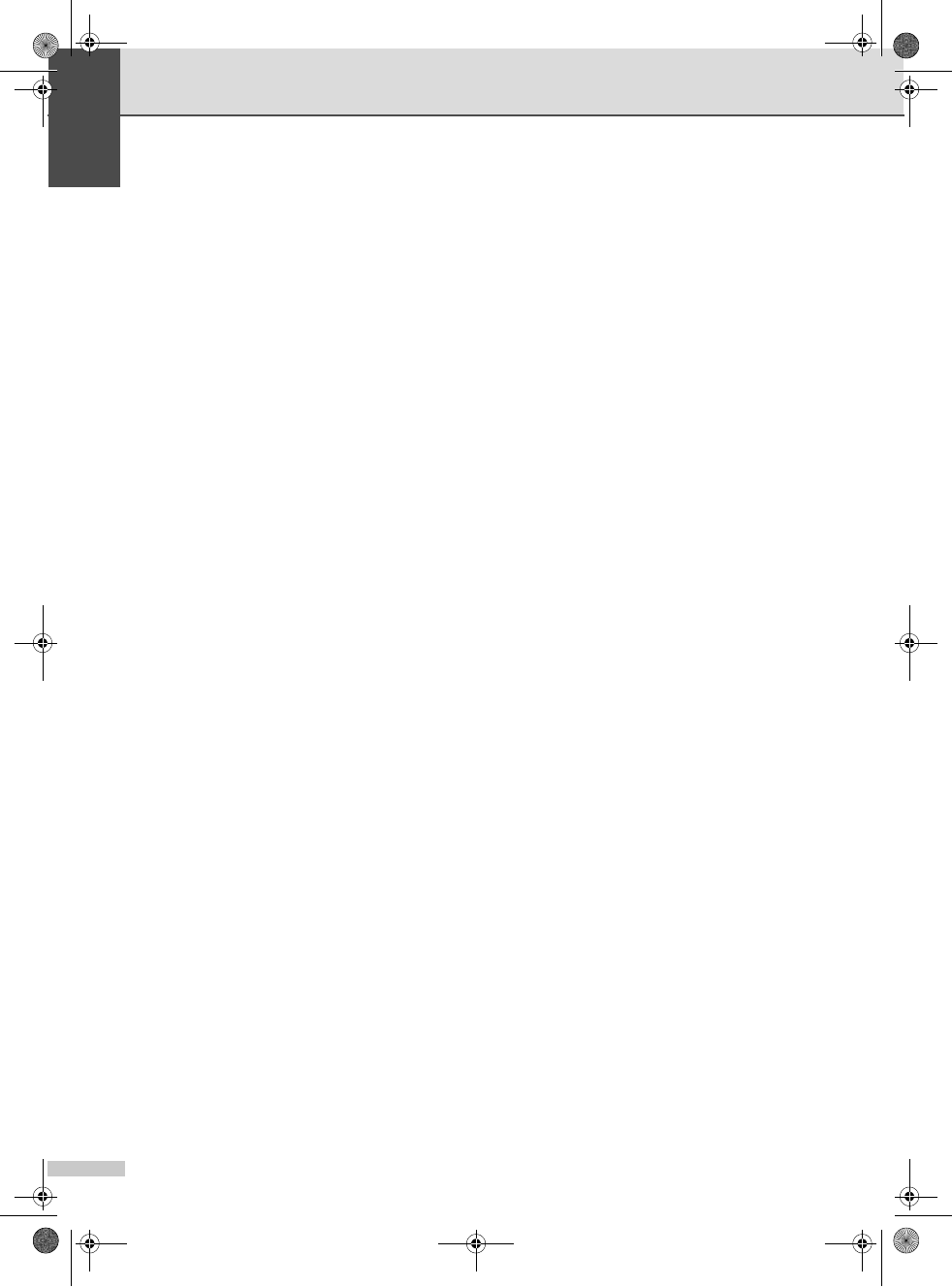
124
15 Unplug this product from the AC power outlet and refer all servicing to Brother Authorized
Service Personnel under the following conditions:
When the power cord is damaged or frayed.
If liquid has been spilled into the product.
If the product has been exposed to rain or water.
If the product does not operate normally when the operating instructions are followed,
adjust only those controls that are covered by the operating instructions. Improper
adjustment of other controls may result in damage and will often require extensive work by
a qualified technician to restore the product to normal operation.
If the product has been dropped or the cabinet has been damaged.
If the product exhibits a distinct change in performance, indicating a need for service.
16 To protect your product against power surges, we recommend the use of a power protection
device (Surge Protector).
17 To reduce the risk of fire, electric shock and injury to people, note the following:
Do not use this product near appliances that use water, a swimming pool, or in a wet
basement.
Do not use the machine during an electrical storm (there is the remote possibility of an
electrical shock) or to report a gas leak in the vicinity of the leak.
18 Caution - To reduce the risk of fire, use only No.26 AWG or larger telecommunication line cord.
MFC-440CN_UG_US.book Page 124 Thursday, August 10, 2006 6:59 PM
Color:Blac
k
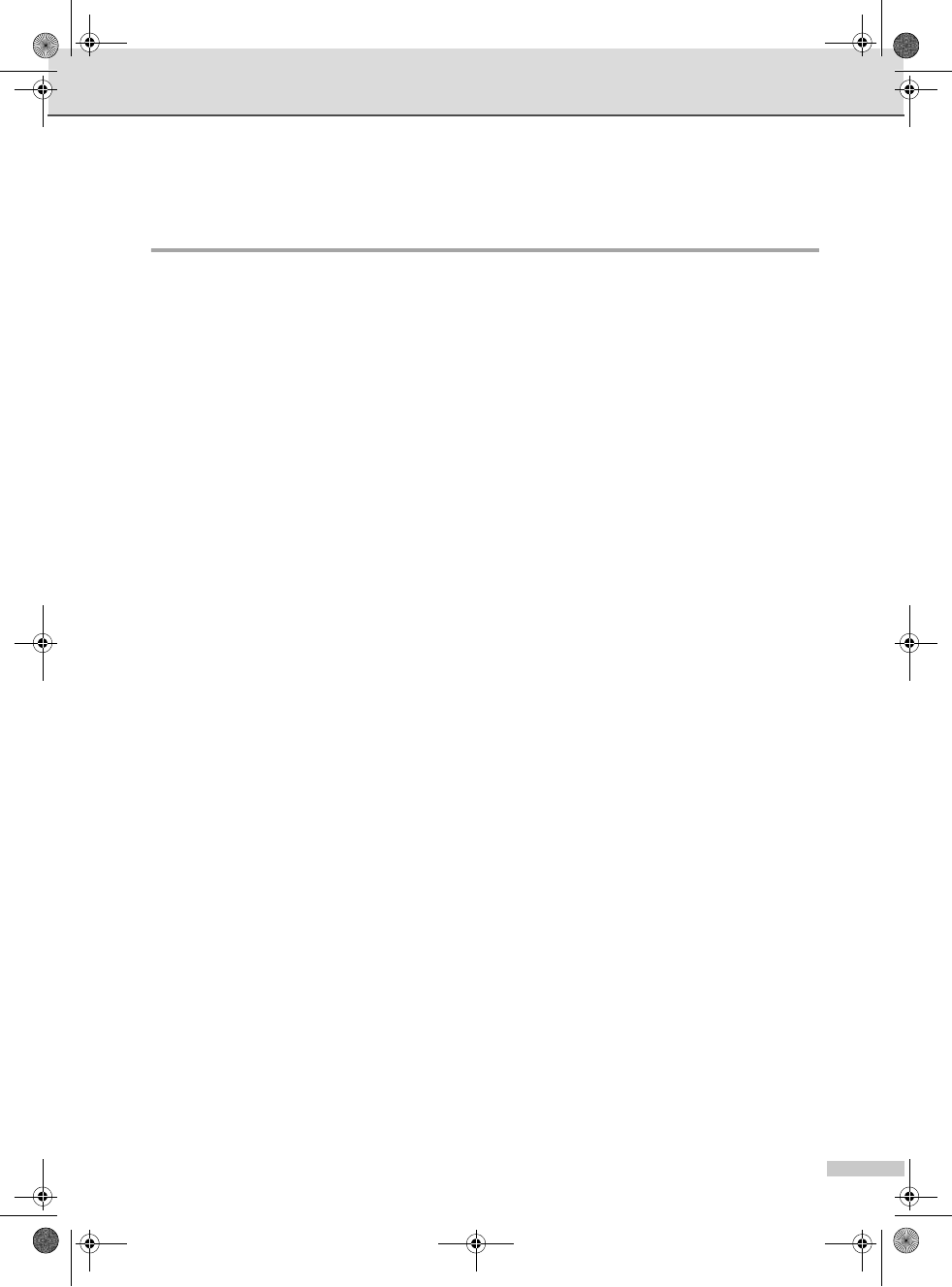
Safety and Legal
125
Standard telephone and FCC Notices (These notices are in effect
on models sold and used in the United States only.) A
This equipment is hearing-aid compatible. (MFC-665CW and MFC-845CW only)
When programming emergency numbers or making test calls to emergency numbers:
Remain on the line and briefly explain to the dispatcher the reason for the call before hanging
up.
Perform these activities in the off-peak hours, such as early morning or late evening.
This equipment complies with Part 68 of the FCC rules and the requirements adopted by the
ACTA. On the backside of this equipment is a label that contains, among other information, a
product identifier in the format US: AAAEQ##TXXXX. If requested, this number must be provided
to the telephone company.
You may safely connect this equipment to the telephone line by means of a standard modular jack,
USOC RJ11C.
A plug and jack used to connect this equipment to the premises wiring and telephone network
must comply with the applicable FCC Part 68 rules and requirements adopted by the ACTA. A
compliant telephone cord and modular plug is provided with this product. It is designed to be
connected to a compatible modular jack that is also compliant. See installation instructions for
details.
The REN is used to determine the number of devices that may be connected to a telephone line.
Excessive RENs on a telephone line may result in the devices not ringing in response to an
incoming call. In most but not all areas, the sum of RENs should not exceed five (5.0). To be
certain of the number of devices that may be connected to a line, as determined by the total RENs,
contact the local telephone company. For products approved after July 23, 2001, the REN for this
product is part of the product identifier that has the format US:AAAEQ##TXXXX.The digits
represented by ## are the REN without a decimal point (e.g., 06 is a REN of 0.6). For earlier
products, the REN is separately shown on the label.
If this equipment causes harm to the telephone network, the telephone company will notify you in
advance that temporary discontinuance of service may be required. But if advance notice isn't
practical, the telephone company will notify the customer as soon as possible. Also, you will be
advised of your right to file a complaint with the FCC if you believe it is necessary.
The telephone company may make changes in its facilities, equipment, operations or procedures
that could affect the operation of the equipment. If this happens the telephone company will
provide advance notice in order for you to make necessary modifications to maintain uninterrupted
service.
If trouble is experienced with this equipment, for repair or warranty information, please contact
Brother Customer Service. (See Brother numbers on page i.) If the equipment is causing harm to
the telephone network, the telephone company may request that you disconnect the equipment
until the problem is resolved.
Connection to party line service is subject to state tariffs. Contact the state public utility
commission, public service commission or corporation commission for information.
If your home has specially wired alarm equipment connected to the telephone line, ensure the
installation of this equipment does not disable your alarm equipment. If you have questions about
what will disable alarm equipment, call your telephone company or a qualified installer.
MFC-440CN_UG_US.book Page 125 Thursday, August 10, 2006 6:59 PM
Color:Blac
k
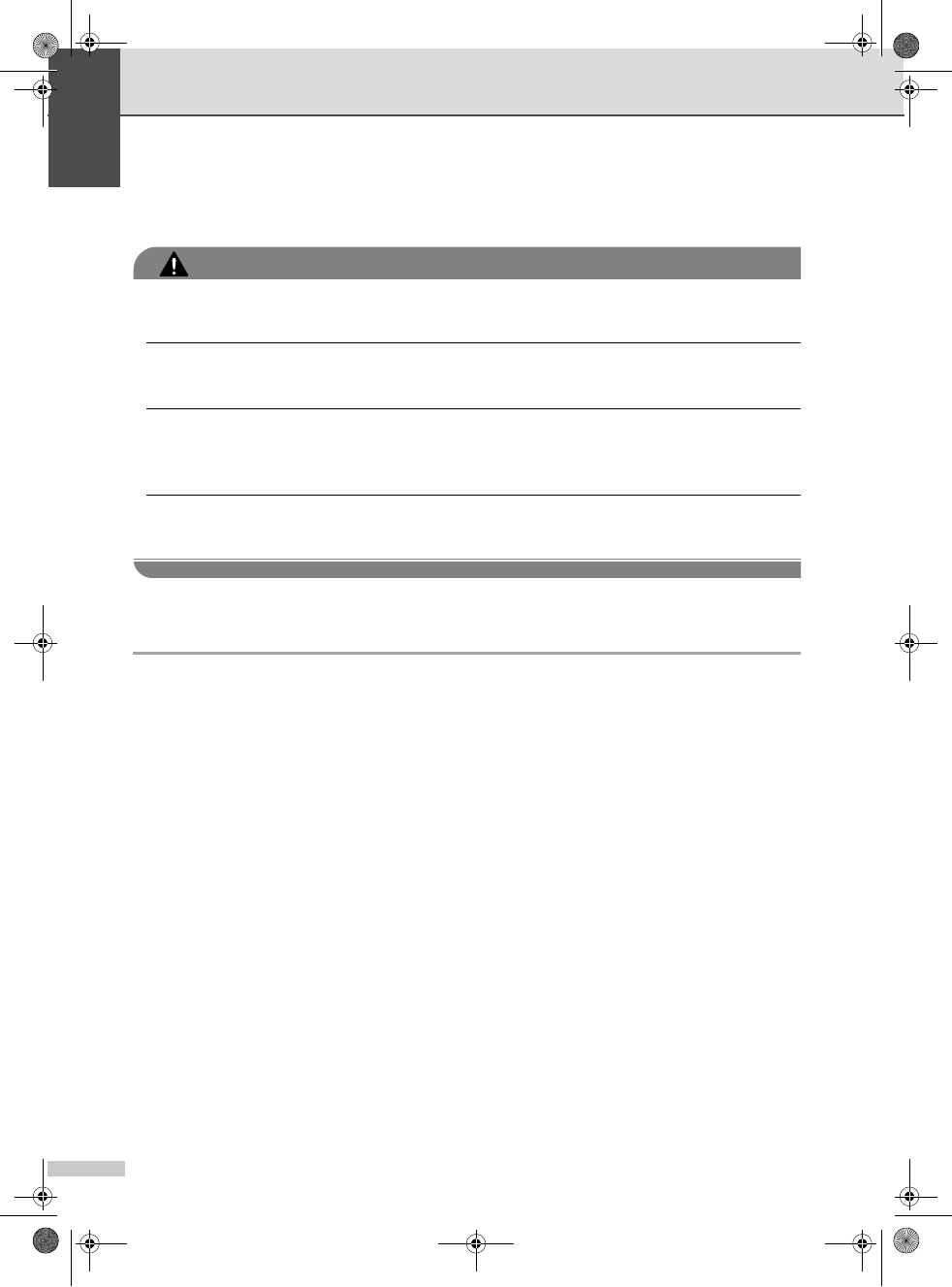
126
If you are not able to solve a problem with your machine, call Brother Customer Service. (See
Brother numbers on page i.)
WARNING
For protection against the risk of electrical shock, always disconnect all cables from the wall
outlet before servicing, modifying or installing the equipment.
This equipment may not be used on coin service lines provided by the telephone company or
connected to party lines.
Brother cannot accept any financial or other responsibilities that may be the result of your use
of this information, including direct, special or consequential damages. There are no warranties
extended or granted by this document.
This machine has been certified to comply with FCC standards, which are applied to the USA
only.
Federal Communications Commission (FCC) Declaration of
Conformity (USA only) A
declares, that the products
Product Name: MFC-440CN, MFC-665CW and MFC-845CW
comply with Part 15 of the FCC Rules. Operation is subject to the following two conditions: (1) This
device may not cause harmful interference, and (2) this device must accept any interference
received, including interference that may cause undesired operation.
This equipment has been tested and found to comply with the limits for a Class B digital device,
pursuant to Part 15 of the FCC Rules. These limits are designed to provide reasonable protection
against harmful interference in a residential installation. This equipment generates, uses, and can
radiate radio frequency energy and, if not installed and used in accordance with the instructions,
may cause harmful interference to radio communications. However, there is no guarantee that
interference will not occur in a particular installation. If this equipment does cause harmful
interference to radio or television reception, which can be determined by turning the equipment
off and on, the user is encouraged to try to correct the interference by one or more of the following
measures:
Responsible
Party:
Brother International
Corporation
100 Somerset Corporate
Boulevard
Bridgewater, NJ 08807-0911
USA
TEL: (908) 704-1700
MFC-440CN_UG_US.book Page 126 Thursday, August 10, 2006 6:59 PM
Color:Blac
k
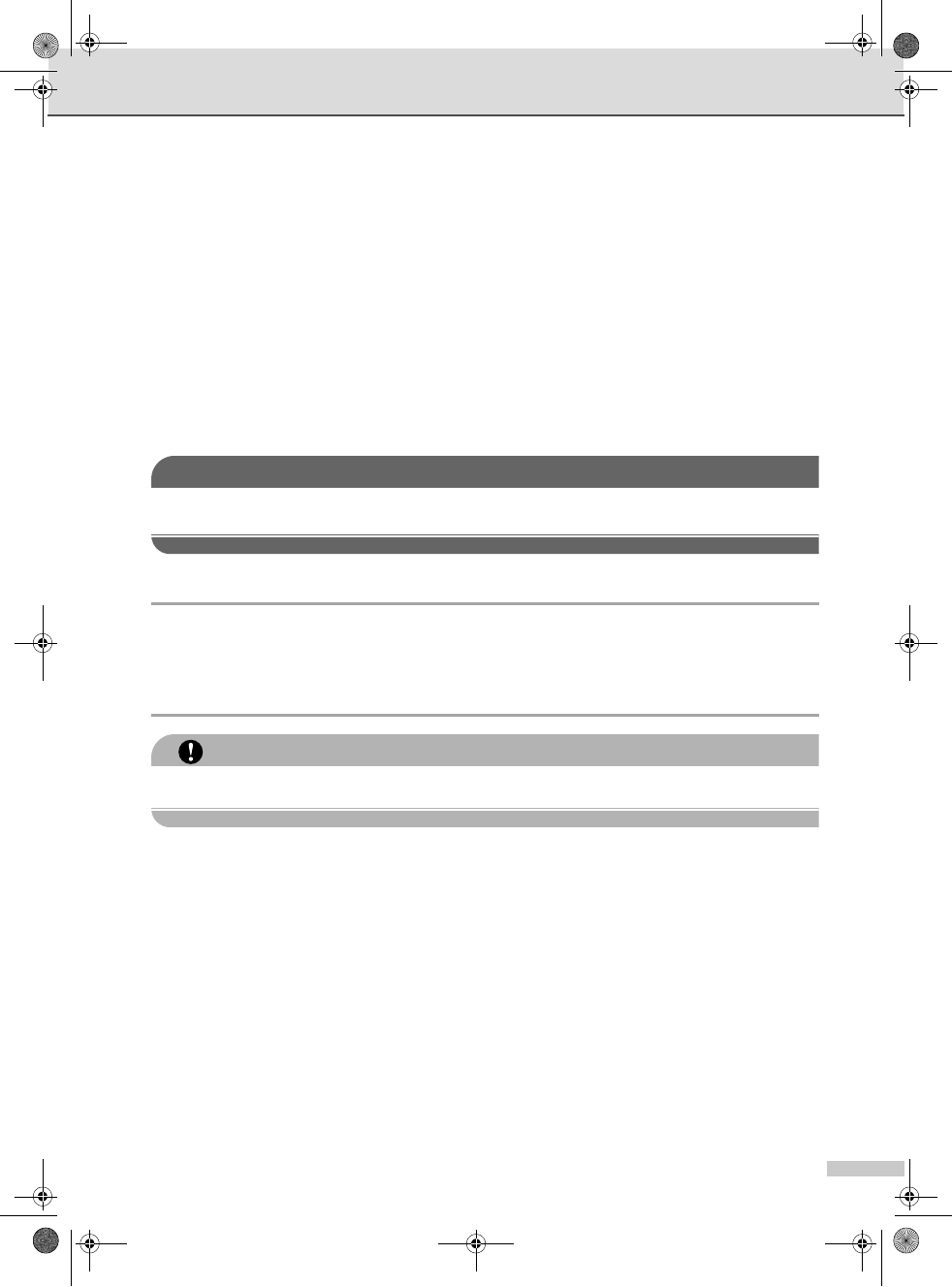
Safety and Legal
127
Reorient or relocate the receiving antenna.
Increase the separation between the equipment and receiver.
Connect the equipment into an outlet on a circuit different from that to which the receiver is
connected.
Call the dealer or an experienced radio/TV technician for help.
This transmitter must not be co-located or operated in conjunction with any other antenna or
transmitter.
This equipment complies with FCC radiation exposure limits set forth for uncontrolled
equipment and meets the FCC radio frequency (RF) Exposure Guidelines in Supplement C to
OET65. This equipment should be installed and operated with at least 20cm and more
between the radiator and person's body (excluding extremities: hands, wrists, feet and legs).
IMPORTANT
Changes or modifications not expressly approved by Brother Industries, Ltd. could void the
user's authority to operate the equipment.
Industry Canada Compliance Statement (Canada only) A
This Class B digital apparatus complies with Canadian ICES-003.
Cet appareil numérique de la classe B est conforme à la norme NMB-003 du Canada.
LAN connection A
CAUTION
DO NOT connect this product to a LAN connection that is subject to over-voltages.
MFC-440CN_UG_US.book Page 127 Thursday, August 10, 2006 6:59 PM
Color:Blac
k
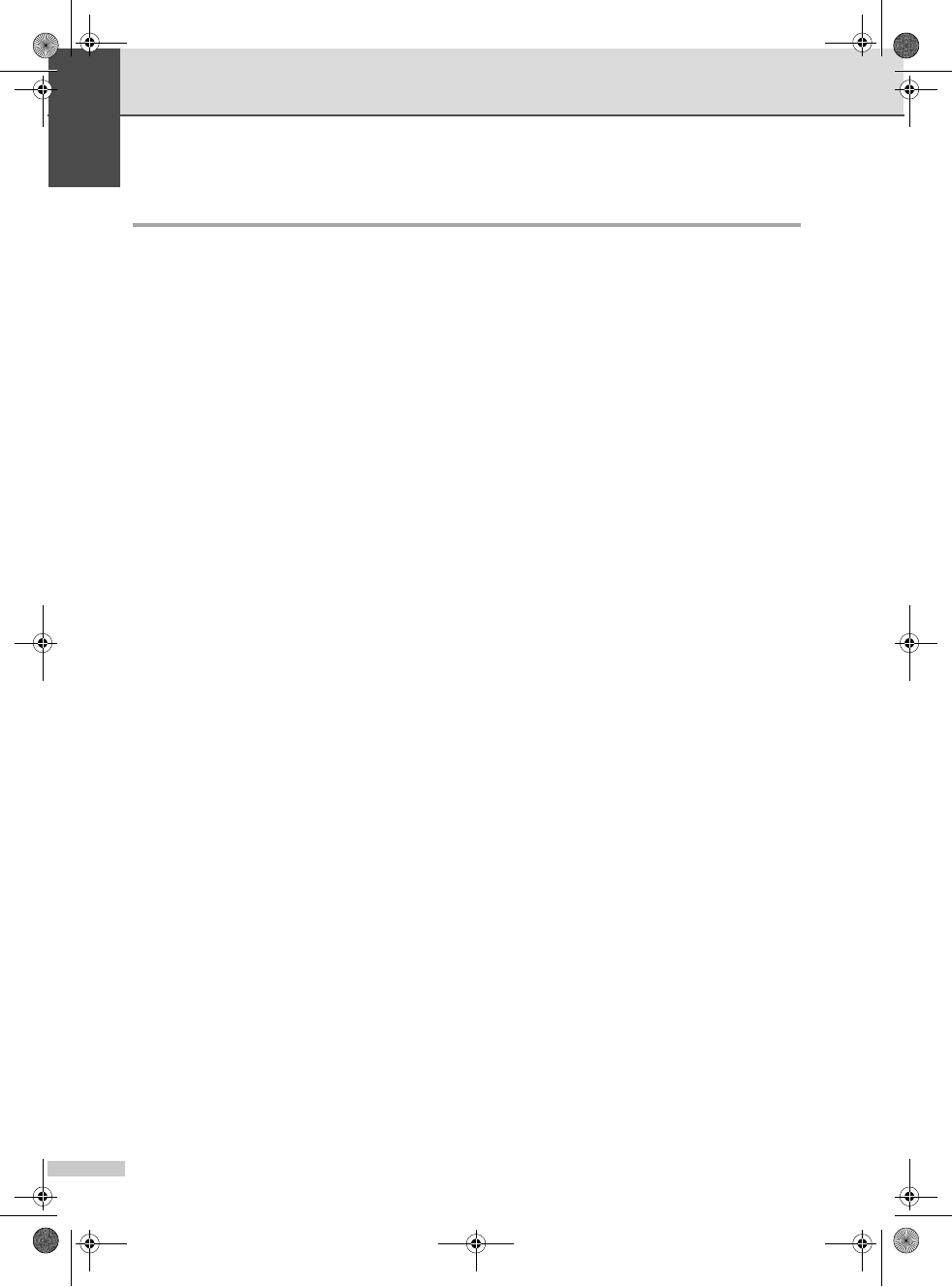
128
Legal limitations for copying A
It is offence to make color reproductions of certain instruments with the froudulent intension. This
memorandum is intended to be a guide rather than a complete listing of every possible prohibition.
In case of doubt, we suggest that you check with counsel as to any particular questionable
documents.
The following documents issued by the United States/Canadian Government or any of its
Agencies may not be copied:
Money
Bonds or other certificates of indebtedness
Certificates of Deposit
Internal Revenue Stamps (canceled or uncanceled)
Selective Service or draft papers
Passports
United States/Canadian Postage Stamps (canceled or uncanceled)
Food Stamps
Immigration Papers
Checks or drafts drawn by Governmental agencies
Identifying badges or insignias
Copyrighted works cannot be copied. Sections of a copyrighted work can be copied for ‘fair use.’
Multiple copies would indicate improper use.
Works of art should be considered the equivalent of copyrighted works.
Licenses and Certificates of Title to motor vehicles may not be copied under certain
state/provincial laws.
MFC-440CN_UG_US.book Page 128 Thursday, August 10, 2006 6:59 PM
Color:Blac
k
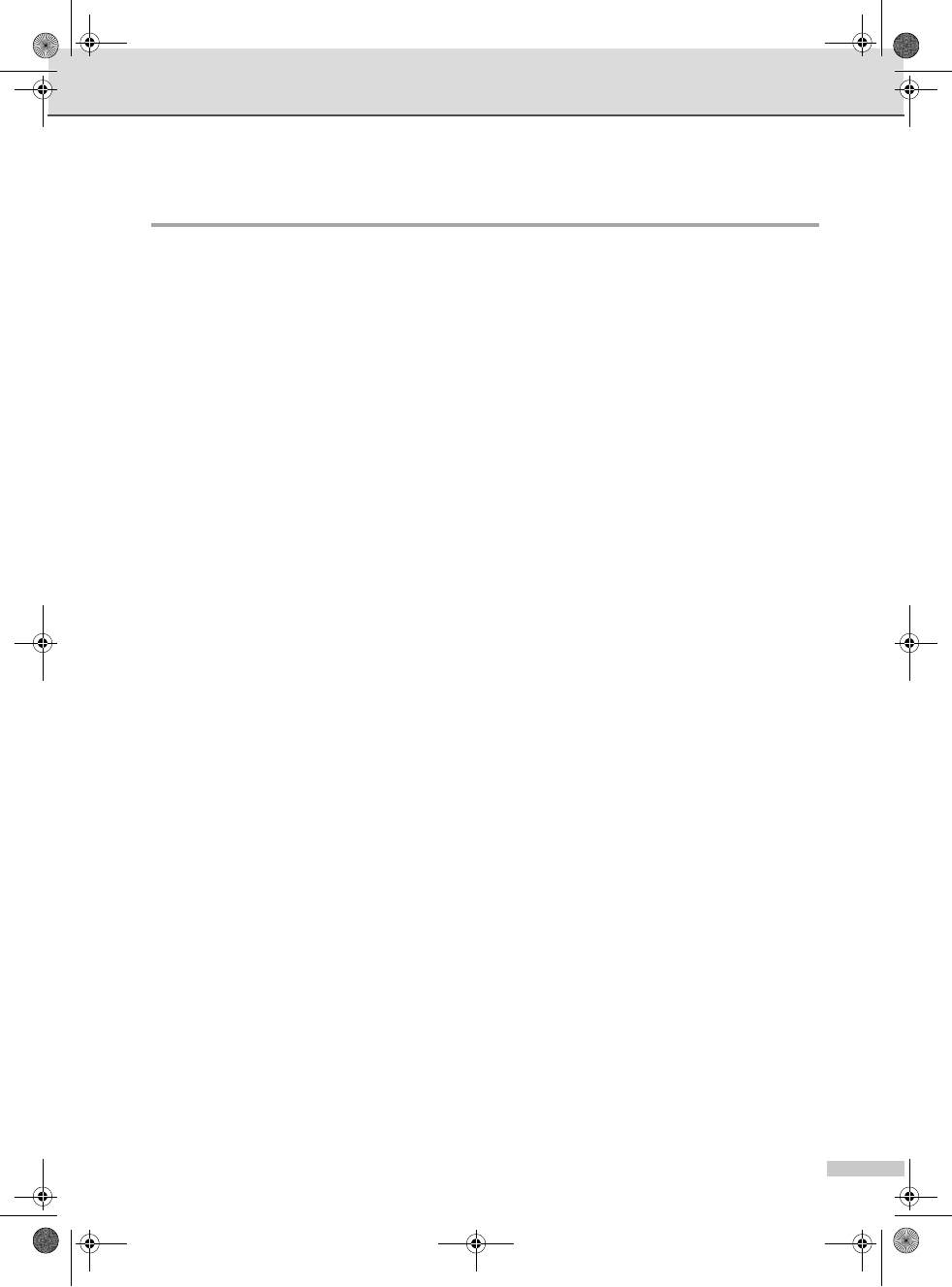
Safety and Legal
129
Trademarks A
The Brother logo is a registered trademark of Brother Industries, Ltd.
Brother is a registered trademark of Brother Industries, Ltd.
Multi-Function Link is a registered trademark of Brother International Corporation.
© 2006 Brother Industries, Ltd. All rights reserved.
Windows and Microsoft are registered trademarks of Microsoft in the U.S. and other countries.
Macintosh and TrueType are registered trademarks of Apple Computer, Inc.
PaperPort is a registered trademark of ScanSoft, Inc.
Presto! PageManager is a registered trademark of NewSoft Technology Corporation.
Microdrive is a trademark of International Business Machine Corporation.
CompactFlash is a registered trademark of SanDisk Corporation.
Memory Stick is a registered trademark of Sony Corporation.
SecureDigital is a trademark of Matsushita Electric Industrial Co. Ltd., SanDisk Corporation and
Toshiba Corporation.
SanDisk is a licensee of the SD and miniSD trademarks.
MultiMediaCard is a trademark of Infineon Technologies and licensed to the MultiMediaCard
Association.
xD-Picture Card is a trademark of Fujifilm Co. Ltd., Toshiba Corporation and Olympus Optical Co.
Ltd.
PictBridge is a trademark.
Memory Stick Pro, Memory Stick Pro Duo, Memory Stick Duo and MagicGate are trademarks of
Sony Corporation.
BROADCOM, SecureEasySetup and the SecureEasySetup logo are trademarks or registerd
trademarks of Broadcom Corporation in the United States and/or other countries.
Each company whose software title is mentioned in this manual has a Software License
Agreement specific to its proprietary programs.
All other brand and product names mentioned in this User's Guide, the Software User's
Guide and the Network User’s Guide are registered trademarks of their respective
companies.
MFC-440CN_UG_US.book Page 129 Thursday, August 10, 2006 6:59 PM
Color:Blac
k
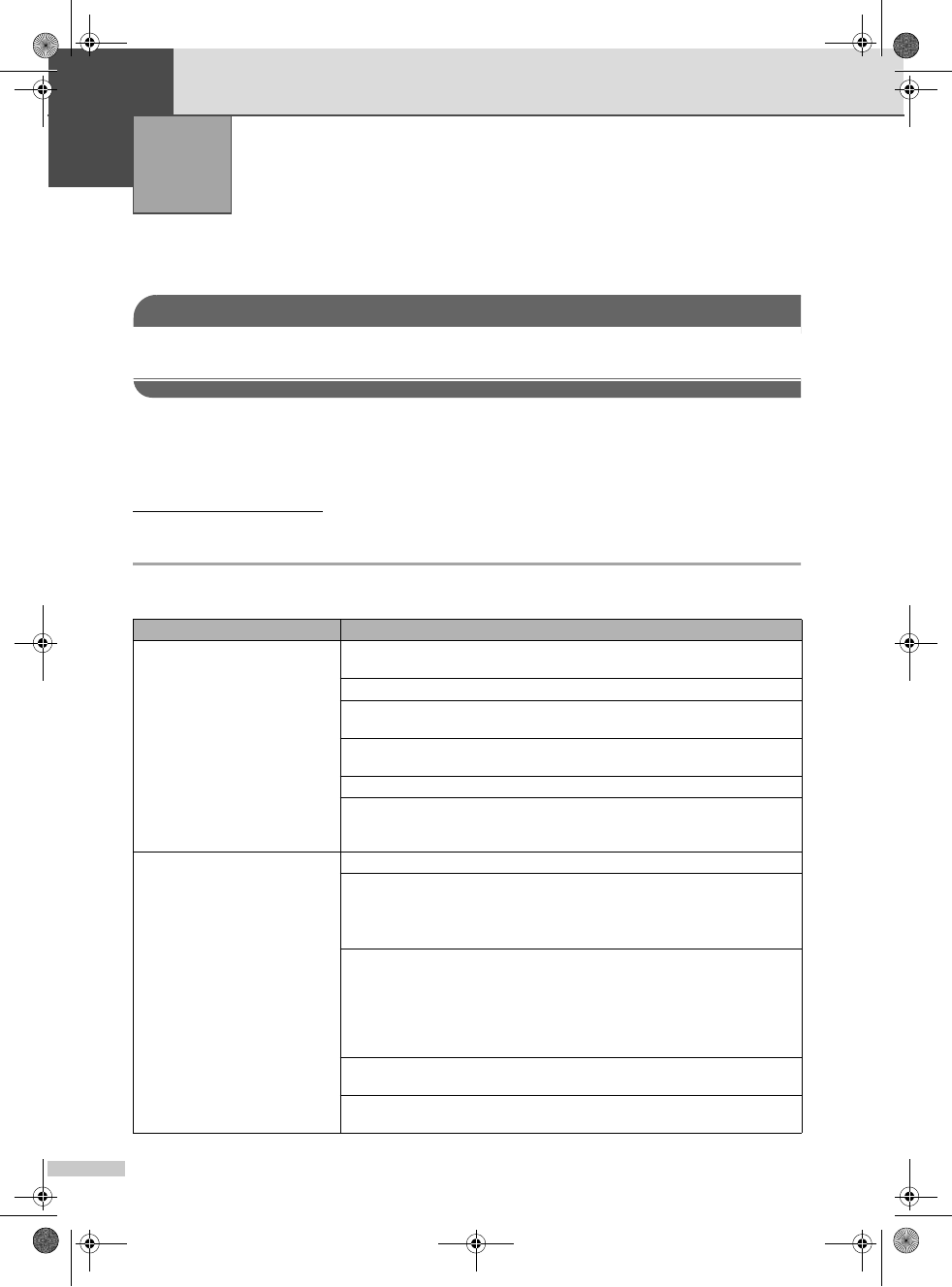
130
B
Troubleshooting B
IMPORTANT
For technical help, you must call the country where you bought the machine. Calls must be made
from within that country.
If you think there is a problem with your machine, check the chart below and follow the
troubleshooting tips.
Most problems can be easily resolved by yourself. If you need additional help, the Brother
Solutions Center offers the latest FAQs and troubleshooting tips. Visit us at
http://solutions.brother.com.
If you are having difficulty with your machine B
Troubleshooting and Routine
Maintenance B
Printing
Difficulty Suggestions
No printout Check the interface cable or wireless connection (MFC-665CW and MFC-845CW
only) on both the machine and your computer. (See the Quick Setup Guide.)
Check that the machine is plugged in and that the On/Off key is on.
One or more ink cartridges are empty. (See Replacing the ink cartridges on
page 143.)
Check to see if the LCD is showing an error message. (See Error messages on
page 136.)
Check that the correct printer driver has been installed and chosen.
Make sure that the machine is online. Click Start and then Printers and Faxes.
Right-click and choose Brother MFC-XXXX (where XXXX is your model name),
and make sure that Use Printer Offline is unchecked.
Poor print quality Check the print quality. (See Checking the print quality on page 148.)
Make sure that the Media Type setting in the printer driver or the Paper Type
setting in the machine’s menu matches the type of paper you are using. (See
Printing for Windows® or Printing and Faxing for Macintosh® in the Software
User’s Guide on the CD-ROM and Paper Type on page 26.)
Make sure that your ink cartridges are fresh. The following may cause ink to clog:
The expiration date written on the cartridge package has passed. (Cartridges
stay usable for up to two years if kept in their original packaging.)
The ink cartridge was in your machine over six months.
The ink cartridge may not have been stored properly before use.
Try using the recommended types of paper. (See Acceptable paper and other
media on page 13.)
The recommended environment for your machine is between 68° F to 91° F (20°
C to 33° C).
MFC-440CN_UG_US.book Page 130 Thursday, August 10, 2006 6:59 PM
Color:Blac
k
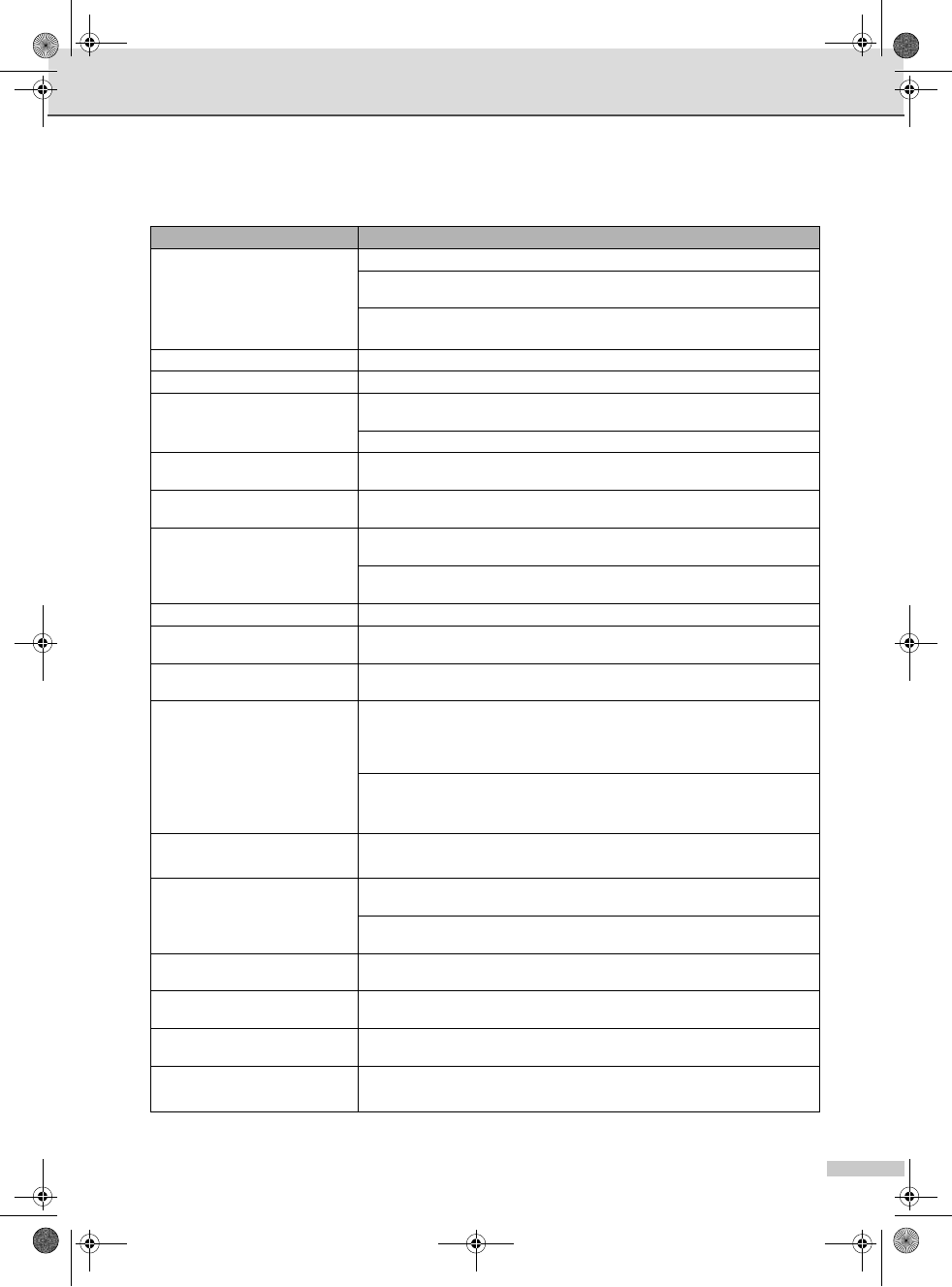
Troubleshooting and Routine Maintenance
131
White horizontal lines appear in text
or graphics.
Clean the print head. (See Cleaning the print head on page 148.)
Try using the recommended types of paper. (See Acceptable paper and other
media on page 13.)
If you want to print on Photo 4"×6" or Photo L 3.5"×5" paper, make sure you use
the photo bypass tray. (See Loading photo paper on page 21.)
The machine prints blank pages. Clean the print head. (See Cleaning the print head on page 148.)
Characters and lines are stacked. Check the printing alignment. (See Checking the printing alignment on page 149.)
Printed text or images are skewed. Make sure the paper is loaded properly in the paper tray and the paper side guide
is adjusted correctly. (See Loading paper and other media on page 17.)
Make sure the Jam Clear Cover is set properly.
Smudged stain at the top center of
the printed page.
Make sure the paper is not too thick or curled. (See Acceptable paper and other
media on page 13.)
Printing appears dirty or ink seems
to run.
Make sure you are using the proper types of paper. (See Acceptable paper and
other media on page 13.) Don't handle the paper until the ink is dry.
Stains appear on the reverse side
or at the bottom of the page.
Make sure the printer platen is not dirty with ink. (See Cleaning the machine printer
platen on page 147.)
Make sure you are using the paper support flap. (See Loading paper and other
media on page 17.)
There are some dense lines. Check Reverse Order in the Basic tab of the printer driver.
The printouts are wrinkled. In the printer driver Basic tab, click Settings, and uncheck Bi-Directional
Printing.
Cannot perform ‘2 in 1 or 4 in 1’
printing.
Check that the paper size setting in the application and in the printer driver are the
same.
Print speed is too slow. Try changing the printer driver setting. The highest resolution needs longer data
processing, sending and printing time. Try the other quality settings in the printer
driver Basic tab. Also, click the Settings tab, and make sure you uncheck Color
Enhancement (True2Life®).
Turn the borderless feature off. Borderless printing is slower than normal printing.
(See Printing for Windows® or Printing and Faxing for Macintosh® in the Software
User’s Guide on the CD-ROM.)
True2Life® is not working properly. If the image data is not full color in your application (such as 256 color), True2Life®
will not work. Use at least 24 bit color data with the True2Life® feature.
Machine feeds multiple pages. Make sure the paper is loaded properly in the paper tray. (See Loading paper and
other media on page 17.)
Check that more than two types of paper are not loaded in the paper tray at any
one time.
Printed pages are not stacked
neatly.
Make sure you are using the paper support flap. (See Loading paper and other
media on page 17.)
Printed pages double feed and
cause a paper jam.
Make sure you pull out the paper support until it clicks and unfold the paper
support flap.
Machine does not print from Paint
Brush. Try setting the Display setting to ‘256 colors.’
Machine does not print from Adobe
Illustrator. Try to reduce the print resolution. (See Printing for Windows® or Printing and
Faxing for Macintosh® in the Software User’s Guide on the CD-ROM.)
Printing (Continued)
Difficulty Suggestions
MFC-440CN_UG_US.book Page 131 Thursday, August 10, 2006 6:59 PM
Color:Blac
k
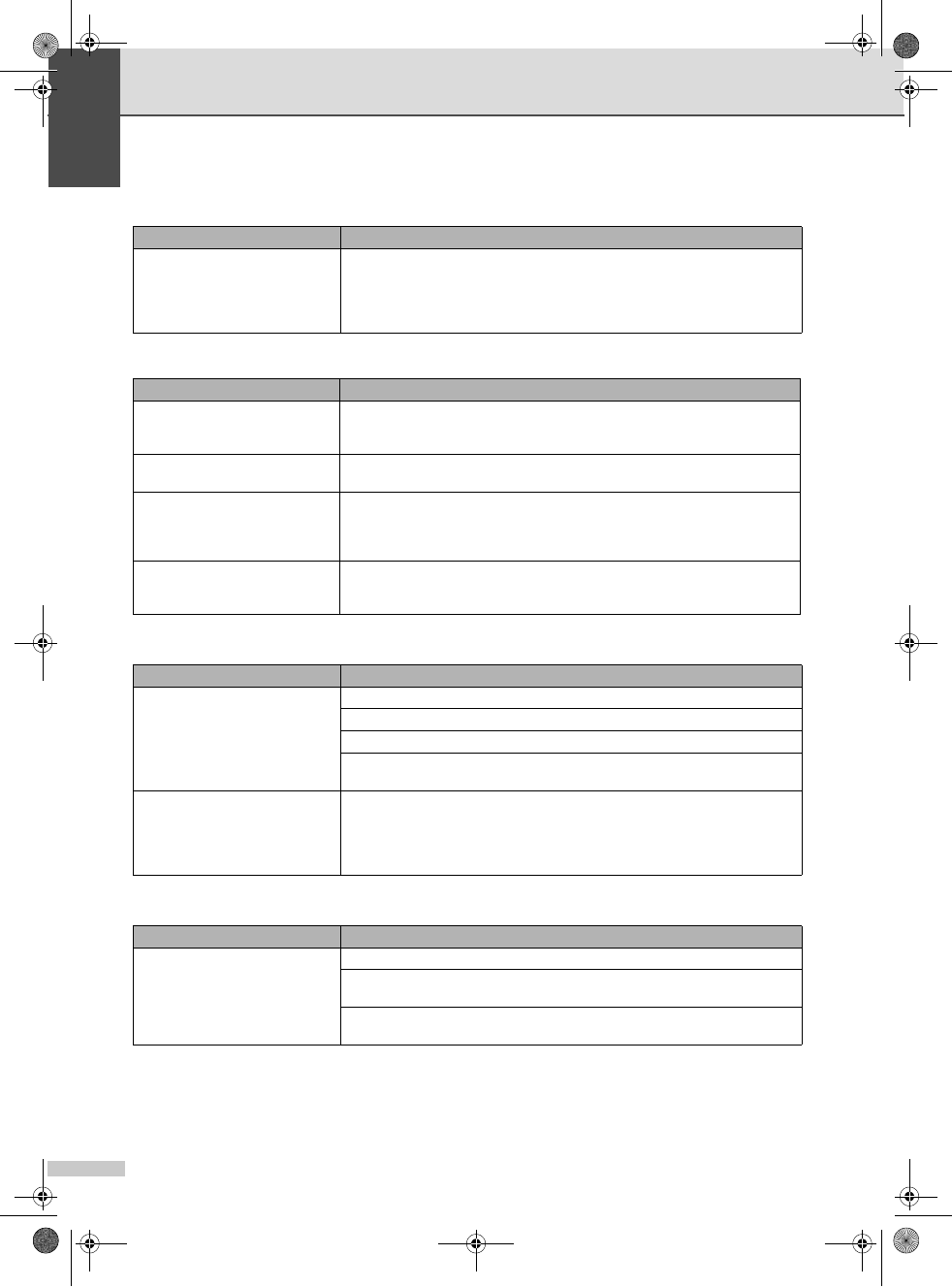
132
Machine cannot print full pages of a
document.
Out of memory message occurs.
Reduce the print resolution. (See Printing for Windows® or Printing and Faxing for
Macintosh® in the Software User’s Guide on the CD-ROM.)
Reduce the complexity of your document and try again. Reduce the graphic
quality or the number of font sizes within your application software.
Printing Received Faxes
Difficulty Suggestions
Condensed print and white streaks
across the page or the top and
bottom of sentences are cut off.
You probably had a bad connection, with static or interference on the telephone
line. Ask the other party to send the fax again.
Vertical black lines when receiving. The sender's scanner may be dirty. Ask the sender to make a copy to see if the
problem is with the sending machine. Try receiving from another fax machine.
Received color fax prints only in
black and white.
Replace the color ink cartridges that are empty or nearly empty, and then ask the
other person to send the color fax again. (See Replacing the ink cartridges on
page 143.) Check that Advanced Fax Operation is set to off. (See Turning off
Advanced Fax Operations on page 81.)
Left and Right margins are cut off or
a single page is printed on two
pages.
Turn on Auto Reduction. (See Printing a reduced incoming fax on page 51.)
Phone Line or Connections
Difficulty Suggestions
Dialing does not work. (No dial
tone)
Check that the machine is plugged in and that the On/Off key is on.
Check all line cord connections.
(Canada only) Change Tone/Pulse setting. (See Quick Setup Guide.)
Send a fax manually and wait to hear the fax receiving tone before you press
Black Start or Color Start. (See Sending a fax manually on page 44)
The machine does not answer
when called.
Make sure the machine is in the correct receiving mode for your setup. (See
Choosing the Receive Mode on page 46.) Check for a dial tone. If possible, call
your machine to hear it answer. If there is still no answer, check the telephone line
cord connection. If there is no ringing when you call your machine, ask your
telephone company to check the line.
Receiving Faxes
Difficulty Suggestions
Cannot receive a fax. Check all line cord connections.
Make sure the machine is in the correct receiving mode for your setup. (See
Receive mode settings on page 49.)
If you often have interference on the phone line, try changing the menu setting of
Compatibility to Basic. (See Phone line interference on page 143.)
Printing (Continued)
Difficulty Suggestions
MFC-440CN_UG_US.book Page 132 Thursday, August 10, 2006 6:59 PM
Color:Blac
k
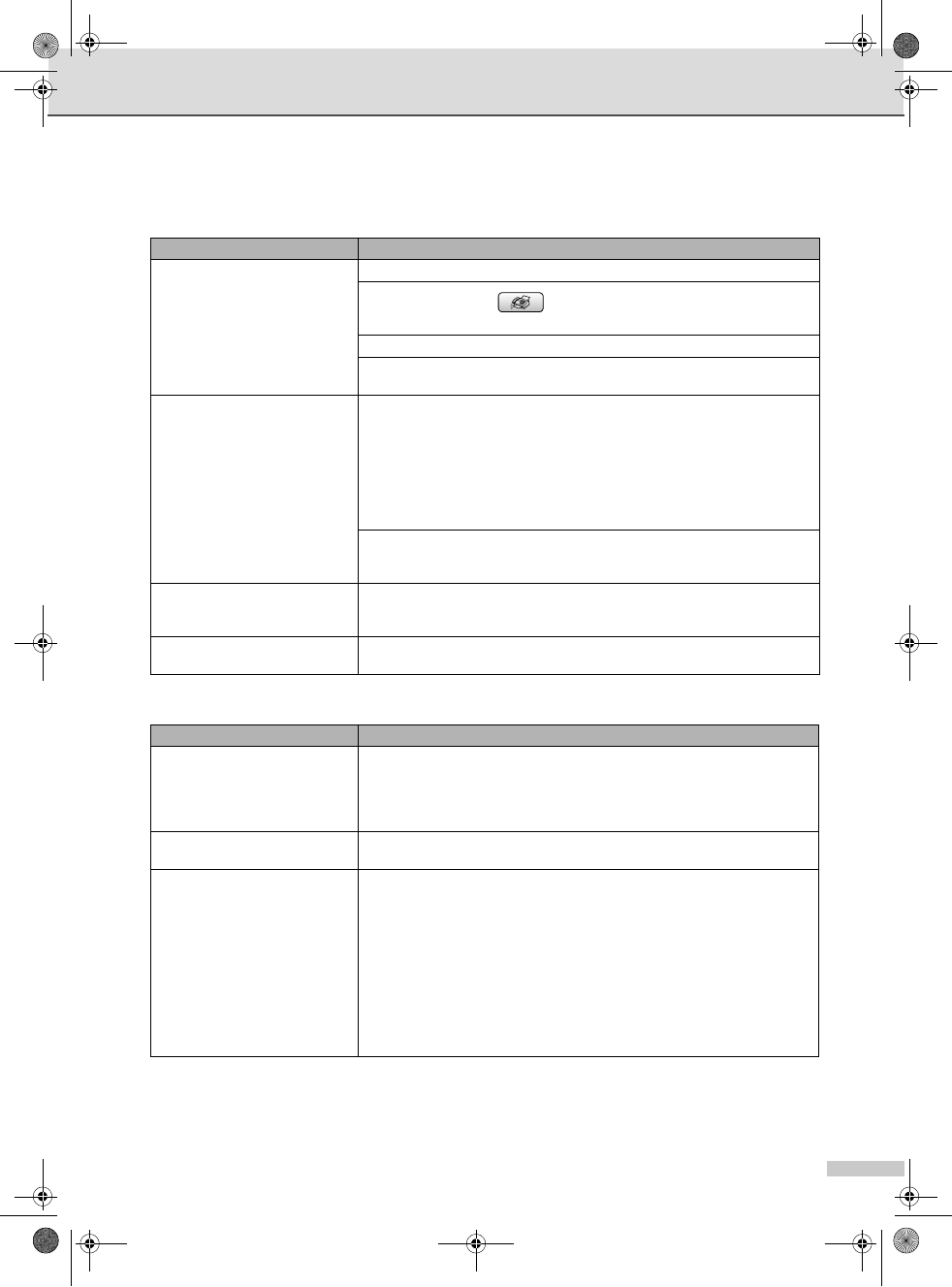
Troubleshooting and Routine Maintenance
133
Sending Faxes
Difficulty Suggestions
Cannot send a fax. Check all line cord connections.
Make sure that the Fax key is illuminated. (See Entering Fax mode on
page 38.)
Ask the other party to check that the receiving machine has paper.
Print the Transmission Verification Report and check for an error. (See Reports on
page 88.)
Transmission Verification Report
says ‘Result:NG’.
There is probably temporary noise or static on the line. Try sending the fax again.
If you send a PC FAX message and get ‘Result:NG’ on the Transmission
Verification Report, your machine may be out of memory. To gain extra memory,
you can turn off Advanced Fax Operation (see Turning off Advanced Fax
Operations on page 81), print fax messages in memory (see Printing a fax from
the memory on page 51) or cancel a Delayed Fax or Polling Job (see Canceling a
fax in progress on page 39). If the problem continues, ask the telephone company
to check your phone line.
If you often get transmission errors due to possible interference on the phone line,
try changing the menu setting of Compatibility to Basic. (See Phone line
interference on page 143.)
Poor fax send quality. Try changing your resolution to Fine or S.Fine. Make a copy to check your
machine's scanner operation. If the copy quality is not good, clean the scanner.
(See Cleaning the scanner on page 146.)
Vertical black lines when sending. If the copy you made shows the same problem, clean the scanner. (See Cleaning
the scanner on page 146.)
Handling Incoming Calls
Difficulty Suggestions
The machine ‘Hears’ a voice as a
CNG Tone.
If Easy Receive is set to on, your machine is more sensitive to sounds. It may
mistakenly interpret certain voices or music on the line as a fax machine calling
and respond with fax receiving tones. Deactivate the machine by pressing
Stop/Exit. Try avoiding this problem by turning Easy Receive to off. (See Easy
Receive on page 50.)
Sending a fax call to the machine. If you answered on an external or extension phone, press your Fax Receive Code
(the factory setting is l 5 1). When your machine answers, hang up.
Custom features on a single line. If you have Call Waiting, Call Waiting/Caller ID, Voice Mail, an alarm system or
other custom feature on a single phone line with your machine, it may create a
problem sending or receiving faxes.
For example: If you subscribe to Call Waiting or some other custom service and
its signal comes through the line while your machine is sending or receiving a fax,
the signal can temporarily interrupt or disrupt the faxes. Brother's ECM feature
should help overcome this problem. This condition is related to the telephone
system industry and is common to all devices that send and receive information
on a single, shared line with custom features. If avoiding a slight interruption is
crucial to your business, a separate phone line with no custom features is
recommended.
MFC-440CN_UG_US.book Page 133 Thursday, August 10, 2006 6:59 PM
Color:Blac
k
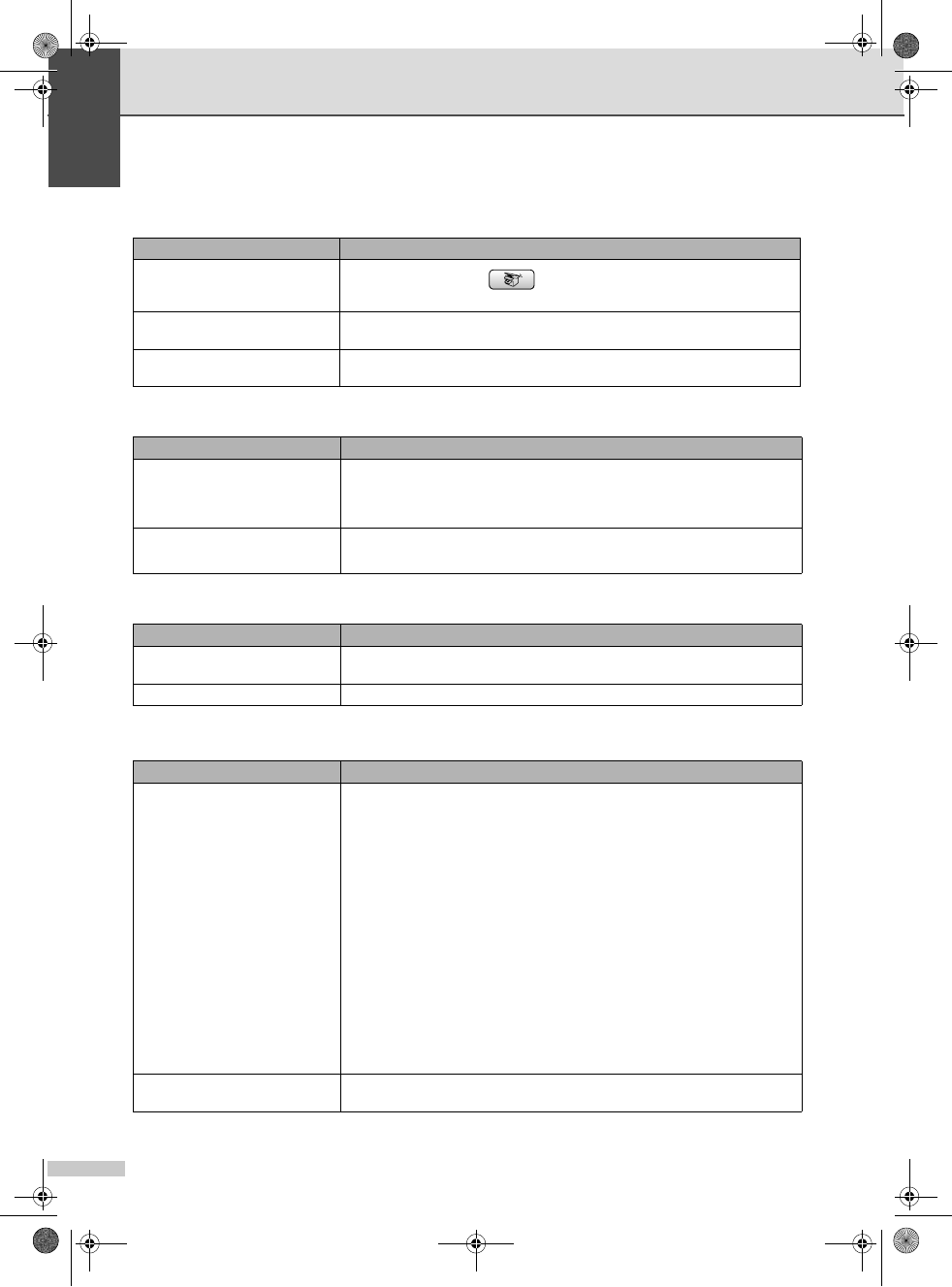
134
Copying Difficulties
Difficulty Suggestions
Cannot make a copy. Make sure that the Copy key is illuminated. (See Entering Copy mode
on page 92.)
Vertical streaks appear in copies. If you see vertical streaks on copies, clean the scanner. (See Cleaning the
scanner on page 146.)
Poor copy results when using the
ADF.
Try using the scanner glass. (See Using the scanner glass on page 12.)
Scanning Difficulties
Difficulty Suggestions
TWAIN/WIA errors appear while
scanning.
Make sure the Brother TWAIN/WIA driver is chosen as the primary source. In
PaperPort® SE with OCR, click File,Scan and choose the Brother TWAIN/WIA
driver.
Poor scanning results when using
the ADF.
Try using the scanner glass. (Using the scanner glass on page 12.)
Software Difficulties
Difficulty Suggestions
Cannot install software or print. Run the Repair MFL-Pro Suite program on the CD-ROM. This program will repair
and reinstall the software.
‘Device Busy’ Make sure the machine is not showing an error message on the LCD.
PhotoCapture Center® Difficulties
Difficulty Suggestions
Removable Disk does not work
properly. 1 Have you installed the Windows® 2000 update? If not, do the following:
1) Unplug the USB cable.
2) Install the Windows® 2000 update, and see the Quick Setup Guide. After
the installation the PC will be automatically restarted.
3) Wait about 1 minute after you restart the PC, and then connect the USB
cable.
2 Take out the media card and put it back in again.
3 If you have tried ‘Eject’ from within Windows®, take out the media card before
you continue.
4 If an error message appears when you try to eject the media card, it means
the card is being accessed. Wait a while and then try again.
5 If all of the above do not work, turn off your PC and machine, and then turn
them on again. (You will have to unplug the power cord of the machine to turn
it off.)
Cannot access Removable Disk
from Desktop icon.
Make sure you have put the media card into the media slot.
MFC-440CN_UG_US.book Page 134 Thursday, August 10, 2006 6:59 PM
Color:Blac
k

Troubleshooting and Routine Maintenance
135
Network Difficulties
Difficulty Suggestions
Cannot print over the Network. Make sure that your machine is powered on and is online and in Ready mode.
Print a Network Configuration list (see Reports on page 88.) and check the current
Network settings printed in this list. Reconnect the LAN cable to the hub to verify
that the cabling and network connections are good. If possible, try connecting the
machine to a different port on your hub using a different cable. If the connections
are good, the machine shows LAN Active for 2 seconds.
(If you are using a wireless connection (MFC-665CW and MFC-845CW only) or
are having Network problems, see the Network User’s Guide on the CD-ROM for
more information.)
The network scanning feature does
not work. (For Windows® users only) A Firewall setting on your PC may be rejecting the
necessary network connection. Follow the instructions below to configure the
Firewall. If you are using a personal Firewall software, see the User’s Guide for
your software or contact the software manufacturer.
<Windows® XP SP2 users>
1 Click the Start button, Control Panel and then Windows Firewall. Make sure
that Windows Firewall on the General tab is set to On.
2 Click Advanced tab and Settings button in Network Connection Settings.
3 Click Add button, and in the "Description of service" field, enter any name. In
the "Name or IP Address" field enter "localhost". In the internal and external
port numbers fields enter "54925" for network scanning. Choose UDP and
click OK. Repeat this step adding Port 54926 for network PC-FAX receiving
and Port 137 for both network scanning and network PC-FAX receiving.
4 Make sure the new settings are added and the box is checked, and then click
OK.
The network PC-Fax Receive
feature does not work.
Your computer cannot find your
machine. <Windows® users>
Firewall setting on you PC may be rejecting the necessary network connection.
For detail, see the instruction above.
<Macintosh® users>
Re-select your machine in the DeviceSelector application located in Macintosh
HD/Library/Printers/Brother/Utilities or from the model of ControlCenter2.
MFC-440CN_UG_US.book Page 135 Thursday, August 10, 2006 6:59 PM
Color:Blac
k